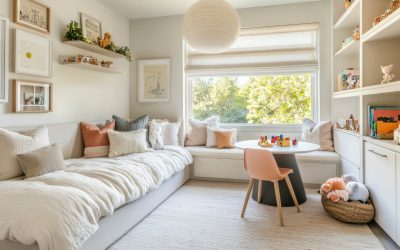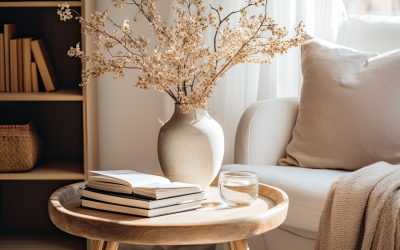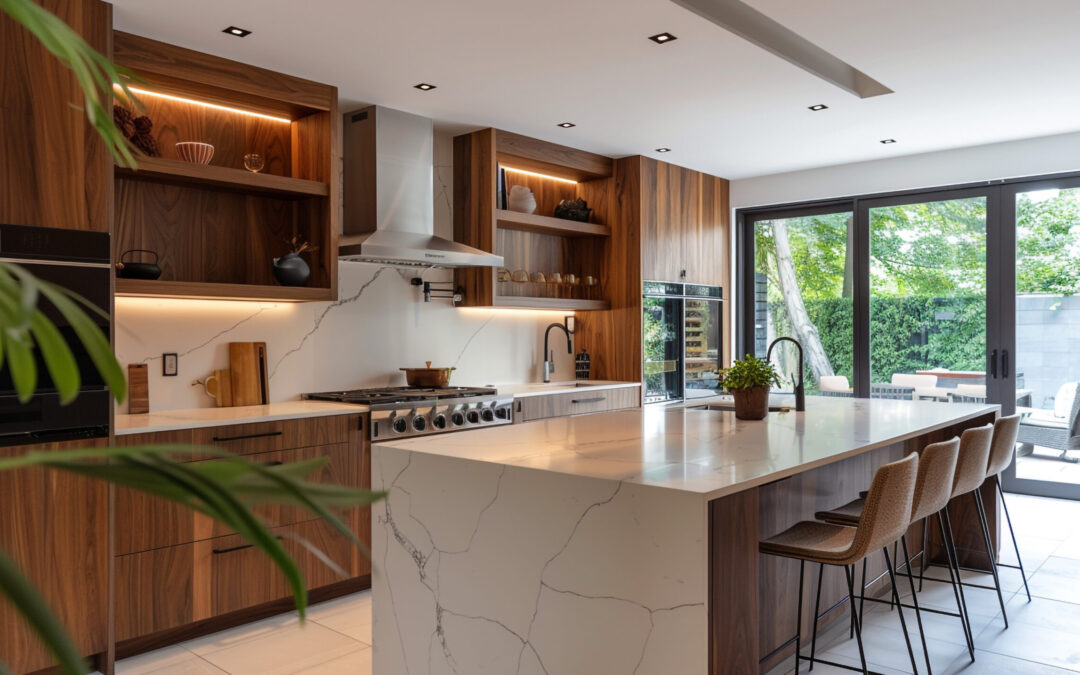
by Kesaa Interiors | DECOR & DIY, Kitchen, Lighting & Accessories, ROOMS
This post is all about Cabinet Light Fixtures.
Good kitchen lighting doesn’t just make your space look nice; it completely transforms how it feels and functions. Among all the design elements that often get overlooked, cabinet light fixtures might be one of the most powerful and practical upgrades you can make. They bring a warm glow to your kitchen, highlight details you’ve carefully chosen, and add a layer of depth that single overhead lighting can miss.
The beauty of well-placed cabinet lighting is that it serves both aesthetic and functional purposes. Whether you’re illuminating a workspace under your cabinets or softly accenting glass-front displays, the right fixtures can instantly elevate your kitchen’s character. And the best part is, you don’t need a complete renovation to make a noticeable impact, just smart lighting choices that suit your style and layout.
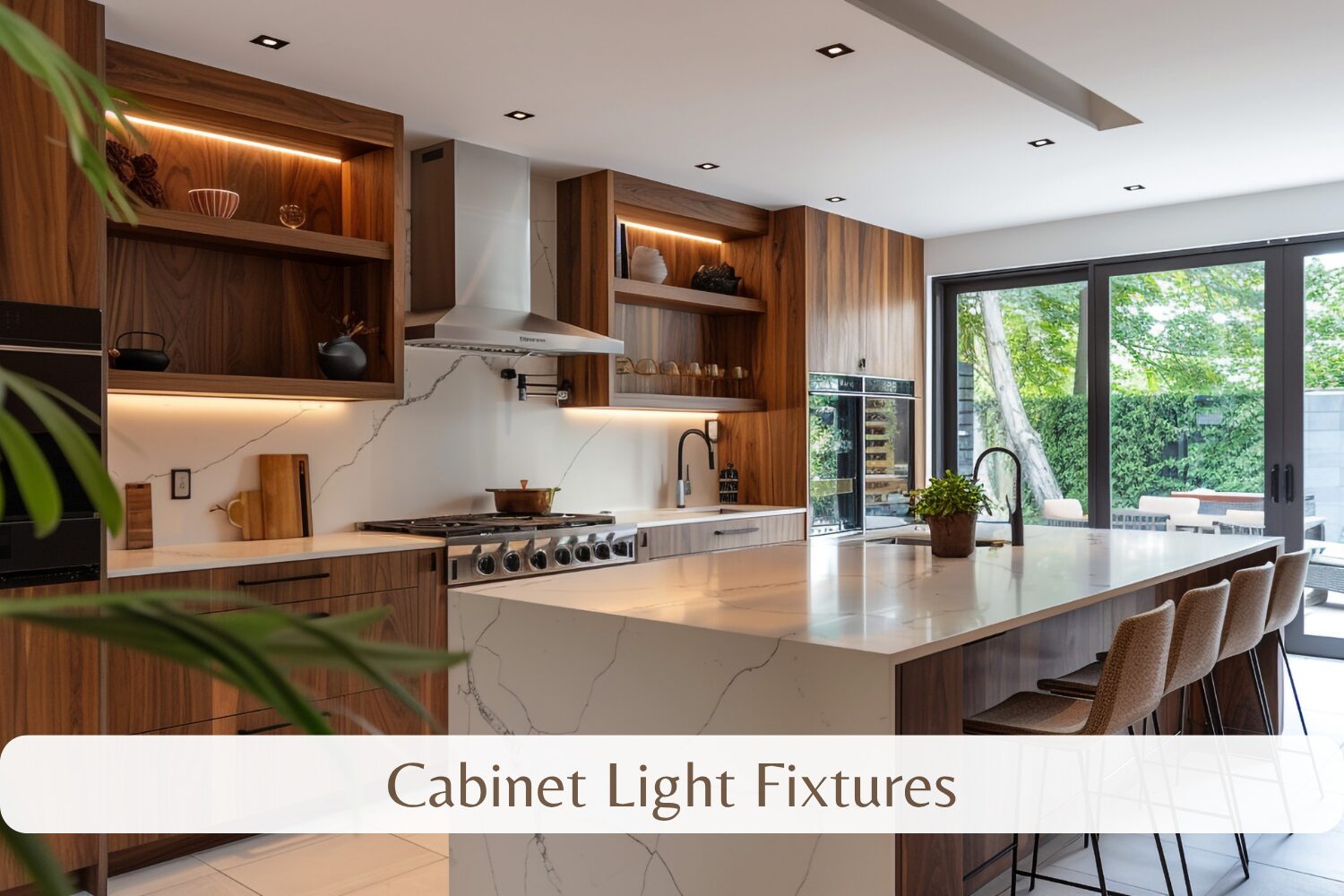
Why Cabinet Light Fixtures Matter in Kitchen Design
Lighting in a kitchen does more than help you see what you’re doing; it defines the atmosphere and adds balance to the space. Cabinet light fixtures in particular create the kind of layered illumination that makes a kitchen feel polished and thoughtfully designed. Good lighting should complement your cabinetry, countertops, and colour palette, not compete with them.
The practical benefits are immediate. Under-cabinet lights eliminate shadows on countertops, making food preparation safer and more comfortable. In-cabinet lights add visibility for dishes and glassware while creating subtle highlights that draw attention to your favourites. Over-cabinet lighting, on the other hand, gives your kitchen depth by creating a gentle glow that can make ceilings appear higher. Collectively, these layers of light work together to add warmth and sophistication without overwhelming the space.
From a design perspective, cabinet lighting also helps create zones within your kitchen. For example, accenting cabinets above a breakfast bar with a soft light can define that area as its own cosy nook. Even small kitchens can benefit from strategically adding cabinet light fixtures, which make the space appear larger and more inviting.
If you think of your kitchen as a canvas, cabinet lighting is what helps the details come alive. It’s not just about brightness; it’s about intention, balance, and how light moves through your space.
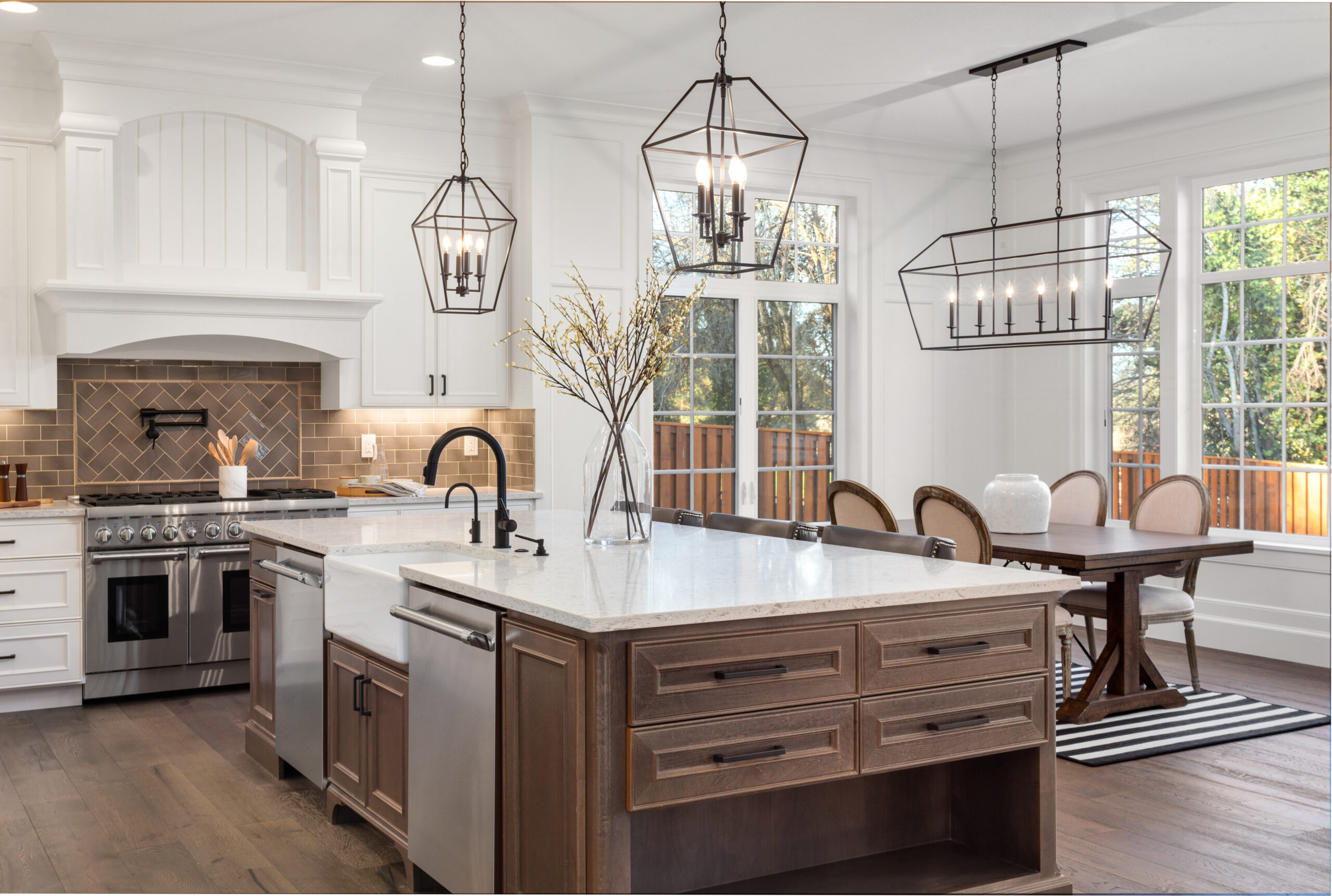
Types of Cabinet Light Fixtures
Choosing the right cabinet light fixtures isn’t only about brightness or cost; it’s about finding the best style and placement for both your kitchen’s design and your daily needs. Every type of fixture serves a slightly different purpose, and when used together, they bring out the full potential of your space. Let’s look at the most common options and how to use them effectively.
1. Under-Cabinet Light Fixtures
These are the most popular options, and for good reason. Under-cabinet lighting provides direct task illumination, perfect for chopping vegetables, reading recipes, or simply creating a clean, inviting workspace.
LED strip lights are sleek and easy to hide beneath upper cabinets, while puck lights offer bright, focused light for smaller areas. If you prefer even, continuous light, linear light bars are excellent for consistent brightness across the whole counter.
From an aesthetic perspective, under-cabinet light fixtures create beautiful contrast, especially if you have darker countertops. The glow softens shadows and highlights the natural tones and textures of your materials.
Pro Tip: Choose LED cabinet light fixtures with adjustable colour temperature so you can switch between warm and cool tones depending on the time of day or the ambience you want.

2. In-Cabinet Light Fixtures
If you have open shelving or glass-front cabinets, in-cabinet lighting adds instant depth and sophistication. It brings attention to the items you love most, whether that’s a collection of glassware or a row of neatly stacked dishes.
Small, low-heat LED puck lights or slim light strips installed along the inside edge or top of your cabinet can provide just enough illumination to highlight what’s inside without being harsh. This is where lighting turns from functional to decorative. These cabinet light fixtures make your kitchen feel curated and thoughtfully layered.
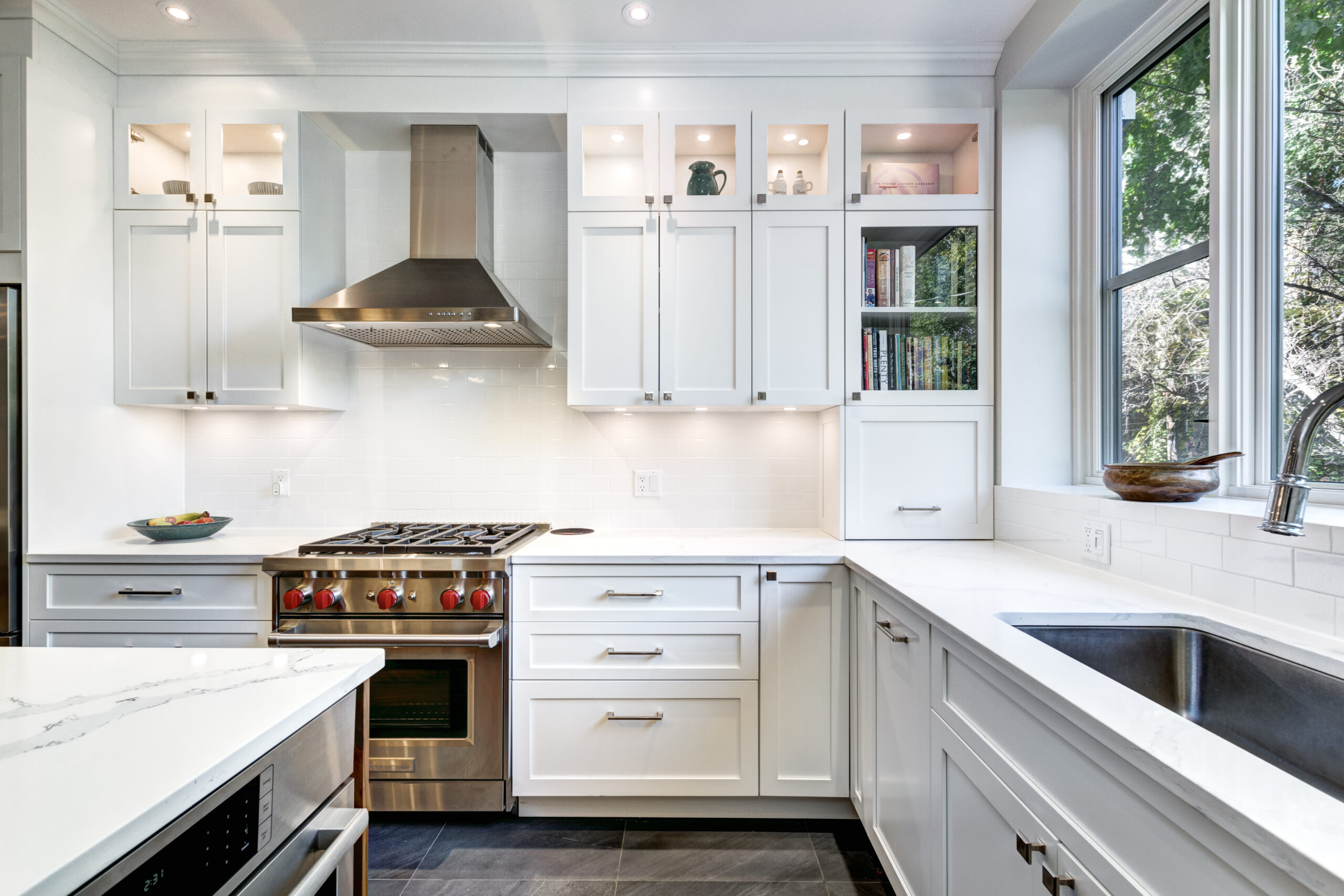
3. Over-Cabinet Light Fixtures
Often underused, over-cabinet lighting provides a soft, ambient glow that bounces off the ceiling and fills the room with warmth. This type of lighting is especially effective in kitchens with tall ceilings; it draws the eye upward and visually expands the space.
Over-cabinet LED light fixtures can also help balance the brightness from other light sources, creating a more even overall tone. It’s subtle but surprisingly transformative, making your kitchen feel cosy in the evening while still maintaining an open and spacious look.
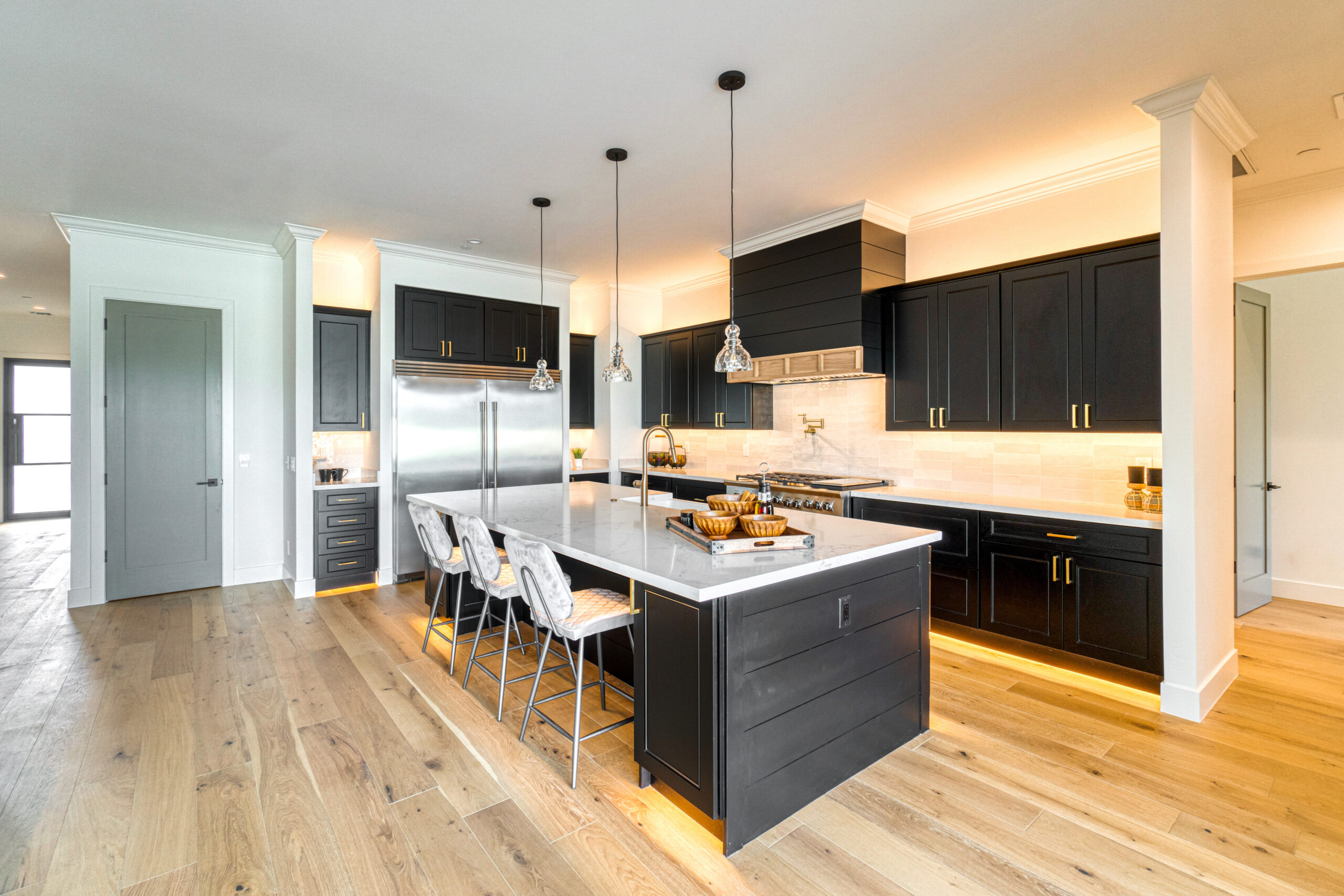
4. Toe-Kick and Base Cabinet Lights
For a modern touch, consider adding lighting along the bottom edge of your base cabinets. Often referred to as toe-kick lighting, this subtle detail helps define the architecture of your kitchen while adding a soft, ambient light source at floor level.
It’s also practical, perfect for late-night walks into the kitchen without turning on bright overhead lights. You can even install motion sensors for hands-free functionality. These cabinet light fixtures might not stand out at first glance, but they contribute significantly to the layered, professional look of a well-lit kitchen.

When used thoughtfully, each of these lighting types adds its own character and function to your kitchen. Combining them allows you to control mood, depth, and practicality. The key is balance, enough light to enhance the atmosphere without overwhelming it.
Choosing the Right Cabinet Light Fixtures for Your Kitchen
Finding the best cabinet light fixtures for your kitchen isn’t just about aesthetics; it’s about making choices that fit your lifestyle, the atmosphere you want, and the way you use your space. The right setup should blend seamlessly into your design, providing function without stealing attention. Here’s how to narrow down your options thoughtfully.
1. Start with Purpose and Placement
Before you buy anything, think about why you want cabinet lighting. Is it mainly for task lighting on countertops? To add depth and mood to the room? Or to highlight decorative features inside glass cabinets?
Each purpose points to a slightly different fixture type. For instance, if you often cook at night or early in the morning, under-cabinet lights are essential. If your kitchen doubles as an entertaining space, accent lighting, like over-cabinet or in-cabinet fixtures, adds that inviting glow.
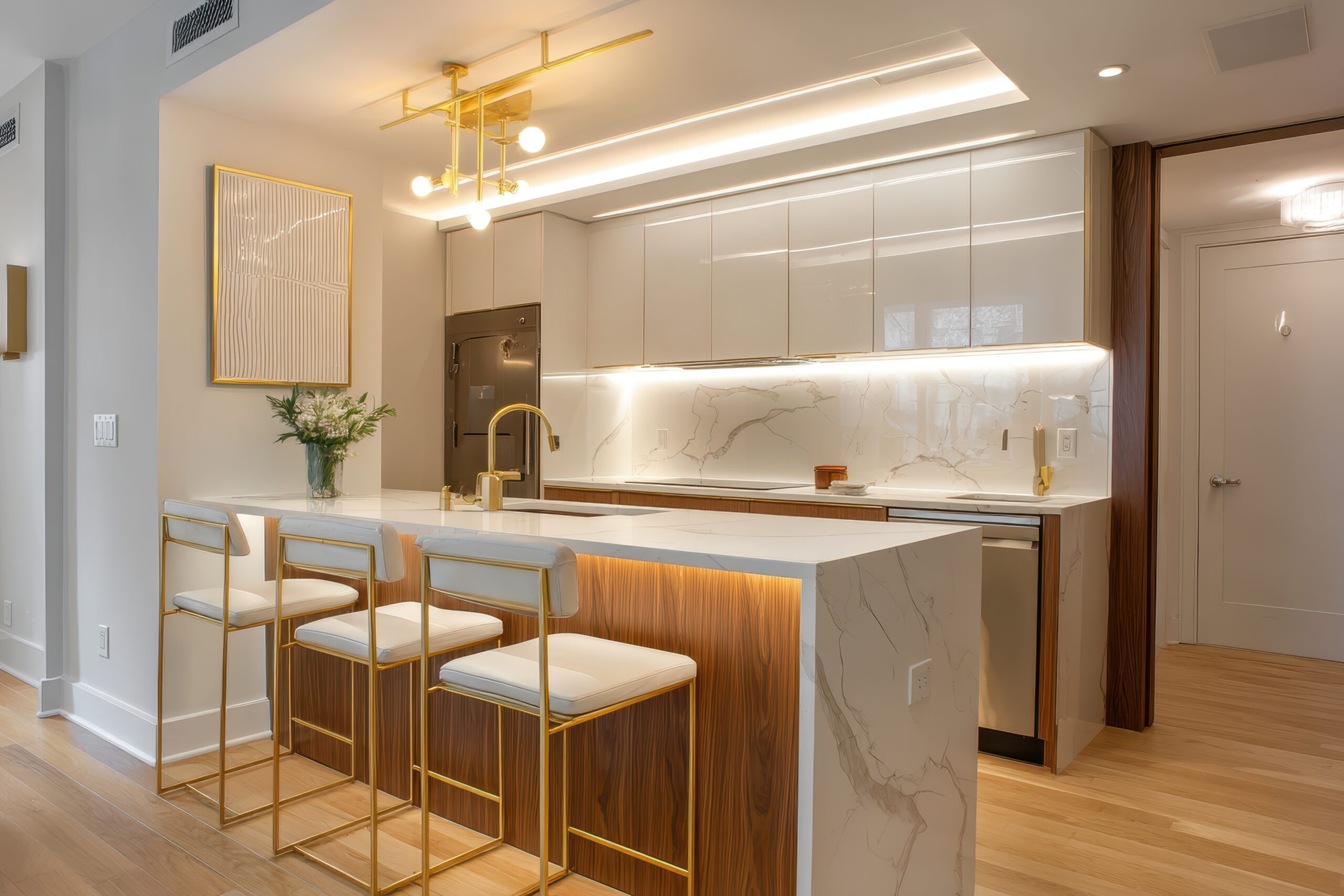
2. Choose the Right Brightness and Colour Temperature
Light colour and intensity completely change the mood of a kitchen. Warm white tones (2700K–3000K) create a cosy, welcoming atmosphere, while cool white tones (4000K–5000K) look cleaner and more contemporary, great for modern kitchens with glossy finishes.
If you want flexibility, consider dimmable or colour-adjustable LED cabinet light fixtures. These allow you to shift the tone throughout the day, from bright task lighting to softer evening ambience.
3. Think About Energy Efficiency and Longevity
LEDs are the go-to for cabinet light fixtures because they’re long-lasting, energy-efficient, and produce minimal heat. This makes them safe for enclosed or small areas and ideal for kitchens where lights may stay on for extended periods.
Beyond saving energy, LEDs also hold their brightness and colour consistency much longer than halogen or fluorescent options, which means fewer replacements and less maintenance.
4. Integrate Smart Lighting Features
Smart home technology isn’t just for gadgets; it’s become a meaningful part of interior design. You can now install smart cabinet light fixtures that connect to Wi-Fi or home assistants, letting you adjust brightness or colour through voice commands or apps.
If wiring feels intimidating, look for rechargeable or plug-in versions controlled remotely. The key is convenience and adaptability, lighting that fits seamlessly into your routine.

5. Make Sure It Matches Your Design Aesthetic
Every kitchen has a personality. Sleek brushed metal fixtures fit perfectly in a modern space, while small, round puck lights with a warm glow may suit a classic or farmhouse-inspired design better.
Try to match the finish of your cabinet light fixtures with your cabinetry hardware or faucet for a cohesive look. It’s a subtle detail, but those are often what make a room feel well thought out.
6. Plan for Installation Practicalities
Not all fixtures require complicated wiring. Adhesive LED strips, low-voltage plug-ins, or battery-operated lights can make installation quick and renter-friendly. If you plan to hardwire your lights, always ensure proper electrical safety or hire a professional installer.
When planning placement, prioritise even light distribution. Avoid dark corners or overly bright spots that draw attention for the wrong reason. The goal is to enhance, not distract.
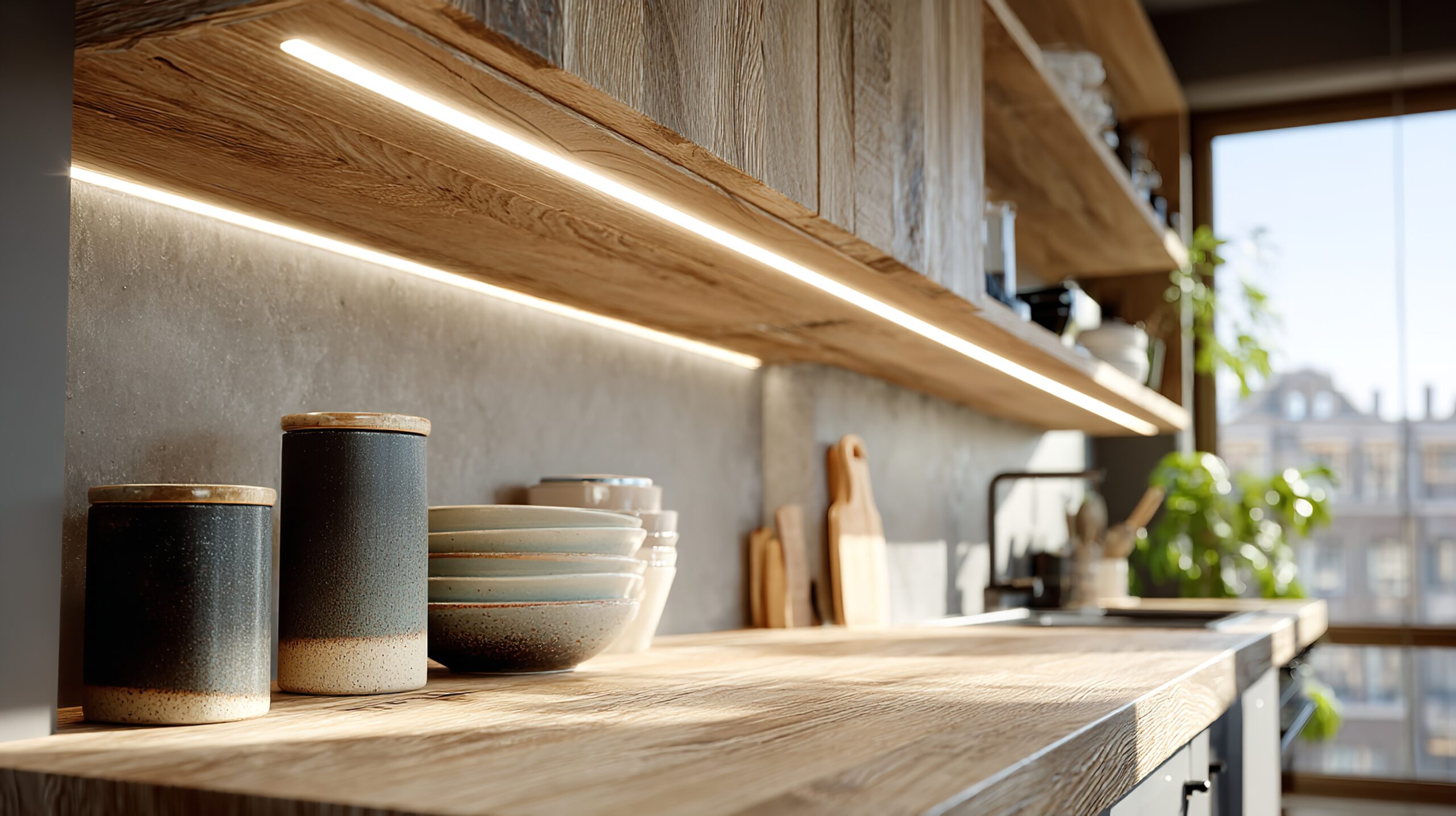
Selecting cabinet lighting might seem like a small detail compared to selecting countertops or appliances, but it contributes enormously to the overall feel of your kitchen. Thoughtful cabinet light fixtures add not only brightness but also balance, warmth, and depth, the finishing touch that turns a functional room into a designed space.
Installation and Placement Tips
Once you’ve chosen your cabinet light fixtures, the next step is all about positioning and installation. Lighting placement determines how well your kitchen is illuminated, how comfortable it feels to use, and how visually balanced the space looks overall. The goal is to create functional lighting that feels effortless, where everything is well-lit but nothing looks harsh or misplaced.
1. Plan Lighting Placement Before Installation
Think of lighting in layers. Before installing anything, take a few minutes to stand in your kitchen during different times of day and see where shadows naturally fall. This helps identify the spots that truly need more light—often under upper cabinets, in corner prep areas, or under floating shelves.
Under-cabinet lights should be mounted toward the front edge of the cabinet bottom, not in the centre. This placement ensures the light spreads evenly across the countertop without casting unwanted shadows from the cabinet face.
Over-cabinet light fixtures should sit close enough to the wall or ceiling to produce an even wash of light rather than a harsh, directional beam. If you’re using strip lights, try installing them at a slight angle so they distribute light smoothly upward.
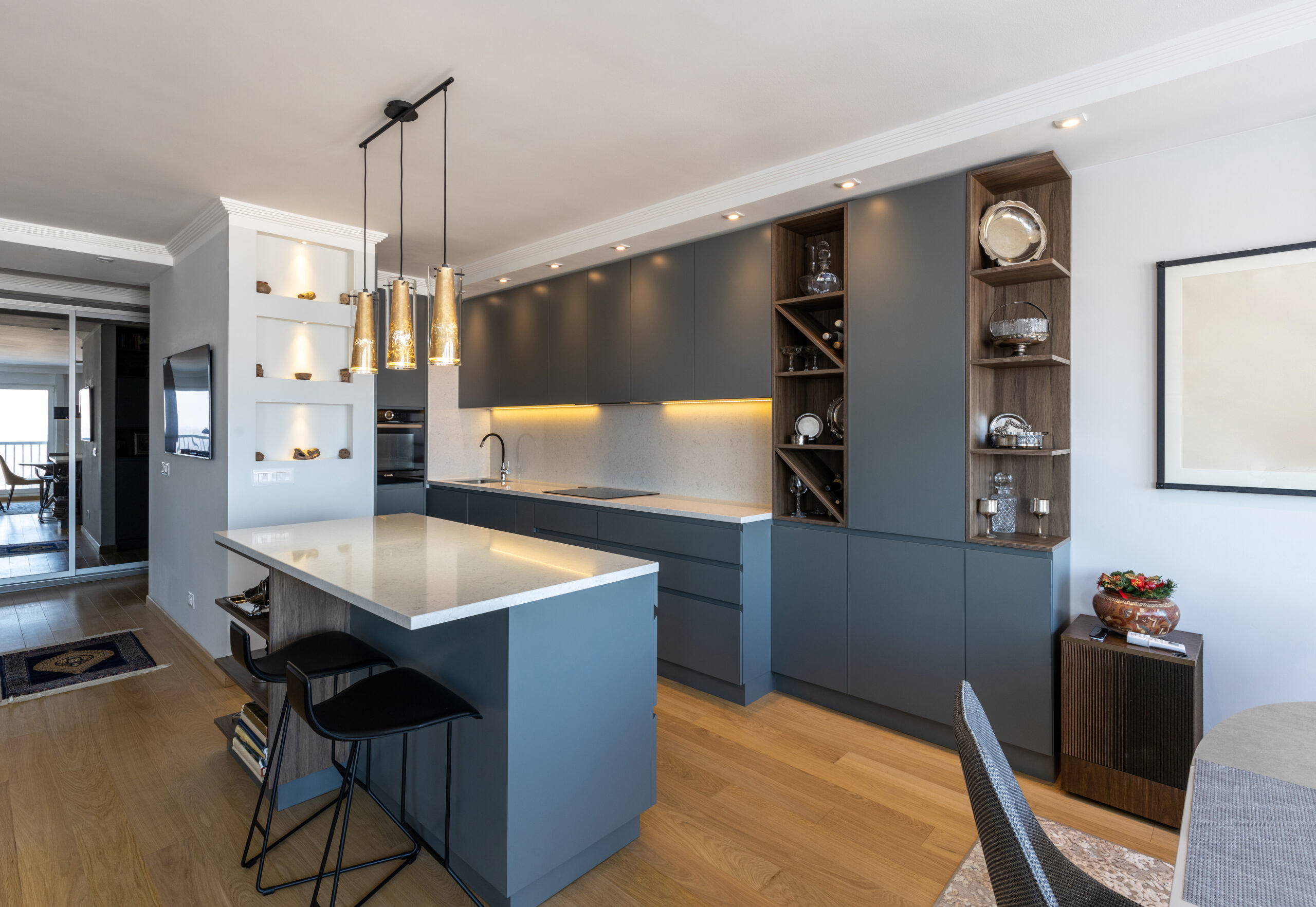
2. Choose the Right Power Source for Your Setup
There are three main ways to power cabinet light fixtures: hardwired, plug-in, and battery-operated.
- Hardwired lighting provides the cleanest look since there are no visible cords. It’s a great choice for a permanent upgrade, especially during remodels.
- Plug-in fixtures are perfect for DIY installations. Just make sure there’s an accessible outlet behind or under your cabinets.
- Battery-operated fixtures are ideal for renters or smaller accent areas, particularly when you want to avoid running wires.
For even greater flexibility, consider cabinet light fixtures with rechargeable batteries and motion sensors; they’re easy to maintain and energy-efficient.

3. Think About Light Layering and Balance
Lighting should never come from just one direction. When you layer lighting, using a mix of under-cabinet, in-cabinet, and over-cabinet fixtures, you bring dimension to your space and eliminate the flatness that a single overhead source can create.
For example, pairing under-cabinet task lights with over-cabinet ambient lights softens transitions between surfaces and reduces visual clutter. Don’t be afraid to mix warm and neutral white tones either; a balanced combination prevents your kitchen from feeling too sterile or too dim.
Pro Tip: For a seamless look, keep all cabinet light fixtures on the same brightness scale or connect them to a dimmer switch for easy adjustment.
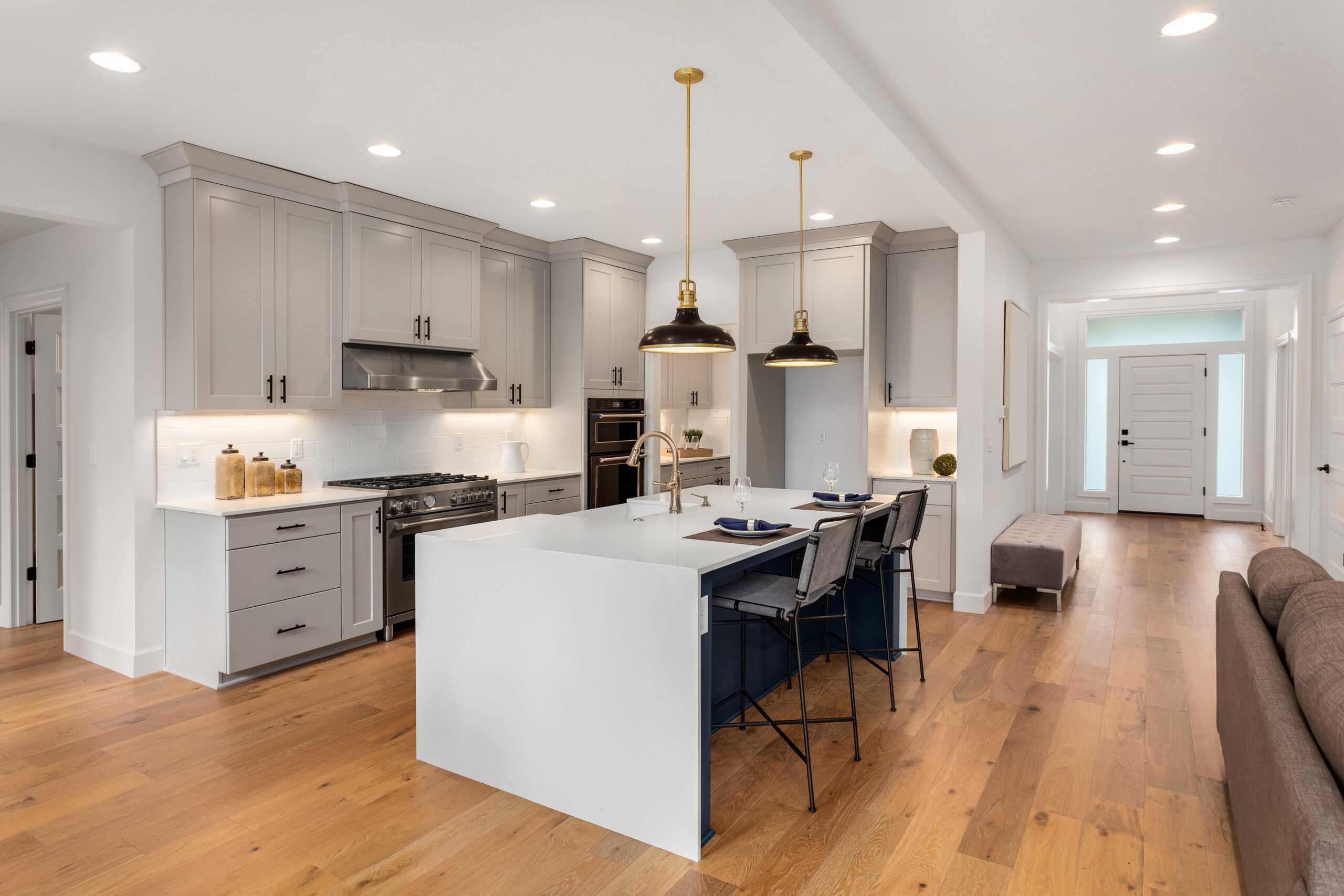
4. Prioritise Safety and Clean Finishing
If you’re opting for a wired setup, ensure cords and transformers are properly hidden or secured behind cabinetry. Cable management clips and channels help maintain a clean look and protect wires from moisture or heat exposure.
Avoid placing lights too close to appliances that produce steam or heat, like stovetops, to prevent damage or discolouration. And if your lighting connects to existing circuits, double-check the load capacity or consult an electrician to avoid overloading.
It might sound meticulous, but proper wiring and tidy cable management make your cabinet light fixtures look intentionally designed, not like an afterthought.

5. Fine-Tune After Installation
Once everything is installed, take time to observe your kitchen lighting both day and night. Look at how shadows shift, how the lights reflect off surfaces, and whether any areas feel too dim or too bright.
Small adjustments, like repositioning a light bar or choosing warmer LEDs, can make a big difference. Remember, cabinet lighting should enhance your kitchen’s natural beauty, not overpower it.
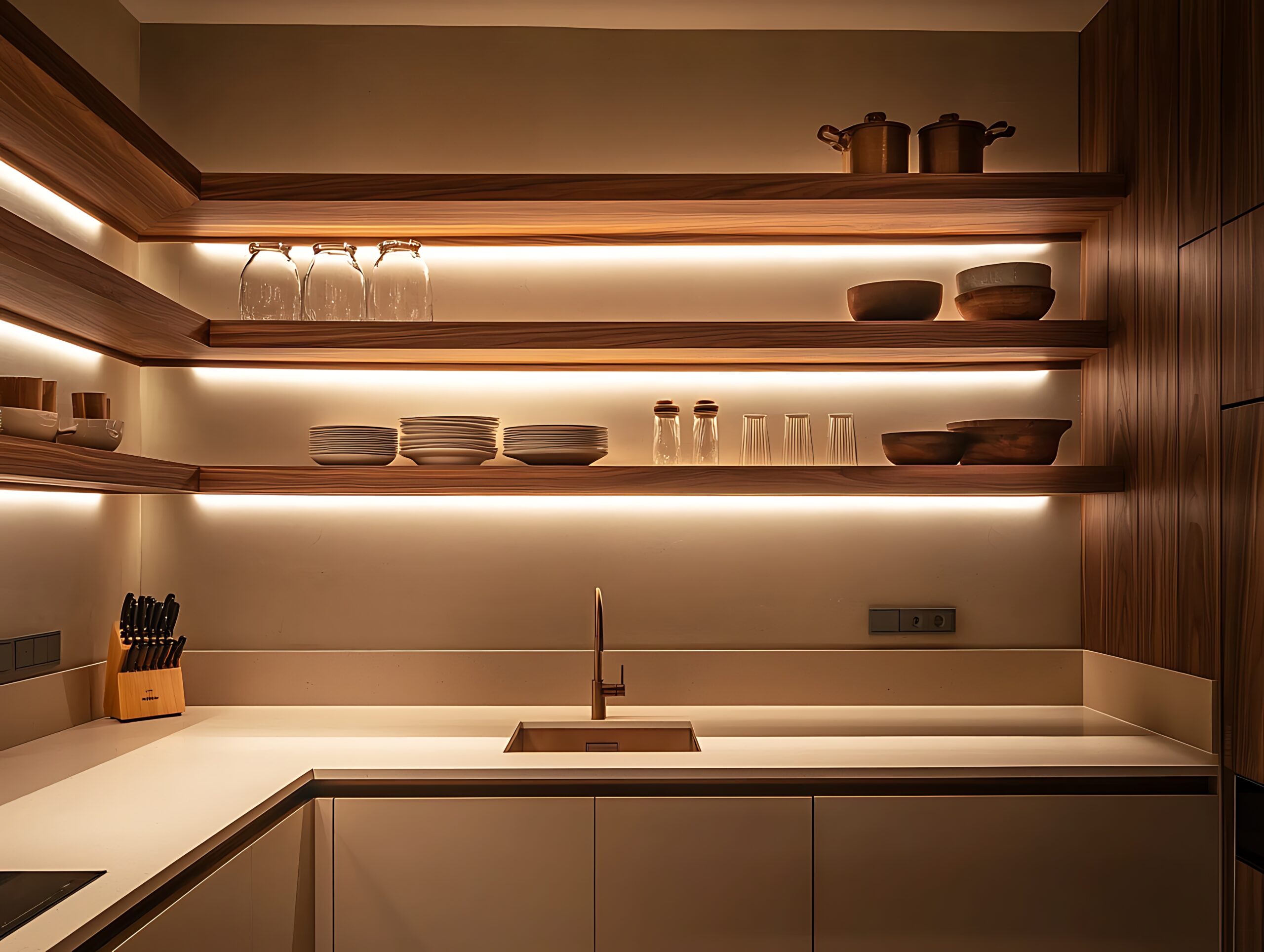
Thoughtful installation is where your cabinet light fixtures truly come to life. When done right, they’ll blend so seamlessly into the design that visitors might not even notice them at first, but they’ll definitely notice how beautiful and balanced your kitchen feels.
Styling Inspiration and Design Ideas
Cabinet light fixtures do far more than illuminate a workspace; they define atmosphere, highlight texture, and add personality. Whether your kitchen is minimal and modern or cosy and traditional, lighting helps express that style with subtle precision. This section explores creative and practical ways to use cabinet lighting as a design feature, not just a functional tool.
1. Modern and Minimalist Kitchens
In modern kitchens, streamline everything, including light. Slim LED strips or recessed linear fixtures emphasise clean lines and flat surfaces, keeping the look sharp and simple. Use cool or neutral white tones to highlight sleek finishes like glossy cabinets, stainless steel, or matte quartz countertops.
To keep the look elegant rather than sterile, balance your cooler under-cabinet light with a warm ambient glow above your cabinets. It softens the transition between hard surfaces and brings warmth back into the space.
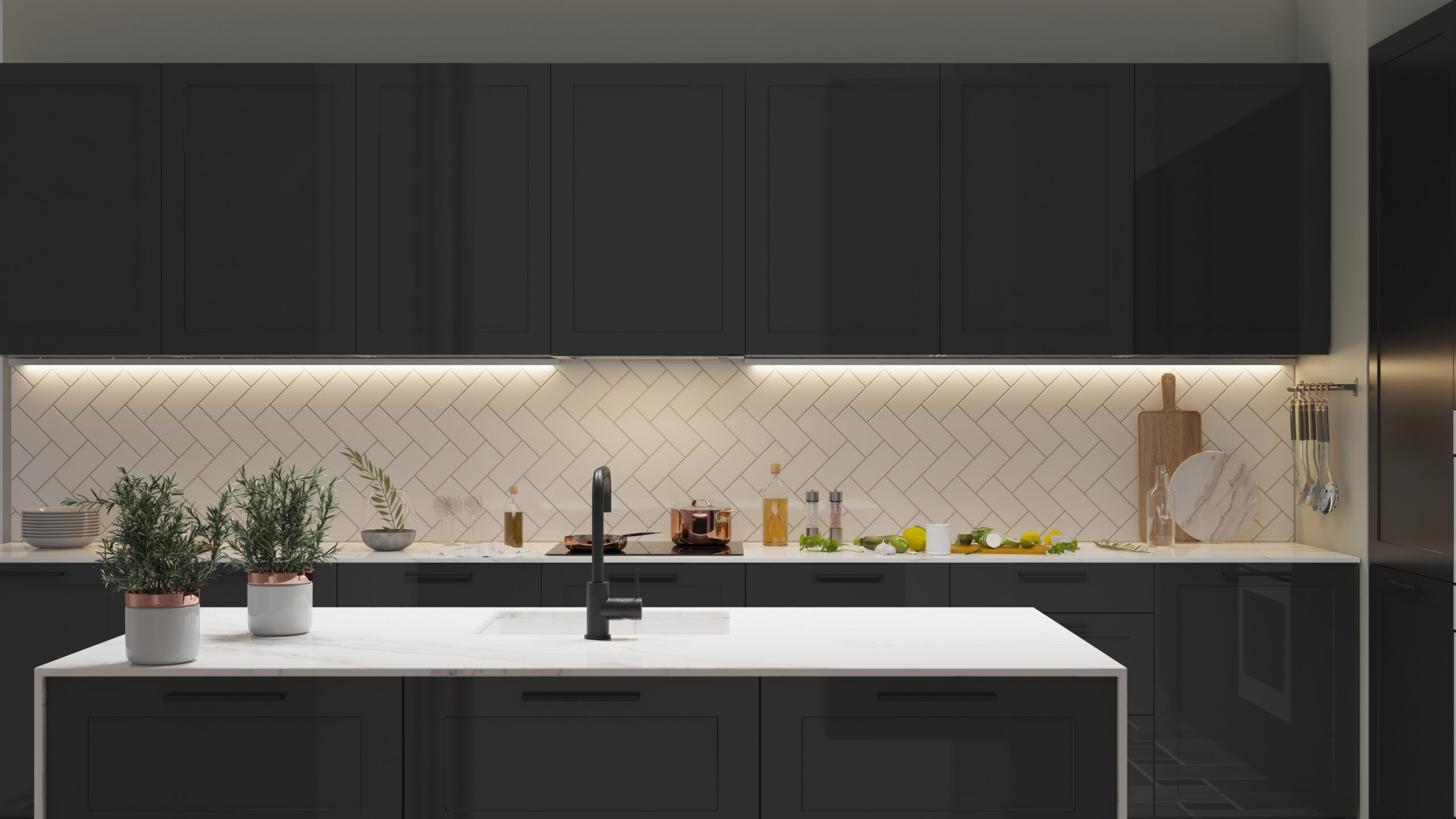
2. Rustic or Farmhouse-Inspired Kitchens
For farmhouse and rustic styles, cabinet light fixtures can play a key role in showcasing texture. Aim for warm-toned LEDs that bring out the richness of wood grain, brick, or stone backsplashes.
Opt for in-cabinet or under-shelf lights that gently wash your cabinetry rather than creating sharp points of light. Vintage-style fixtures or subtle bronze finishes can complement exposed beams and reclaimed wood materials beautifully.
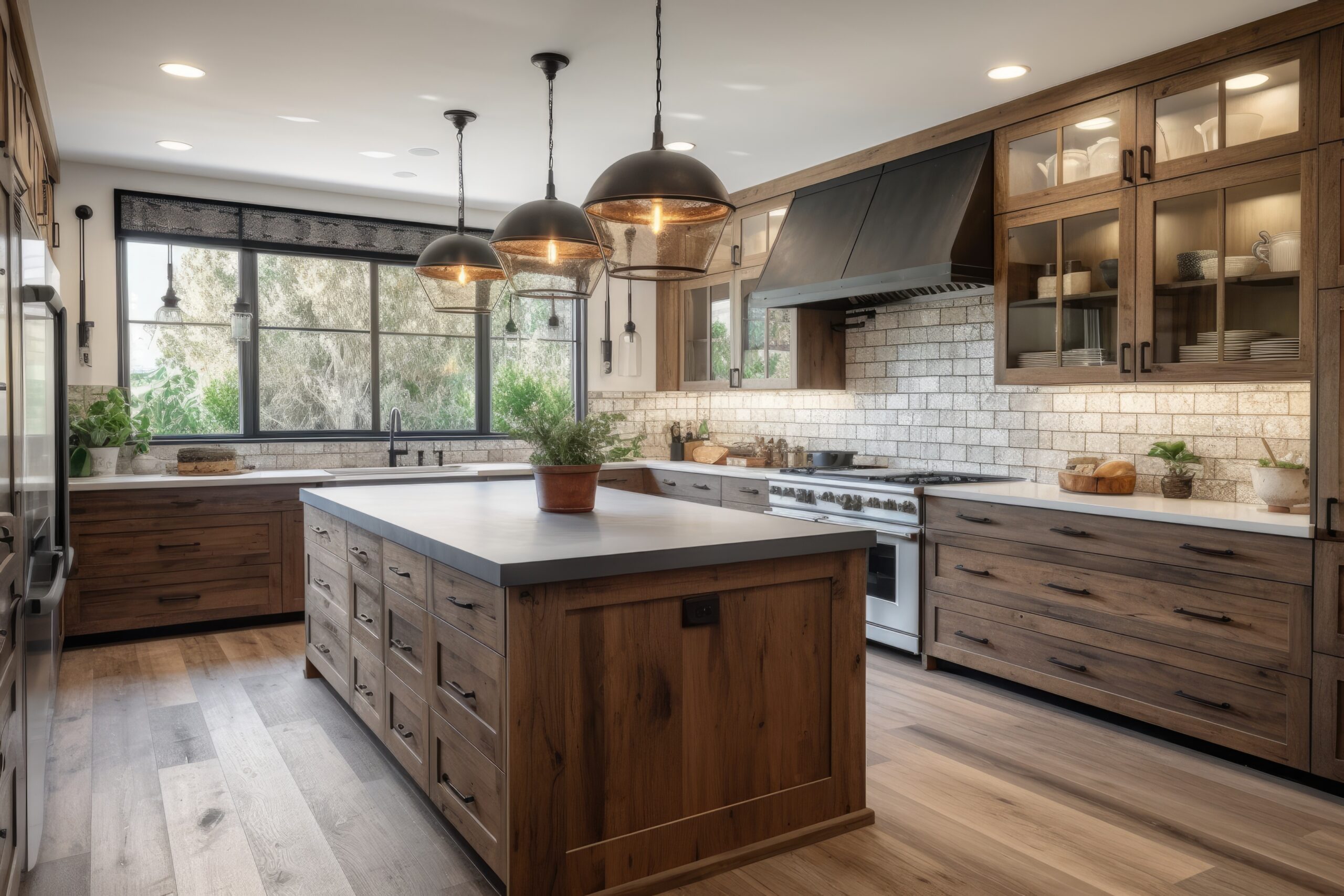
3. Transitional and Classic Kitchens
A transitional kitchen balances elegance with practicality. Here, lighting should feel timeless and integrated. Use soft, neutral white cabinet light fixtures under upper cabinets paired with in-cabinet lighting that showcases glass-front displays or decorative dishes.
This type of layered light adds dimension to the space while remaining subtle. The result: a kitchen that feels elevated, not overdesigned.
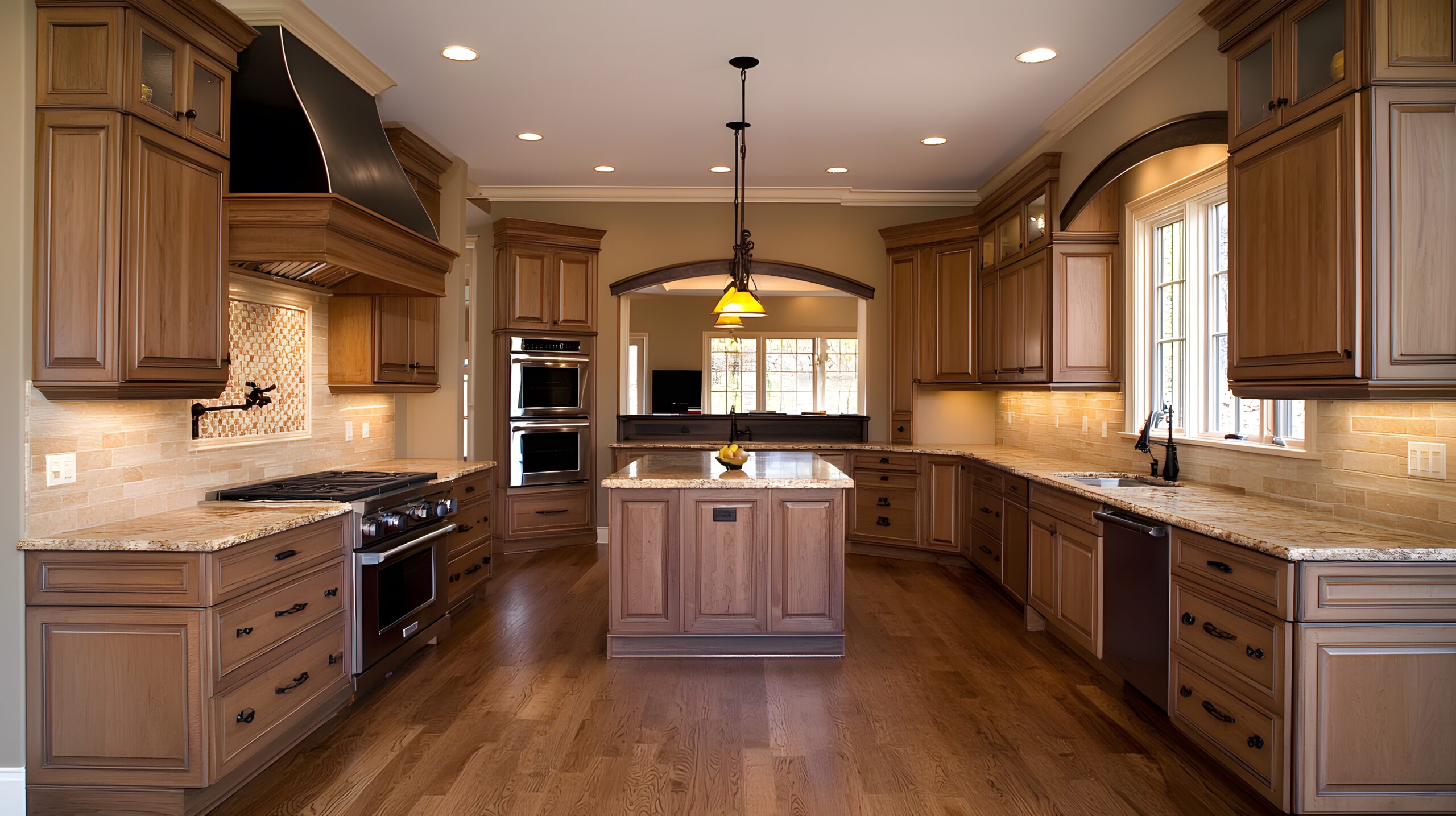
4. Small Kitchen Solutions
Lighting becomes even more important in compact kitchens. Cabinet light fixtures can visually expand tight spaces by reducing shadows and revealing depth in corners.
If your kitchen lacks natural light, try daylight-mimicking LEDs (around 3500K–4000K colour temperature) to brighten the room without feeling harsh. For maximum visual impact, run continuous LED strips under cabinets and along the toe-kick line. This draws the eye across the full width of the room and makes it appear wider.
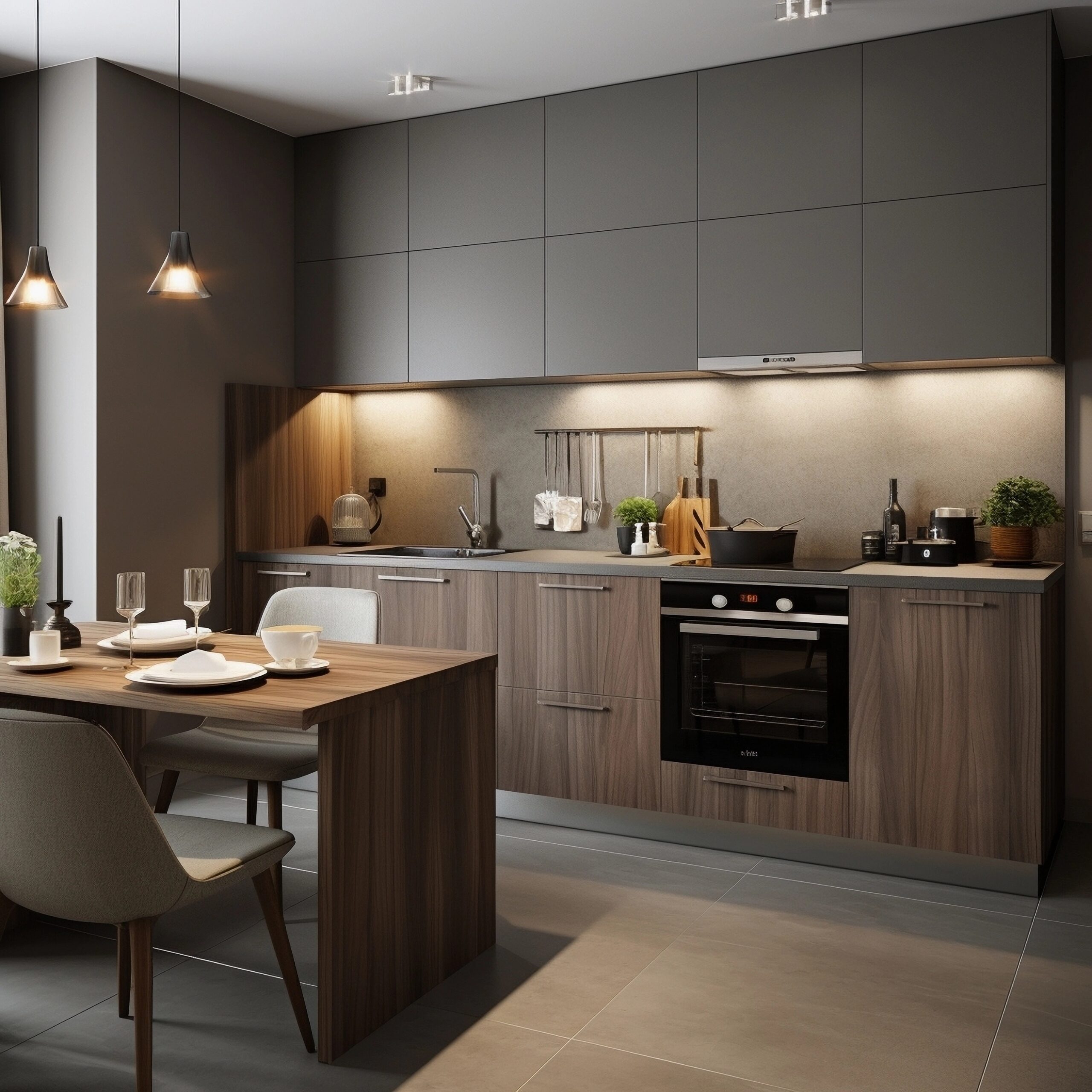
5. Statement Lighting for Contemporary Designs
If you lean toward bolder, design-forward interiors, use your cabinet lighting as a creative accent rather than a background element. Consider RGB LEDs that subtly shift tone or hue for different moods, soft amber for evening, crisp white for daytime, or even a muted colour wash during gatherings.
Pair these cabinet light fixtures with reflective surfaces like glass, tile, or lacquered finishes to amplify depth and motion in your design.

6. Seasonal or Occasion-Based Lighting
Cabinet lighting can be playful too. Dimmable and adjustable colour-temperature LEDs allow you to change your kitchen’s vibe instantly. During the holidays, slightly warmer tones create a cosy feel for gatherings. For summer dinners, cooler light keeps things crisp and fresh.
If you entertain frequently, under-cabinet and in-cabinet lights can double as ambient mood lighting, no extra décor necessary.
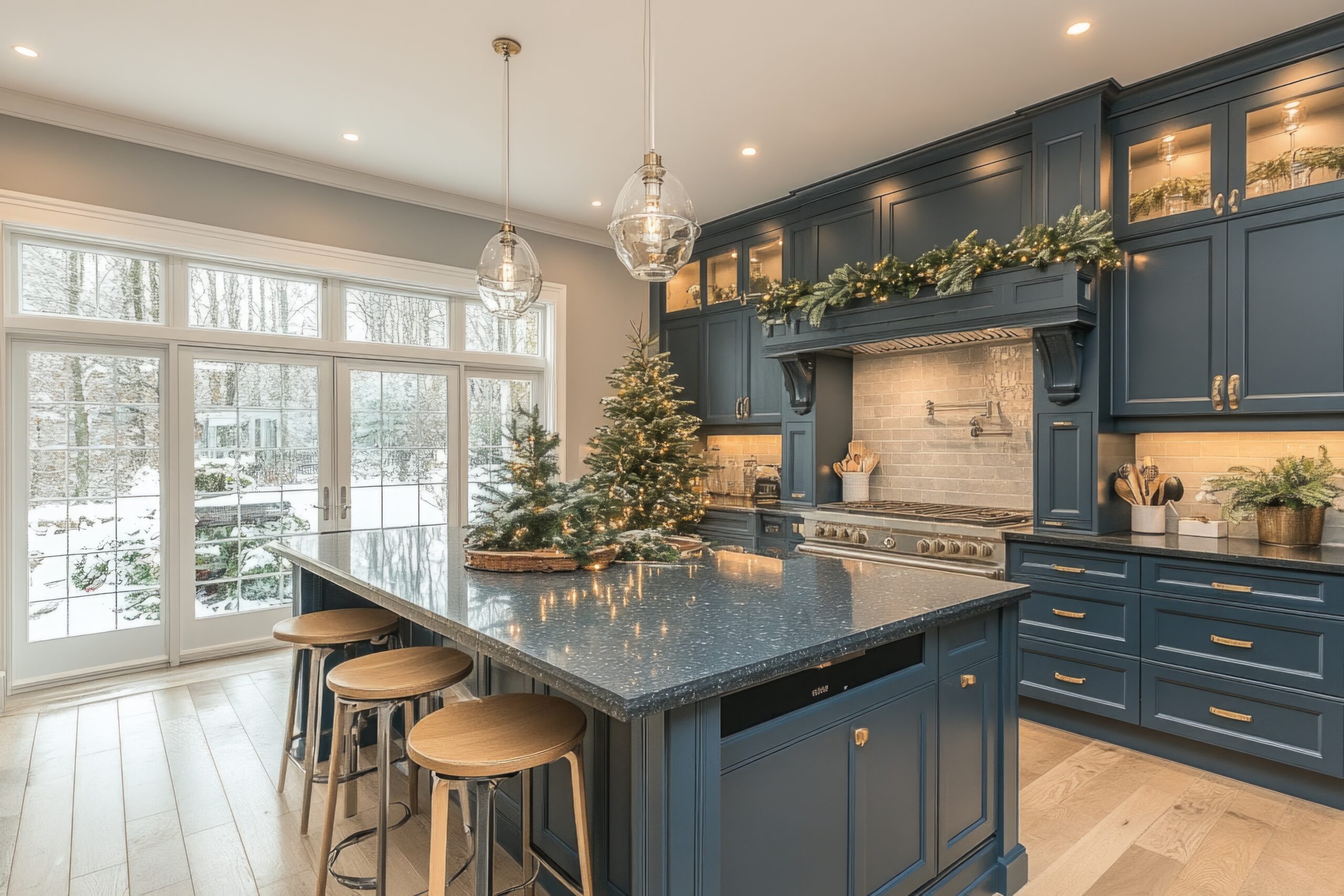
The best designs always come down to thoughtful layering and subtlety. Cabinet light fixtures should feel like an integral part of the space, not an afterthought or purely functional component. With careful selection and placement, your lighting becomes its own design language, enhancing every surface and detail it touches.
Maintenance Tips for Cabinet Light Fixtures
After you’ve spent time selecting, installing, and styling your cabinet light fixtures, a bit of regular maintenance keeps them looking and performing their best. Cabinet lighting doesn’t demand much upkeep, but a few simple habits can help preserve brightness, colour consistency, and longevity, so your kitchen always feels as vibrant and welcoming as the day you installed it.
1. Keep Fixtures Clean and Dust-Free
Cabinet lighting, especially under-cabinet fixtures, naturally collects dust and kitchen residue over time. Even a thin layer of buildup can reduce light output and change the colour tone of your LEDs.
Every few weeks, gently wipe fixtures with a soft, slightly damp microfiber cloth. Avoid harsh cleaning sprays, especially anything containing ammonia, alcohol, or abrasive ingredients, as they can damage finishes or cloud light diffusers.
For tighter spaces or light bars enclosed under cabinetry, a small handheld duster or compressed air works well. If you have removable diffusers or covers, clean them separately with mild soap and warm water, then dry completely before reinstalling.
2. Check for Loose Wires or Connectors
After months (or years) of use, vibration from cabinet doors and drawers can sometimes loosen connectors or shift wiring slightly, especially with adhesive LED strips. If you notice flickering or inconsistent lighting, start by checking connections before assuming a light has burned out.
For plug-in or battery-operated cabinet light fixtures, inspect cords for wear and confirm batteries are properly seated. Taking a few minutes once or twice a year to check the wiring helps prevent small issues from turning into full replacements later on.
3. Replace LEDs in Sets (When Necessary)
High-quality LED fixtures can last for years, but in time, even LEDs dim slightly. If a few lights fade or stop working, replace them in sets or zones. That helps maintain consistent brightness and colour across your kitchen, especially important if you mix warm and cool tones.
When possible, use the same brand and model as your existing cabinet light fixtures to ensure a perfect colour match. Manufacturers can have subtle variations in tone, even when specs appear identical.
4. Maintain Consistent Light Quality
If your lighting starts to feel uneven, one side too bright or slightly cooler, try rebalancing colour temperature settings or adjusting dimmers. Smart fixtures make this especially easy, as most allow remote calibration or scheduling.
For kitchens with both warm and cool-toned bulbs, make sure your cabinet light fixtures complement the overhead lighting tone. This keeps the overall look consistent and comfortable, rather than disjointed or overly contrasting.
5. Monitor for Heat and Moisture Exposure
Cabinets near ovens or stovetops naturally experience more heat and steam. Over time, excess moisture can wear down seals or adhesives on LED strips. If possible, choose fixtures with moisture-resistant covers in these areas and check periodically for condensation buildup.
Ensuring proper airflow, like leaving a small gap behind cabinet backings, also helps LEDs last longer and maintain stable performance.
6. Review Any Automation or Timer Settings
If you use timers, motion sensors, or smart systems, revisit those settings occasionally. It’s easy to forget about dimmer programs or custom scenes once you’ve used them for a while. Updating them ensures your lighting still matches your current habits and needs, especially if your kitchen use changes with the seasons.
Adjust scheduling so cabinet light fixtures turn on slightly before evening shadows fall and off after consistent overnight hours. It’s a small but satisfying detail that makes the space feel thoughtfully maintained.
A clean, balanced, and well-maintained lighting setup does more than look good; it ensures comfort, reliability, and efficiency every day. With a little attention now and then, your cabinet light fixtures will continue adding beauty and warmth to your kitchen long after installation day.
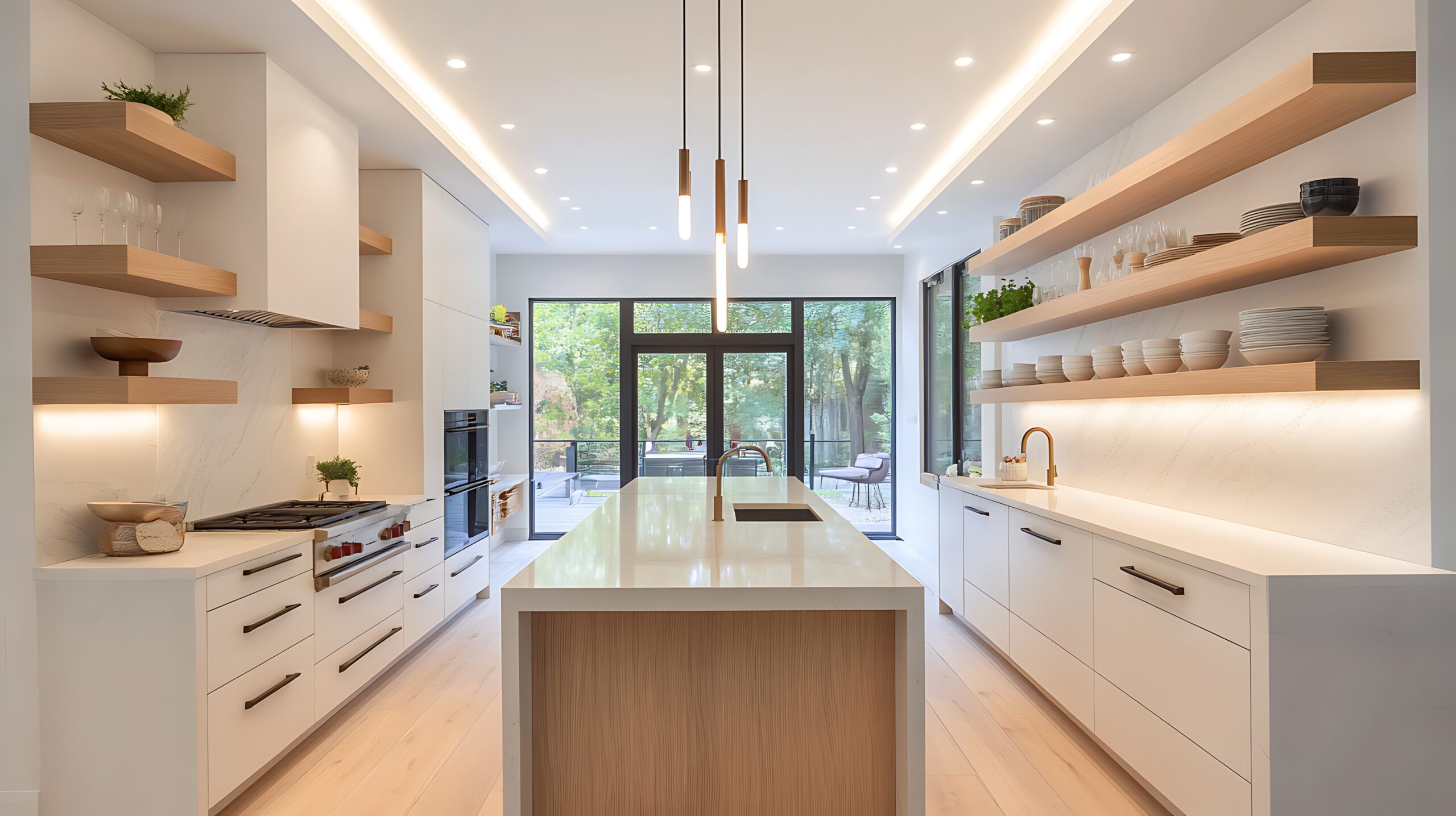
Good lighting has a way of tying everything together, and cabinet light fixtures are often the detail that makes a kitchen truly shine. They bring out colours, textures, and finishes that might otherwise go unnoticed. More importantly, they make your kitchen a space you want to spend time in, relaxed, bright, and thoughtfully designed.

by Kesaa Interiors | Lighting & Accessories
This post is all about Dark Dining Room Ideas. There’s something undeniably captivating about a dark dining room. The depth, the mood, the quiet confidence, it all creates a sense of intimacy that lighter spaces sometimes struggle to achieve. Designing with darker...
This post is all about Bathroom Vanity Organiser Under Sink. A bathroom vanity organiser under the sink can make an incredible difference in how your bathroom looks and functions. It’s often one of the most overlooked spaces in the home, yet it has the...
This post is all about Modern Minimalist Interior Design Living Room. A modern minimalist interior design living room is more than just a trend; it’s a reflection of how we live today. Clean lines, open spaces, and thoughtful details come together to create...
This Post Is All About Bedroom Ideas For Girls Designing a space that feels personal and full of character starts here, and these bedroom ideas for girls are the perfect inspiration. Whether you’re refreshing a cosy nook or planning a complete makeover, finding the...
This post is all about Kitchen Pantry Door Storage. A well‑designed kitchen makes everyday life easier, and that’s exactly where kitchen pantry door storage comes in. It’s one of those clever interior design tricks that turns overlooked space into something...
This post is all about spring home decor ideas. Spring is the perfect time to breathe new life into your home. As the days get brighter, interiors naturally feel ready for fresh energy, lighter colours, and simple updates that make each room feel inviting again. If...
This post is all about How To Arrange Furniture In A Room. I’ve always believed that the way furniture is arranged can completely change how a room feels. It’s not just about where you put the sofa or how far a chair sits from the coffee table; it’s about creating a...
Put in your email and sign up for weekly emails updating you on everything happening in the design world
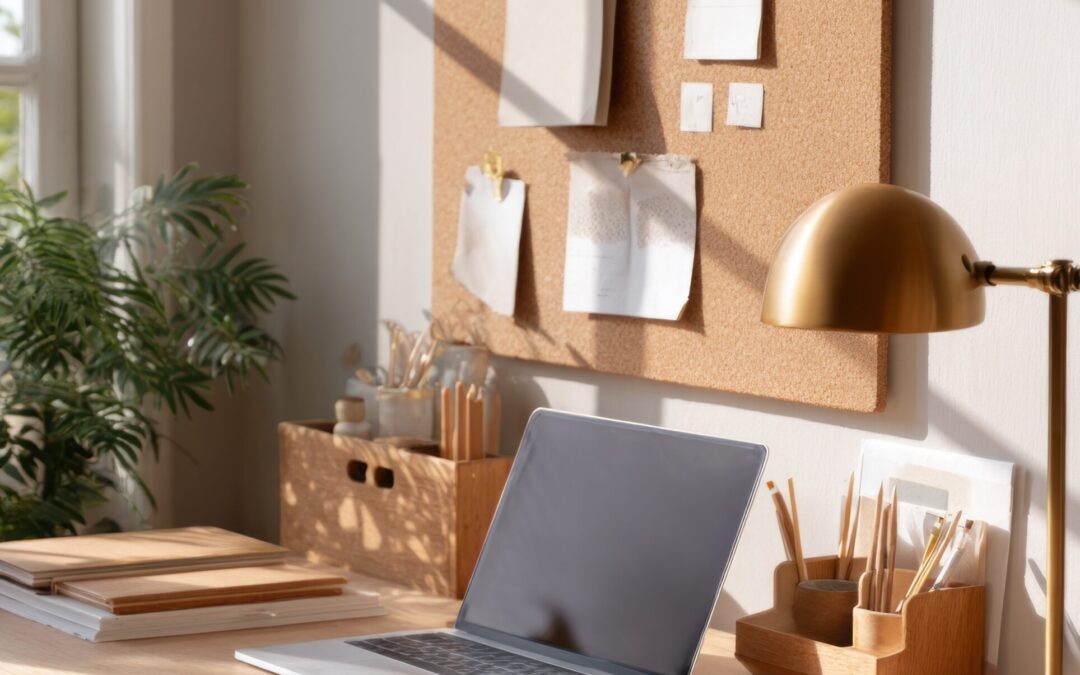
by Kesaa Interiors | DECOR & DIY, Home Office, Lighting & Accessories, ROOMS
This post is all about Small Home Office Lighting Ideas.
Lighting completely transforms how a small home office feels and functions. After years of designing compact workspaces, I’ve seen firsthand how the right lighting setup can make a cramped corner feel spacious and inviting, while poor lighting can make even the most organised space feel oppressive.
The challenge with small home offices is that every square inch counts. You need lighting that works hard without taking up precious desk or floor space. The good news? There are more innovative small home office lighting ideas available now than ever before. From sleek wall-mounted fixtures to multifunctional desk lamps, you can create a well-lit workspace that enhances both your productivity and your room’s aesthetic.
Throughout this guide, we’ll explore practical lighting solutions that address the unique challenges of compact workspaces. Whether you’re converting a closet into an office or carving out a corner of your bedroom, these strategies will help you build a lighting plan that makes your space work harder and look better.
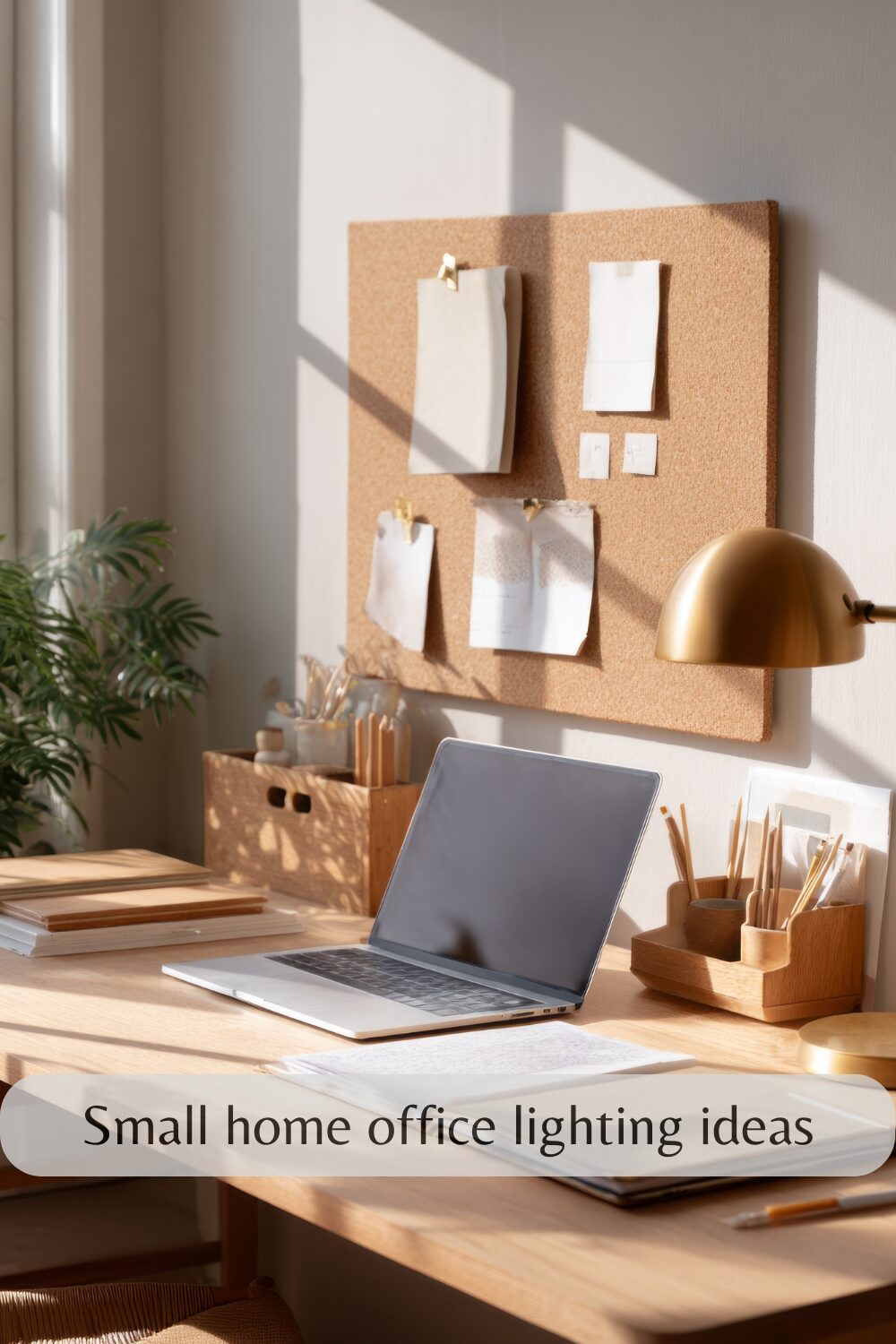
Understanding the Three Layers of Office Lighting
Creating effective lighting in any workspace starts with understanding the three essential layers: ambient, task, and accent lighting. In small home offices, mastering this layered approach becomes even more critical because you’re working with limited space and often fewer natural light sources.
Ambient Lighting
Think of ambient lighting as your room’s foundation. It provides overall illumination that allows you to move around safely and sets the general mood of your space. In small home offices, ambient lighting often comes from ceiling fixtures, but that’s where many people stop—and miss huge opportunities.
The trick with ambient lighting in compact spaces is achieving even coverage without overwhelming the room. A single overhead fixture rarely does the job well, creating harsh shadows and uneven light distribution. Instead, consider combining a modest ceiling fixture with indirect lighting sources. LED strips tucked behind floating shelves or along the ceiling perimeter can provide soft, diffused light that makes your space feel larger and more welcoming.
Task Lighting
This is where your small home office lighting ideas need to get specific and strategic. Task lighting illuminates your primary work areas—your desk, reading chair, or any surface where you perform detailed work. Without proper task lighting, you’ll find yourself squinting at your screen, developing headaches, and feeling fatigued much faster than necessary.
In small spaces, adjustable desk lamps remain the gold standard for task lighting. Look for models with articulating arms that let you direct light exactly where you need it. The key is choosing fixtures with small bases that don’t eat up valuable desk real estate. Wall-mounted swing-arm lamps are particularly brilliant for tiny offices because they provide all the flexibility of a desk lamp without touching your work surface.
Position your task lighting to minimise glare on your computer screen while illuminating your keyboard and any paperwork. The light source should sit above and slightly to the side of your work area, never directly in your line of sight.
Accent Lighting
While it might seem like a luxury in a small space, accent lighting serves important purposes beyond aesthetics. It adds depth and dimension to your office, preventing that flat, box-like feeling that plagues small rooms. More importantly, it reduces eye strain by providing gentle contrast to your brighter task lighting.
Accent lighting in small home offices works best when it serves double duty. A small table lamp on a bookshelf provides both decorative appeal and additional light for finding reference materials. Battery-operated picture lights can highlight artwork while adding another layer of illumination. Even a simple string of warm LED lights along a shelf edge can soften the overall ambience while making your space feel more intentional and designed.
The beauty of this three-layer approach is its flexibility. During focused work sessions, you might rely heavily on task lighting with minimal ambient light. For video calls, you’ll want more balanced ambient lighting with strategic accent lights to create an appealing background. Understanding how these layers work together gives you complete control over your workspace atmosphere.
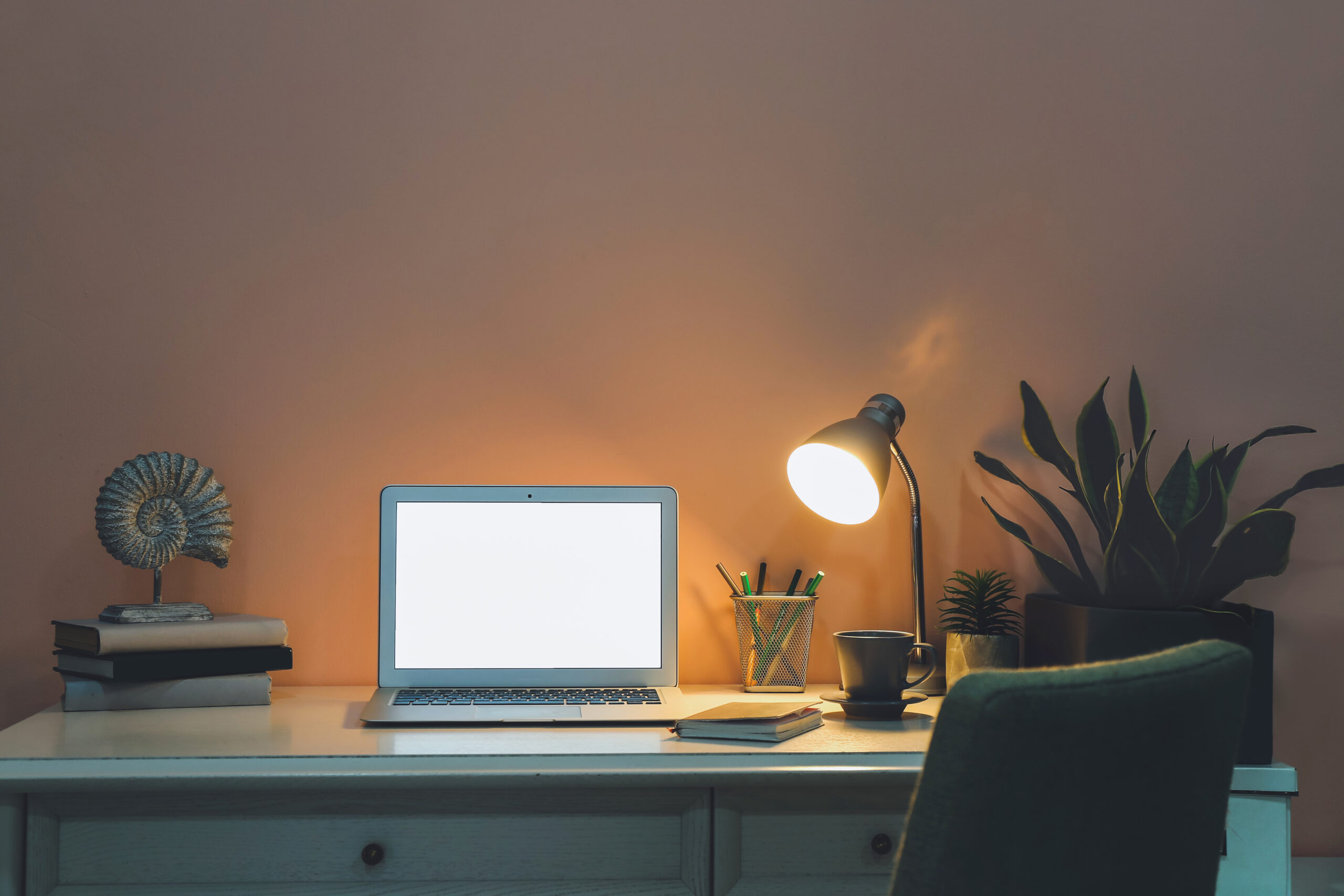
Best Small Home Office Lighting Ideas by Space Type
Every small home office comes with its own set of lighting challenges. The solution that works brilliantly in a converted closet might fail in a corner of your living room. Let’s break down the most effective lighting strategies for different types of compact workspaces.
Corner Office Setups
Corner offices are perhaps the most common small home office configuration, and they present unique opportunities for creative lighting solutions. The two walls give you multiple mounting surfaces, which is a huge advantage when floor space is at a premium.
Wall-mounted swing arm lamps are ideal here. Mount one on the wall beside your desk, positioning it so the arm can reach across your entire work surface. This setup gives you focused task lighting without sacrificing any desk space. The adjustable arm means you can push the light out of the way when you’re not using it, keeping your corner feeling open and uncluttered.
LED strip lighting works wonders in corner setups, especially when installed under floating shelves above your desk. This creates a wash of light across your work surface that’s both functional and atmospheric. The strips are nearly invisible when installed properly, so you get the benefit of additional lighting without any visual bulk. Choose strips with dimming capabilities so you can adjust the intensity based on the time of day and your current task.
Don’t overlook the potential of a well-placed corner floor lamp. Modern designs with small footprints can tuck perfectly into the angle where your walls meet, providing ambient uplighting that makes your ceiling appear higher. Look for models with built-in shelves or tables—these multifunctional pieces are perfect for small spaces where every item needs to earn its keep.
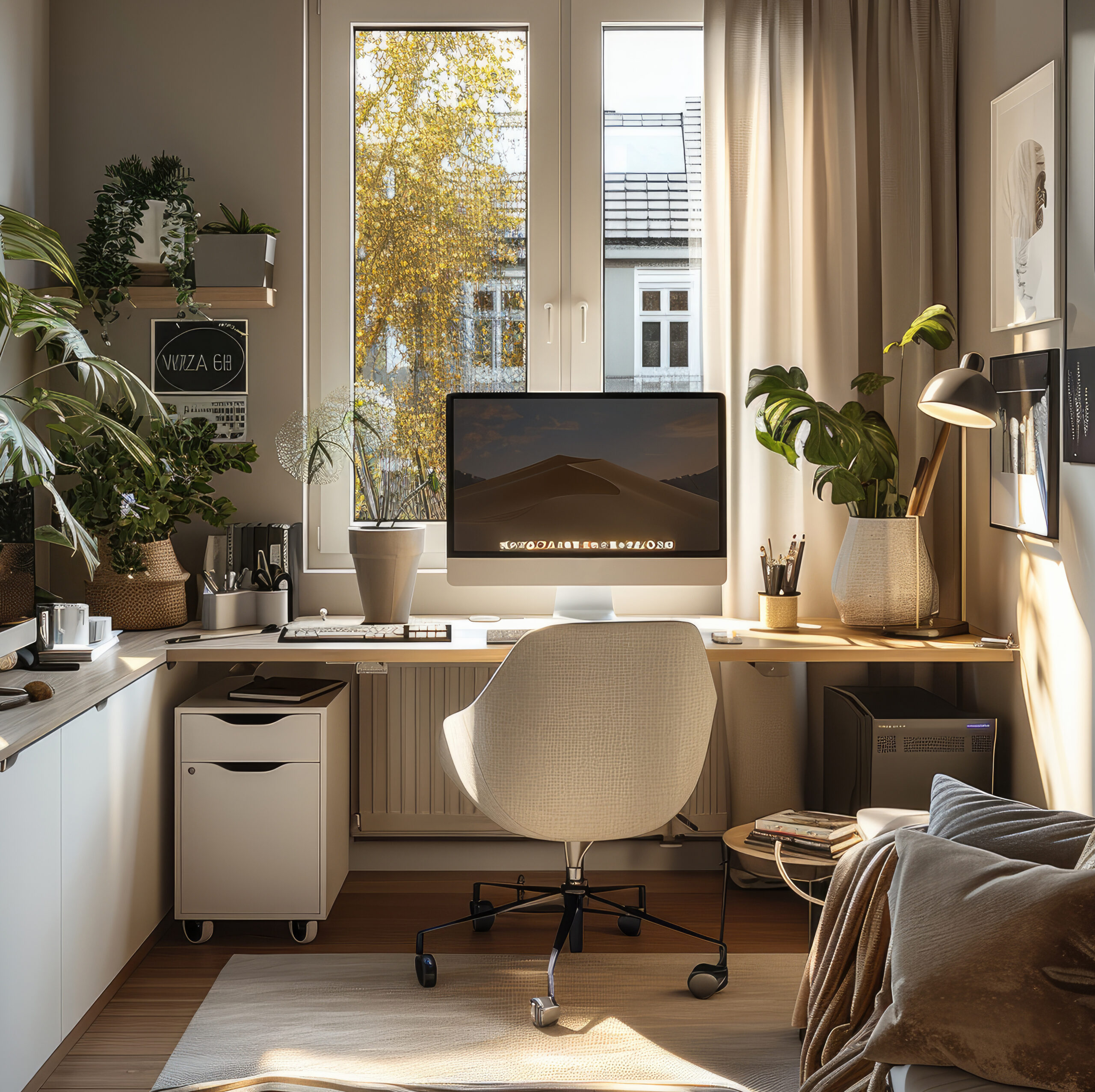
Closet Office Conversions
Transforming a closet into a home office has become increasingly popular, but these ultra-compact spaces require particularly clever lighting solutions. The confined nature of a closet means you’re often dealing with no windows and limited electrical access, which calls for creative problem-solving.
Recessed lighting can be a game-changer if you’re willing to invest in some basic electrical work. Even just two or three small recessed fixtures in the ceiling can provide ample ambient light without eating into your precious headroom. If hardwiring isn’t an option, battery-operated LED puck lights offer a surprisingly effective alternative. Modern versions are rechargeable via USB and can last weeks on a single charge.
For task lighting in closet offices, magnetic track lighting systems are worth their weight in gold. These systems attach to metal strips that you can mount on walls or under shelves, and the individual lights can be repositioned as needed. This flexibility is crucial in such a small space where your lighting needs might change based on whether you’re typing, reading, or taking video calls.
The back wall of your closet office is prime real estate for lighting. Consider installing a panel of LED backlighting behind a frosted acrylic sheet. This creates a bright, even light source that doesn’t glare and makes your tiny space feel more like a professional workspace than a converted storage area.
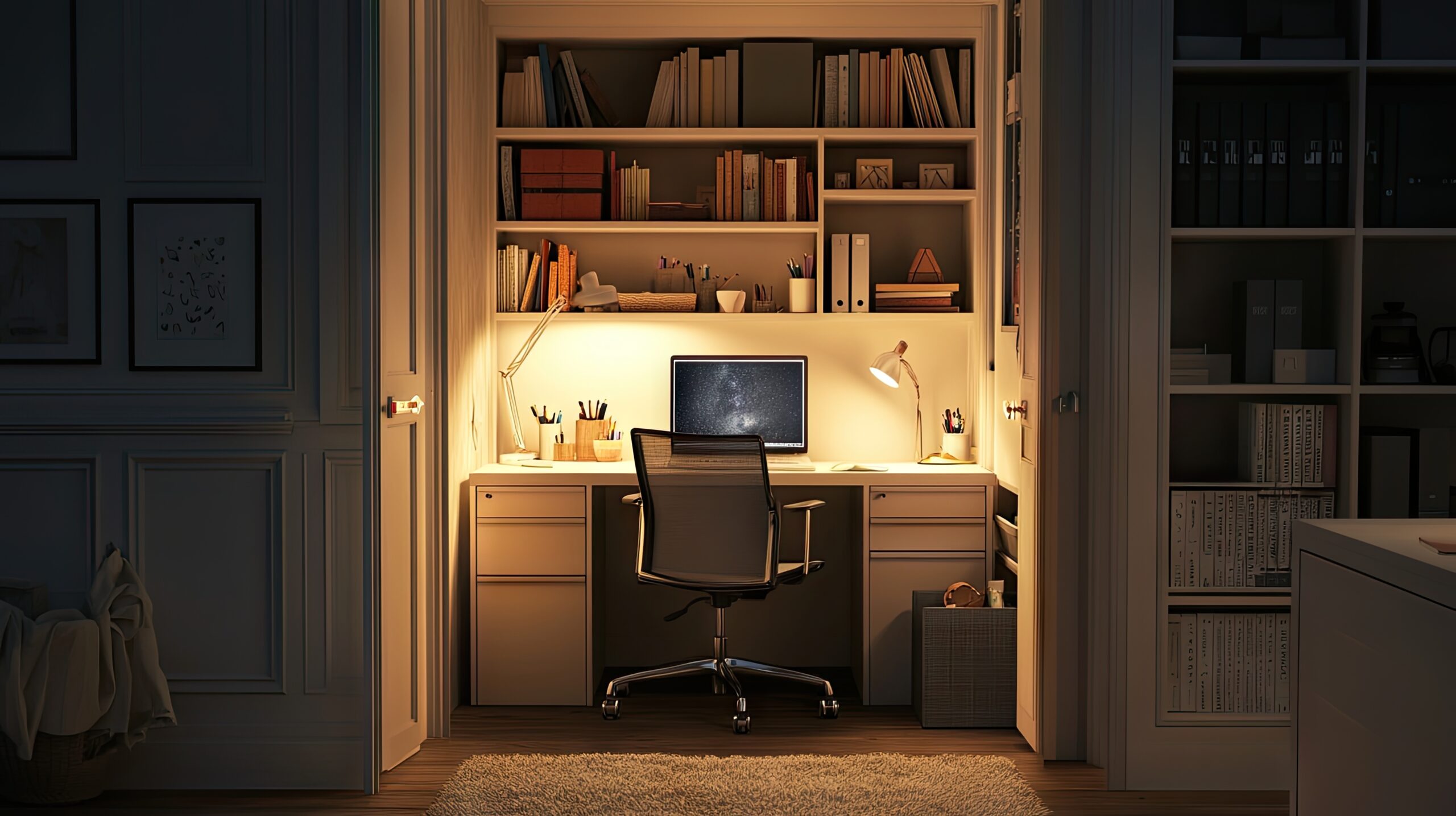
Shared Space Solutions
When your home office shares space with another room function—whether it’s your bedroom, living room, or dining area—lighting becomes about creating definition and flexibility. Your small home office lighting ideas here need to establish a clear work zone while maintaining harmony with the room’s other purposes.
Portable desk lamps with focused beam technology are essential for shared spaces. These lamps create a pool of bright light on your work surface without spilling over into the rest of the room. This is particularly important if you’re working while others are relaxing or sleeping nearby. Look for lamps with multiple brightness settings and colour temperature options so you can adjust based on the room’s overall lighting needs.
Clip-on lights deserve more credit than they typically get. These versatile fixtures can attach to shelves, desk edges, or even window frames, providing targeted light exactly where you need it. When you’re done working, many clip lights can be repositioned to serve as reading lights or accent lighting for the room’s other functions.
Smart bulbs have revolutionised lighting for multi-purpose spaces. Program different “scenes” for work time versus relaxation time. During work hours, your desk lamp might emit bright, cool light for maximum alertness. Come evening, the same fixture can switch to warm, dim light that complements the room’s leisure activities. This technology lets you optimise your small home office lighting ideas without constantly swapping fixtures or adjusting multiple switches.
The key to shared space lighting is thinking in zones rather than trying to light the entire room uniformly. Use your lighting to create a subtle but clear boundary around your work area. This psychological separation helps you maintain focus during work hours while allowing the space to transform back into its other role when you’re off the clock.
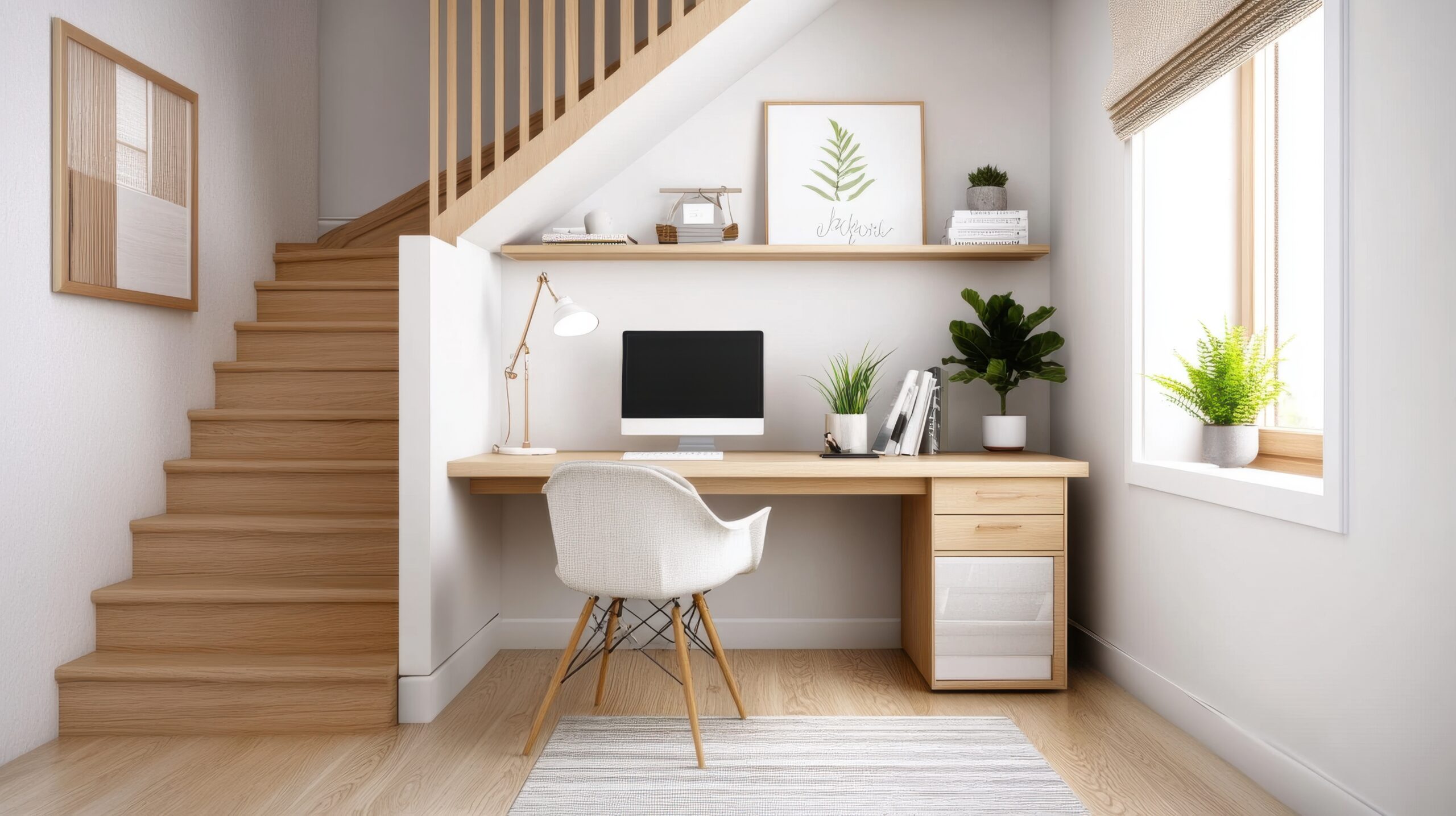
Top Lighting Fixtures for Small Home Offices
Choosing the right fixtures can make or break your lighting plan. The market is flooded with options, but not all are suitable for compact workspaces. Here’s what actually works when space is tight and style still matters.
Space-Saving Desk Lamps
The ideal desk lamp for a small home office has a minimal base footprint, maximum adjustability, and enough light output to illuminate your entire work surface. Architect-style lamps with weighted bases that measure less than 6 inches across hit all these marks. The cantilever design means the lamp extends over your desk without the base taking up valuable space where you need to work.
Look for features that add functionality without bulk. Built-in USB charging ports eliminate the need for a separate charging station. Lamps with touch controls on the base or head are easier to adjust than those with cords or switches that dangle. Memory functions that recall your preferred brightness and colour temperature settings save time and ensure consistent lighting conditions.
LED technology has been a game-changer for small home office lighting ideas. Modern LED desk lamps produce more light than their halogen predecessors while generating almost no heat—a crucial consideration when you’re working in tight quarters. The slim profiles possible with LED technology mean today’s desk lamps can be both powerful and nearly invisible when viewed from the side.
Wall-Mounted Options
Wall-mounted lighting deserves serious consideration in any small office. By moving your light sources off horizontal surfaces, you instantly free up space for the things that actually need to sit on your desk.
Plug-in wall sconces have evolved far beyond the hotel-room reading light. Contemporary designs offer the same adjustability as desk lamps but mount to the wall with a simple bracket. The best models feature extra-long arms that can extend across a full desk width, then fold flat against the wall when not in use. For renters, these plug-in options avoid the permanence of hardwired fixtures while still providing professional-grade lighting.
If you own your space or have an accommodating landlord, hardwired fixtures open up even more possibilities. Swing-arm wall lamps with dimmer switches give you complete control over your lighting environment. Position them at eye level or slightly above to minimise shadows on your work surface. The hardwired approach also eliminates cord clutter—a significant advantage in small spaces where every visual distraction matters.
Track lighting mounted on the wall rather than the ceiling offers unique flexibility for small offices. You can adjust individual heads to highlight different areas as your needs change, and modern track systems accept various fixture types so you can mix focused spotlights with broader wash lights.
Overhead Solutions
Overhead lighting in small home offices requires careful consideration. The wrong fixture can make a low ceiling feel oppressive or cast unflattering shadows across your workspace.
Pendant lights can work beautifully in small offices, but placement is critical. Hang them off to the side rather than directly over your desk to avoid creating shadows when you lean forward to work. A pendant with an opaque shade that directs light downward prevents glare on your computer screen while adding a design element that draws the eye upward, making your space feel larger.
For rooms with standard 8-foot ceilings or lower, flush-mount fixtures are the practical choice. Modern LED flush-mounts come in sleek designs that provide substantial light output without the bulk of traditional fixtures. Look for models with frosted diffusers that spread light evenly across the room rather than creating a bright spot directly below.
Track lighting remains one of the most versatile overhead options for small home offices. The ability to aim individual lights means you can illuminate your desk, highlight wall art, and provide general room lighting all from one fixture. Choose a track system that allows you to add or remove lights as your needs evolve.
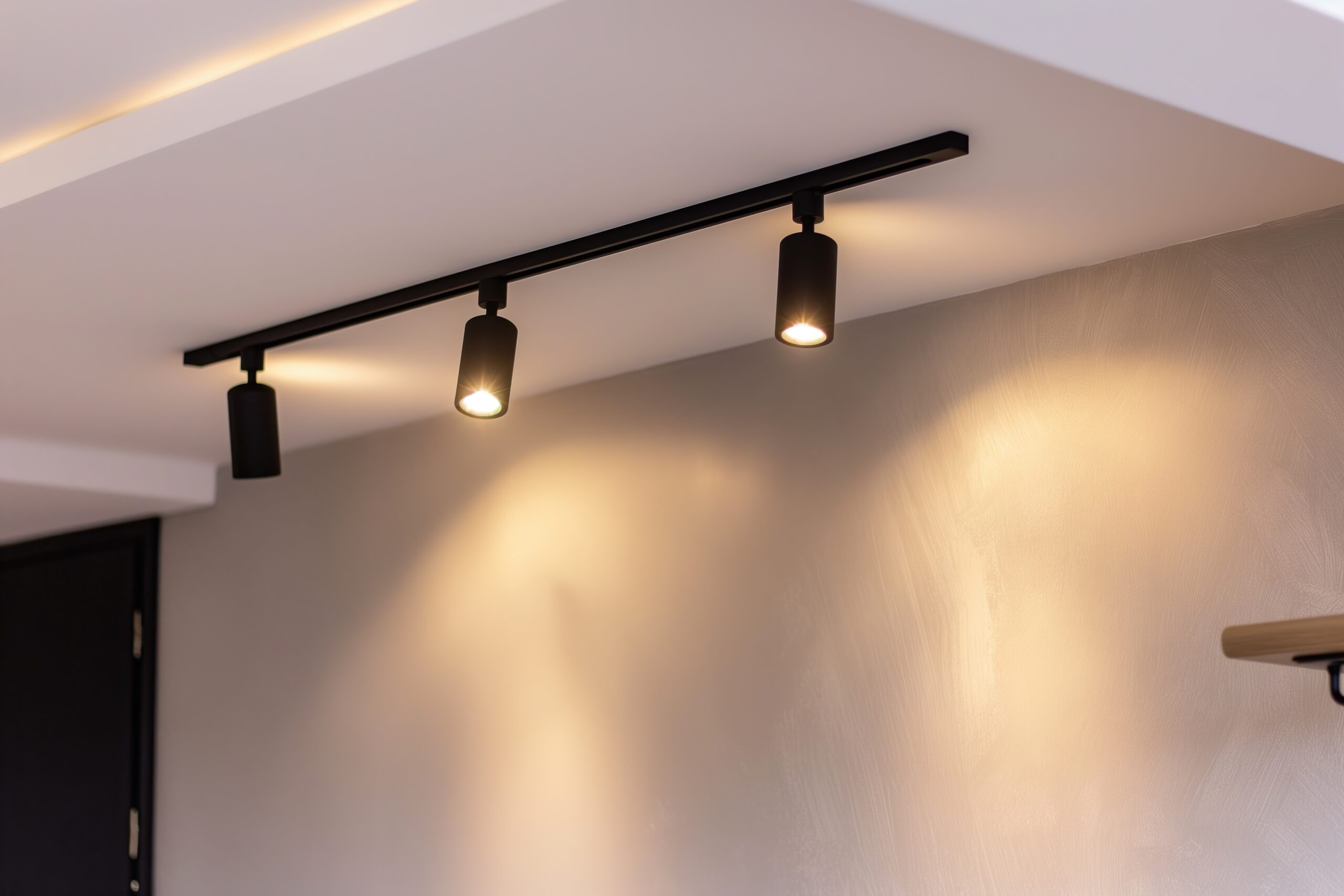
Natural Light Optimisation
While artificial lighting is crucial, maximising natural light should be your first priority in any small home office. Daylight boosts mood, reduces eye strain, and makes small spaces feel more expansive—all without using a single watt of electricity.
Window Placement Strategies
The relationship between your desk and windows determines whether natural light becomes an asset or a liability. Positioning your desk perpendicular to a window gives you the benefit of natural light without glare on your screen or shadows across your work surface. This setup also prevents you from staring directly into bright light, which can cause eye fatigue and headaches.
If perpendicular placement isn’t possible, position your monitor between you and the window rather than facing it. This arrangement uses your screen to block direct sunlight while still allowing natural light to fill the room. Adjust your monitor’s brightness and contrast settings throughout the day to maintain comfortable viewing as natural light levels change.
Sheer curtains or adjustable blinds are essential tools for managing natural light. They diffuse harsh direct sunlight while maintaining the psychological benefits of a connection to the outdoors. Light-filtering cellular shades offer excellent control—you can adjust them to block glare at certain times of day while still allowing diffused light to enter.
Mirrors and Reflective Surfaces
Strategic use of mirrors can dramatically amplify natural light in a small home office. A mirror placed on the wall opposite a window effectively doubles the natural light in your space. The reflection also creates an illusion of depth, making your office feel less confined.
But mirrors require thoughtful placement. Avoid positioning them where they’ll reflect your computer screen back at you or create distracting movements in your peripheral vision. A tall mirror leaning against the wall behind your desk can bounce light from windows on the side walls without causing these problems.
Light-coloured furniture and walls do more than just look clean and modern—they act as natural light reflectors. White or light grey walls can increase the effective brightness of your space by up to 80% compared to dark colours. If painting isn’t an option, even adding light-colored furniture or wall art can help distribute natural light more effectively throughout your small office.
Light Tubes and Skylights
For interior rooms or spaces without adequate windows, light tubes (also called sun tunnels) offer an innovative solution. These systems capture sunlight on the roof and channel it through reflective tubes to a diffuser in your ceiling. Modern light tubes can bring surprising amounts of natural light into windowless spaces, and their small ceiling footprint makes them ideal for tiny offices.
While skylights require more substantial installation, they’re worth considering if you’re planning a major renovation. A small skylight can transform a cramped, dark space into an airy, productive environment. Opt for models with built-in blinds or electrochromic glass that can be dimmed electronically to prevent overheating and glare during peak sun hours.
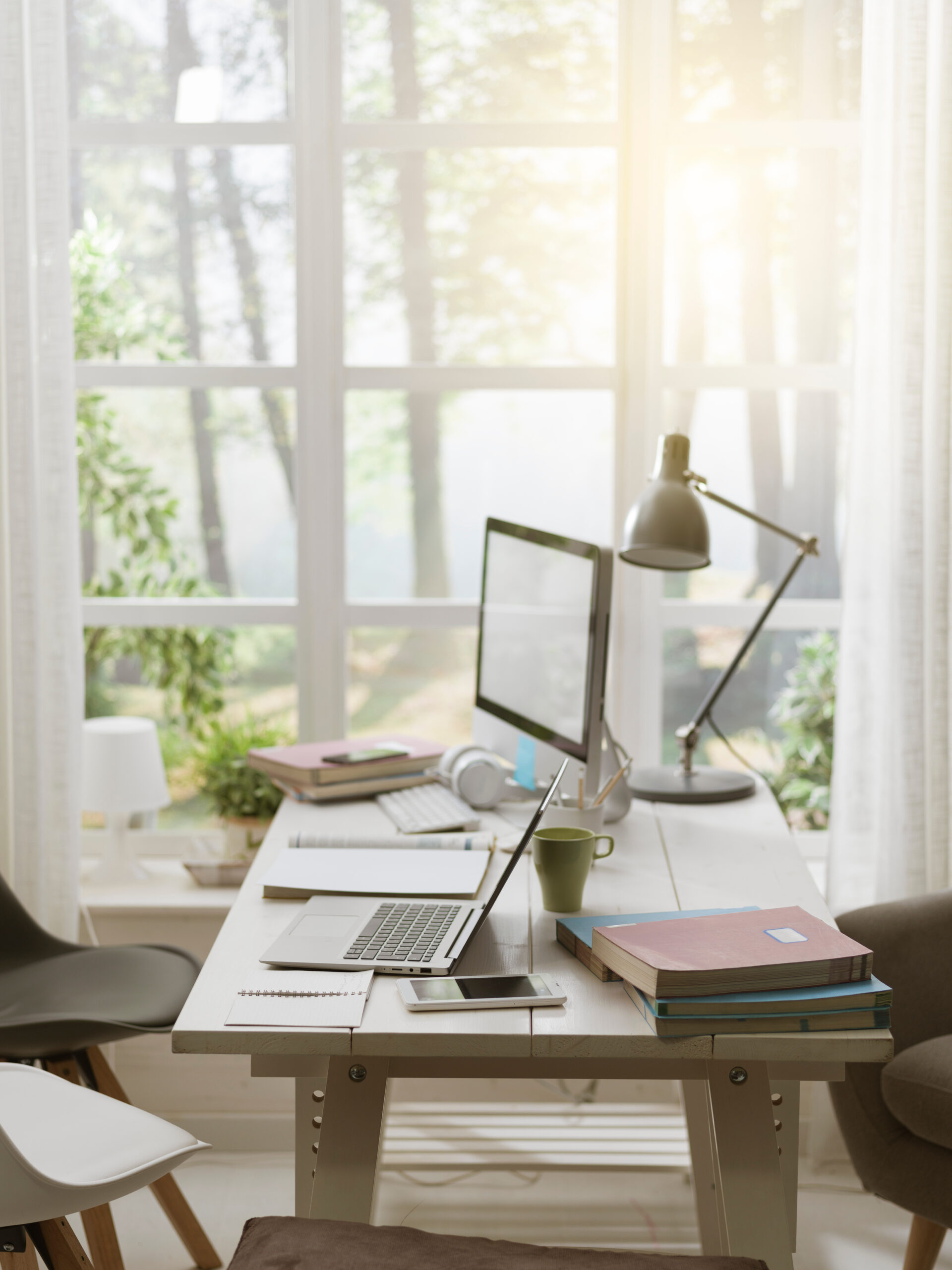
Smart Lighting Solutions
Technology has revolutionised how we approach small home office lighting ideas. Smart lighting systems offer unprecedented control over your workspace environment, and they’re particularly valuable in compact spaces where every element needs to multitask.
Programmable LED Bulbs
Smart LED bulbs have moved beyond novelty to become genuinely useful tools for productivity. The ability to adjust colour temperature throughout the day aligns your lighting with your natural circadian rhythms. Cool, bright light in the morning helps you feel alert and focused. As the afternoon approaches, gradually warming the light reduces eye strain and helps prevent the energy crash many people experience.
Most smart bulbs connect to your home WiFi and can be controlled through smartphone apps. This means you can adjust your lighting without leaving your desk—a small but meaningful advantage when you’re deep in concentration. Set schedules that automatically adjust your lighting based on your typical work patterns. Your lights can brighten gradually as you start your workday and dim as evening approaches.
Integration with productivity apps takes smart lighting to another level. Some systems can sync with your calendar to automatically brighten lights during important video calls or dim them during scheduled focus time. Others connect with Pomodoro timer apps, subtly changing colour to signal when it’s time for a break.
Motion Sensors
Motion-activated lighting might seem unnecessary in a small office where everything is within arm’s reach, but these systems offer surprising benefits. Under-desk motion sensors can activate bias lighting when you sit down, reducing the contrast between your bright screen and dark surroundings. This simple addition significantly reduces eye strain during long work sessions.
Motion sensors also work well for auxiliary lighting. Install them in nearby closets or storage areas so you don’t have to fumble for switches when grabbing supplies. The hands-free operation is particularly valuable when your hands are full of files or equipment.
Energy efficiency is another compelling argument for motion sensors in small offices. Since these spaces often double as storage or occasional-use areas, motion sensors ensure lights only run when someone’s actually present. Over time, the energy savings can offset the initial investment in sensor technology.
Voice-Controlled Systems
Voice control has matured from a gimmick to a practical tool for lighting management. When your small home office lighting ideas include multiple light sources, voice commands let you control them all without cluttering your desk with multiple switches or remotes.
Popular systems like Alexa, Google Assistant, and Siri can control most major smart lighting brands. Create custom commands that adjust multiple lights simultaneously. A simple “start work” command could turn on your desk lamp, brighten overhead lights, and activate your bias lighting all at once. End-of-day commands can reverse the process, helping establish clear boundaries between work and personal time.
The real power of voice control becomes apparent during video calls or when your hands are occupied. Adjust lighting on the fly without interrupting your flow or reaching across your desk. This seamless control helps maintain the professional atmosphere that’s sometimes challenging to achieve in a home office setting.
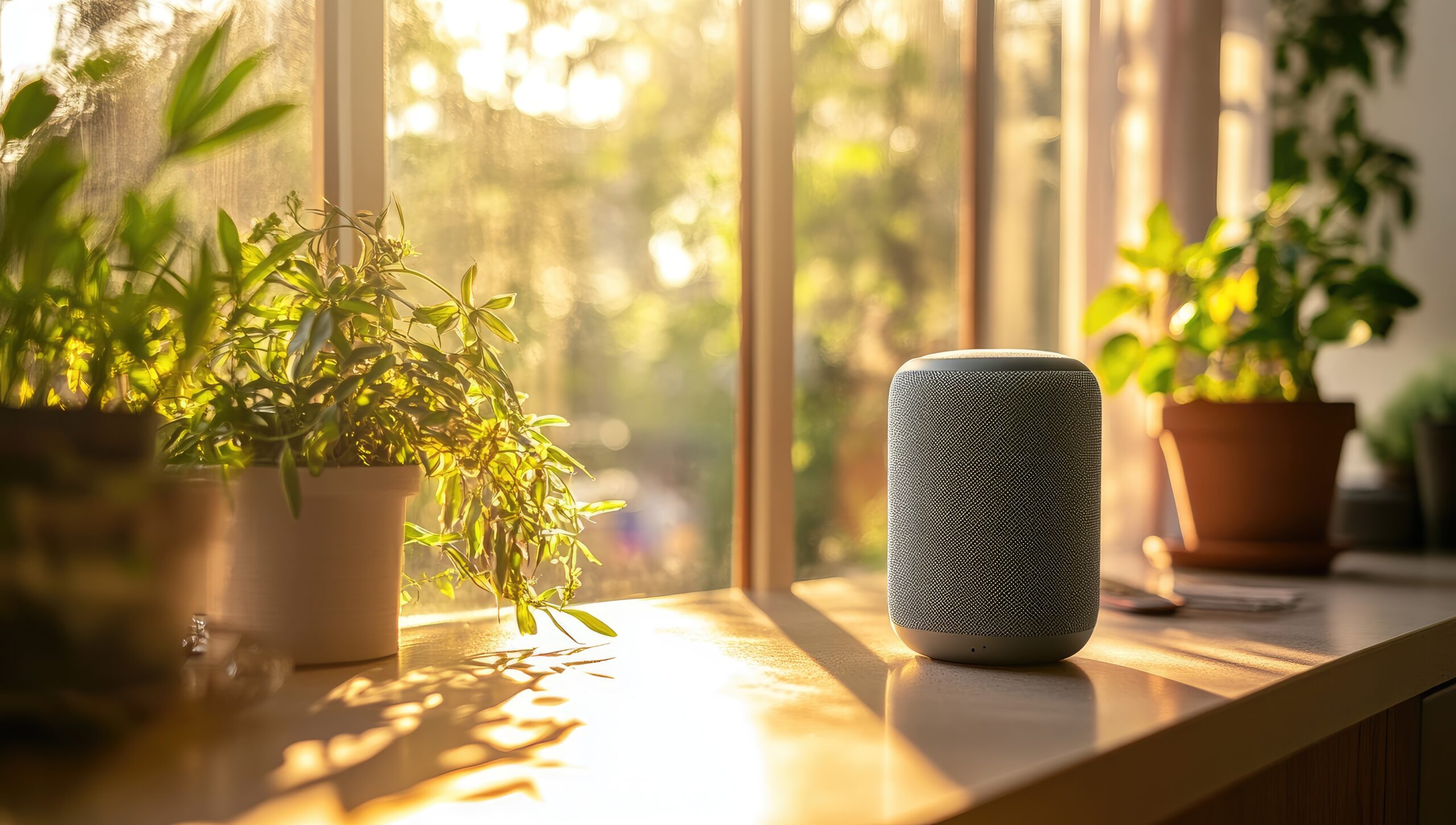
Common Lighting Mistakes to Avoid
Even well-intentioned lighting plans can go wrong. Understanding these common pitfalls helps you create a more effective lighting scheme from the start.
Over-lighting Small Spaces
More light isn’t always better, especially in compact offices. Over-lighting creates harsh contrasts, increases glare, and can make a small space feel clinical rather than comfortable. The goal is even, adequate illumination, not maximum brightness.
Calculate your lighting needs based on the specific tasks you perform. General office work requires about 40-50 lumens per square foot. Detailed tasks like reading fine print or working with small components need closer to 70-80 lumens per square foot. In a 64-square-foot office (8×8 feet), this translates to roughly 2,500-3,000 total lumens for general work.
Signs of over-lighting include frequent headaches, difficulty focusing on your screen, and the need to squint even when looking at non-digital materials. If you find yourself turning off lights to feel comfortable, you’ve likely exceeded your space’s optimal lighting levels. Remember that walls, furniture, and other surfaces reflect light, amplifying the effect of your fixtures.
Ignoring Colour Temperature
Colour temperature dramatically affects both productivity and mood, yet many people install bulbs without considering this crucial factor. Cool light (5000K-6500K) promotes alertness but can feel harsh in small spaces. Warm light (2700K-3000K) creates a cosy atmosphere but might make you drowsy during afternoon work sessions.
The sweet spot for most small home offices falls between 3500K and 4500K—neutral white light that supports focus without feeling sterile. If you can only choose one colour temperature, 4000K works well for most people and tasks. However, the ideal solution involves an adjustable colour temperature that changes throughout the day.
Pay attention to consistency across your light sources. Mixing warm and cool bulbs in the same space creates visual discord that’s subtly exhausting. When implementing small home office lighting ideas, ensure all your bulbs in the same sightline share similar colour temperatures.
Poor Shadow Management
Shadows are inevitable, but problematic shadows can make work unnecessarily difficult. The most common culprit is a single overhead light source that casts shadows from your hand onto your writing surface or keyboard. These shadows force constant micro-adjustments in posture and head position, leading to neck and shoulder strain.
Identify shadow problems by working through your typical tasks while paying attention to where shadows fall. Take photos of your workspace at different times of day to spot issues you might miss in the moment. The solution usually involves adding light from multiple angles rather than simply increasing brightness from existing sources.
Cross-lighting—illuminating your workspace from two or more directions—effectively eliminates problematic shadows. This doesn’t require doubling your fixtures; often, adding a simple LED strip or small accent light from the opposite direction solves shadow issues completely.
Budget-Friendly Small Home Office Lighting Ideas
Creating a well-lit workspace doesn’t require a massive investment. Some of the most effective lighting solutions cost less than a nice desk chair.
DIY Solutions
Battery-operated LED strips have revolutionised budget lighting. These adhesive strips cost under $20 and can transform dark corners into a functional workspace. Install them under shelves, behind monitors, or along the back edge of your desk for instant bias lighting. The battery versions eliminate cord clutter and work anywhere, regardless of outlet placement.
Repurposing household items into lighting fixtures adds personality while saving money. A simple pendant light kit (around $15) can transform anything from a basket to a colander into a unique overhead fixture. Mason jar lights might be overdone in some contexts, but in a small office, their compact size and warm glow create an inviting atmosphere without breaking the budget.
Rope lights offer another affordable option for adding ambient lighting to small offices. Wind them around wall-mounted shelves or tuck them behind furniture to create a soft glow that makes your space feel larger. Modern LED rope lights use minimal electricity and last for years, making them a smart long-term investment.
Affordable Upgrades
Sometimes the best lighting improvement is also the simplest. Swapping old incandescent or CFL bulbs for LED equivalents instantly improves light quality while reducing energy costs. A good LED bulb costs $5-10 but lasts 15-20 years with normal use. This simple upgrade pays for itself through energy savings while providing better light quality from day one.
Peel-and-stick LED strips with built-in dimmers offer professional-looking results for under $30. These strips come with adhesive backing and plug directly into standard outlets. Install them under cabinets or shelves for task lighting that rivals expensive built-in systems. The dimmable versions let you fine-tune brightness levels, making them versatile enough for both focused work and ambient lighting.
Discount retailers have seriously stepped up their lighting game in recent years. Stores like IKEA, Target, and even Five Below now carry architect-style desk lamps, modern pendants, and LED fixtures that look far more expensive than their price tags suggest. The key is knowing what to look for: sturdy construction, adjustable positioning, and LED compatibility matter more than brand names.
Thrift stores and online marketplaces offer another avenue for budget-conscious lighting upgrades. Older fixtures with good bones can be transformed with spray paint and new LED bulbs. A dated brass desk lamp becomes a modern matte black fixture with an hour of work and $5 in supplies. Just ensure any vintage fixtures are electrically sound before incorporating them into your small home office lighting ideas.
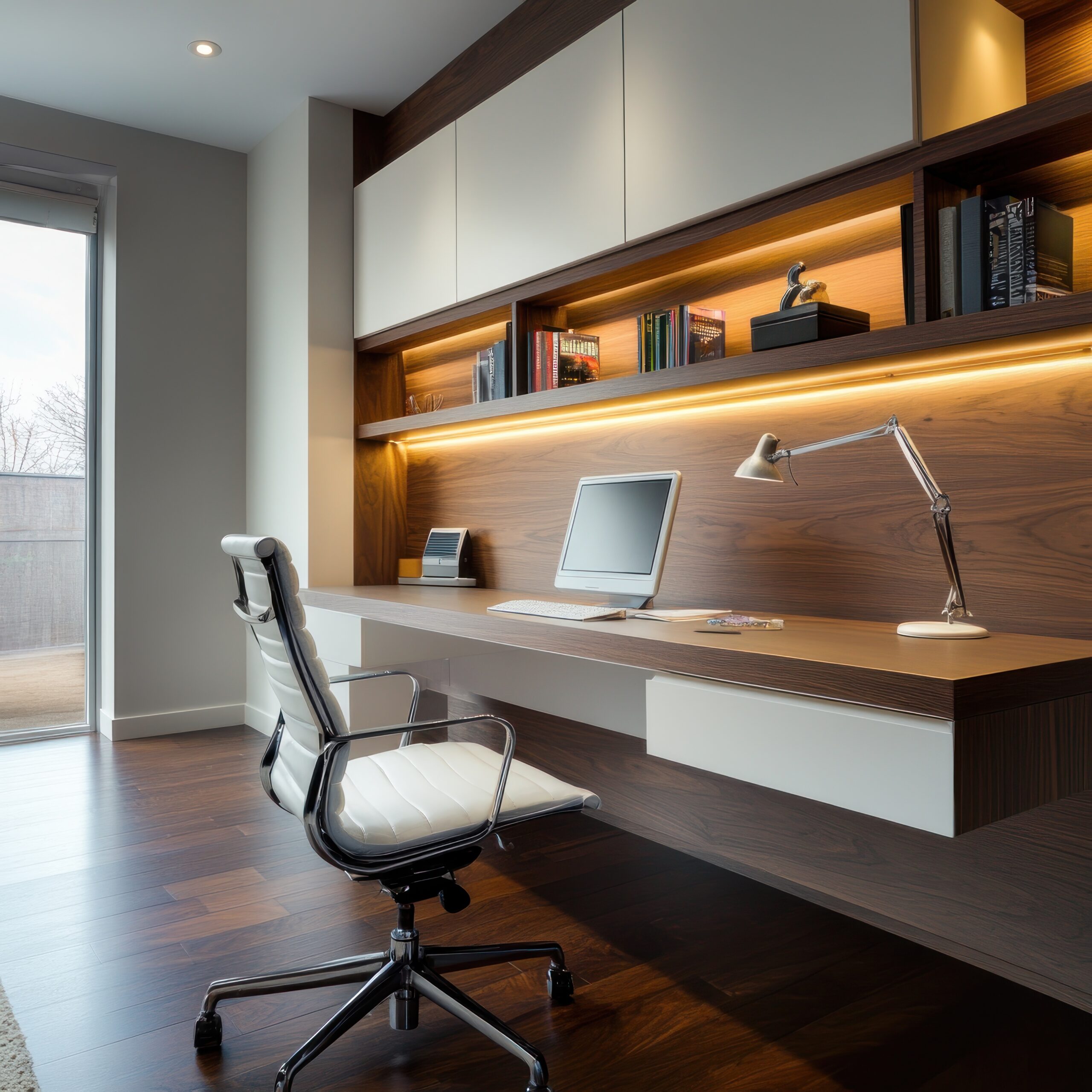
Lighting for Video Calls
The rise of remote work has made video call lighting a critical consideration for home offices. Poor lighting during video calls can undermine your professional image and make communication more difficult than necessary.
Professional Appearance on Camera
The key to looking professional on video calls is soft, even lighting that illuminates your face without creating harsh shadows. Position your primary light source in front of you, slightly above eye level and off to one side. This prevents the flat, washed-out look of direct frontal lighting while avoiding unflattering shadows.
A simple desk lamp positioned beside your monitor can work wonders if aimed correctly. Point the light at the wall behind your monitor rather than directly at your face. The reflected light provides softer, more flattering illumination. If you’re using a window for natural light, the same principle applies—sit facing the window but use sheer curtains to diffuse direct sunlight.
Background lighting deserves equal attention. A completely dark background makes you appear to float in space, while overly bright backgrounds cause your camera to improperly expose your face. Add a small lamp or LED strip behind you to provide subtle separation between you and your background. This three-dimensional lighting setup looks far more professional than relying on a single light source.
Portable Solutions
Dedicated video lighting doesn’t have to mean bulky, expensive equipment. Ring lights designed for smartphones and laptops have become incredibly affordable and effective. The circular design provides even, shadow-free lighting that’s particularly flattering for video calls. Many models clip directly onto your monitor or laptop screen, taking up zero desk space when not in use.
Small LED panels offer more flexibility than ring lights. These credit card-sized lights can be positioned anywhere and often include adjustable colour temperature and brightness. Mount one on a small tripod or clip it to a shelf for fill lighting that eliminates shadows without overwhelming your space. Battery-powered versions mean you can position them optimally without worrying about cord management.
The beauty of portable video lighting is its temporary nature. When your call ends, these lights can be tucked away in a drawer, maintaining the clean aesthetic of your small office. This flexibility is particularly valuable in shared spaces where permanent video lighting might interfere with the room’s other functions.
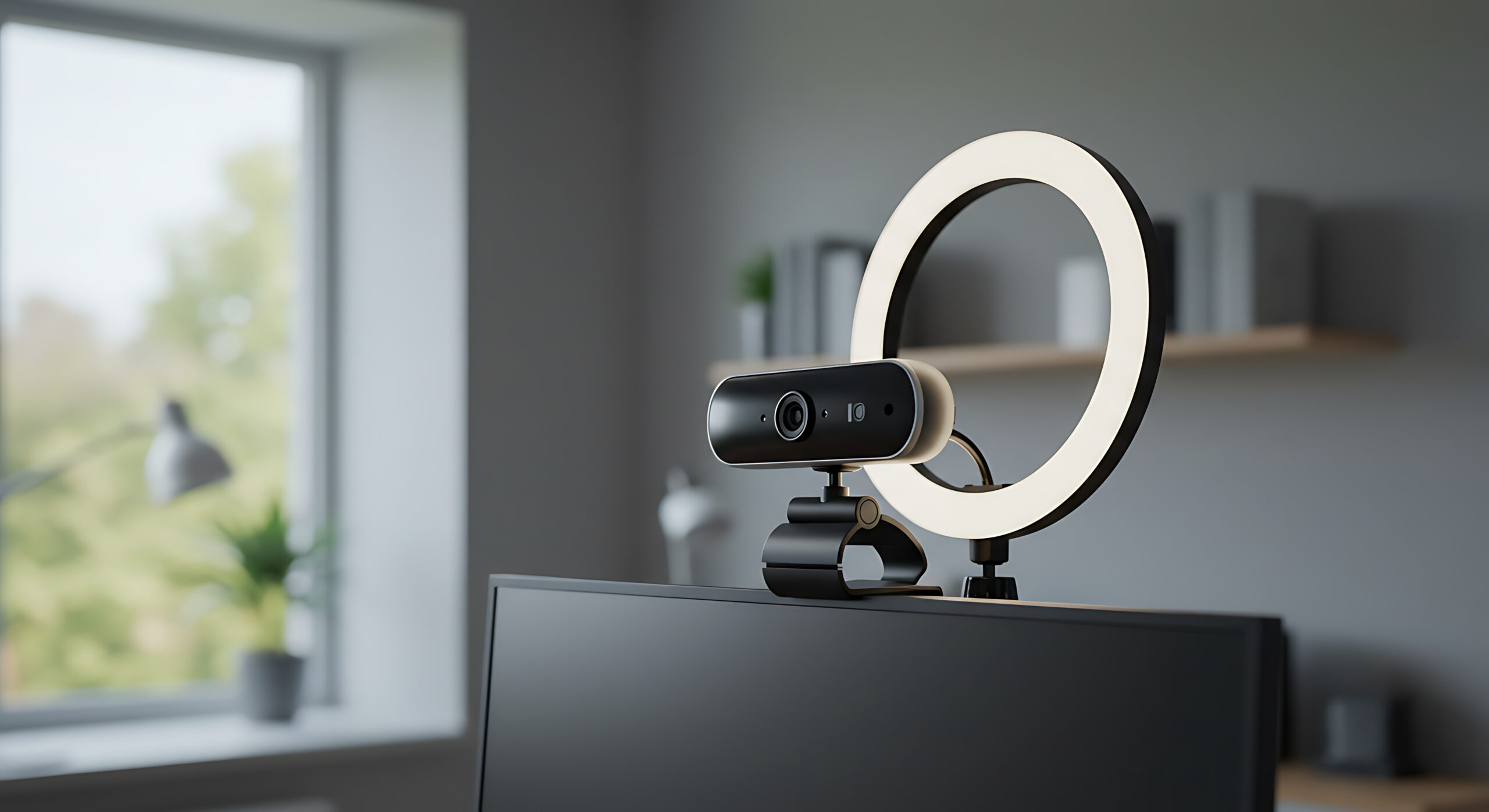
Transforming a small home office with strategic lighting doesn’t require a complete renovation or a huge budget. The key is understanding how different types of lighting work together and choosing solutions that fit your specific space and work style.
FAQ Section
What’s the minimum amount of lighting needed for a small home office?
At minimum, you need 300 lumens per square meter for general illumination, plus 400-600 lumens of task lighting at your work surface. For a typical 8×10 foot office, this translates to about 2,400 lumens total from all sources combined.
Can I use smart home technology with small home office lighting ideas?
Absolutely. Smart bulbs, switches, and plugs work with existing fixtures, making them perfect for small spaces. You can control multiple light sources from your phone, create schedules, and even sync lighting with your calendar – all without adding bulk to your office.
How do I prevent eye strain in a small, windowless office?
Layer your lighting to avoid harsh contrasts, use bulbs with high CRI (80+) for accurate colour rendering, and position lights to minimise glare. Add bias lighting behind your monitor to reduce the contrast between your bright screen and dark surroundings. Take regular breaks to rest your eyes, and consider a desk lamp with adjustable colour temperature to mimic natural light changes throughout the day.
What’s the best lighting for video calls in a small space?
Position a soft light source at eye level in front of you – a ring light or desk lamp with a diffuser works well. Avoid backlighting from windows or bright sources behind you. If space is tight, a small LED panel that clips to your monitor provides flattering illumination without taking up desk space. Aim for 3000-3500K colour temperature for the most flattering skin tones on camera.
How can I add lighting without electrical work?
Plenty of small home office lighting ideas require zero electrical work. Battery-operated LED puck lights stick anywhere and provide surprising brightness. Plug-in wall sconces eliminate the need for hardwiring. Floor and table lamps simply need an outlet. LED strips with adhesive backing run on low-voltage adapters. Even some track lighting systems now offer plug-in versions that mount to the ceiling without wiring.
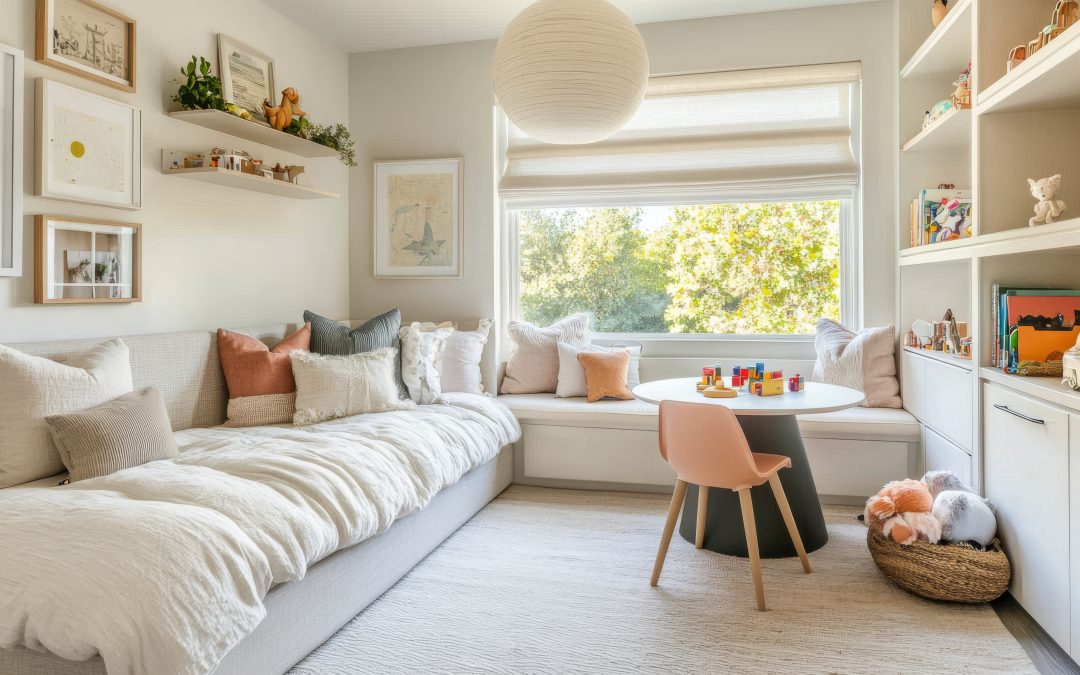
by Kesaa Interiors | DECOR & DIY, Furniture & Layout Guides, Lighting & Accessories, ROOMS, Small Space Hacks
Looking for the best tips and tricks to decorate a small bedroom for a girl? You are in the right place!
There’s something uniquely satisfying about transforming a small bedroom into a space that feels both functional and magical. When figuring out how to decorate a small bedroom for a girl, the challenge isn’t just about making things fit—it’s about creating a room that reflects her personality while maximising every square inch.
After years of designing children’s spaces, I’ve learned that small bedrooms often become the most creative and cherished rooms in a home. The constraints push us to think more intentionally about each element we include. Whether you’re working with a tiny box room or just trying to make better use of limited space, the strategies in this guide will help you create a bedroom that grows with your daughter and makes the most of what you have.
We’ll cover everything from smart furniture choices to visual tricks that make rooms feel larger, plus organisation systems that actually work in real life. Let’s dive into the practical solutions that make small bedroom design achievable and enjoyable.
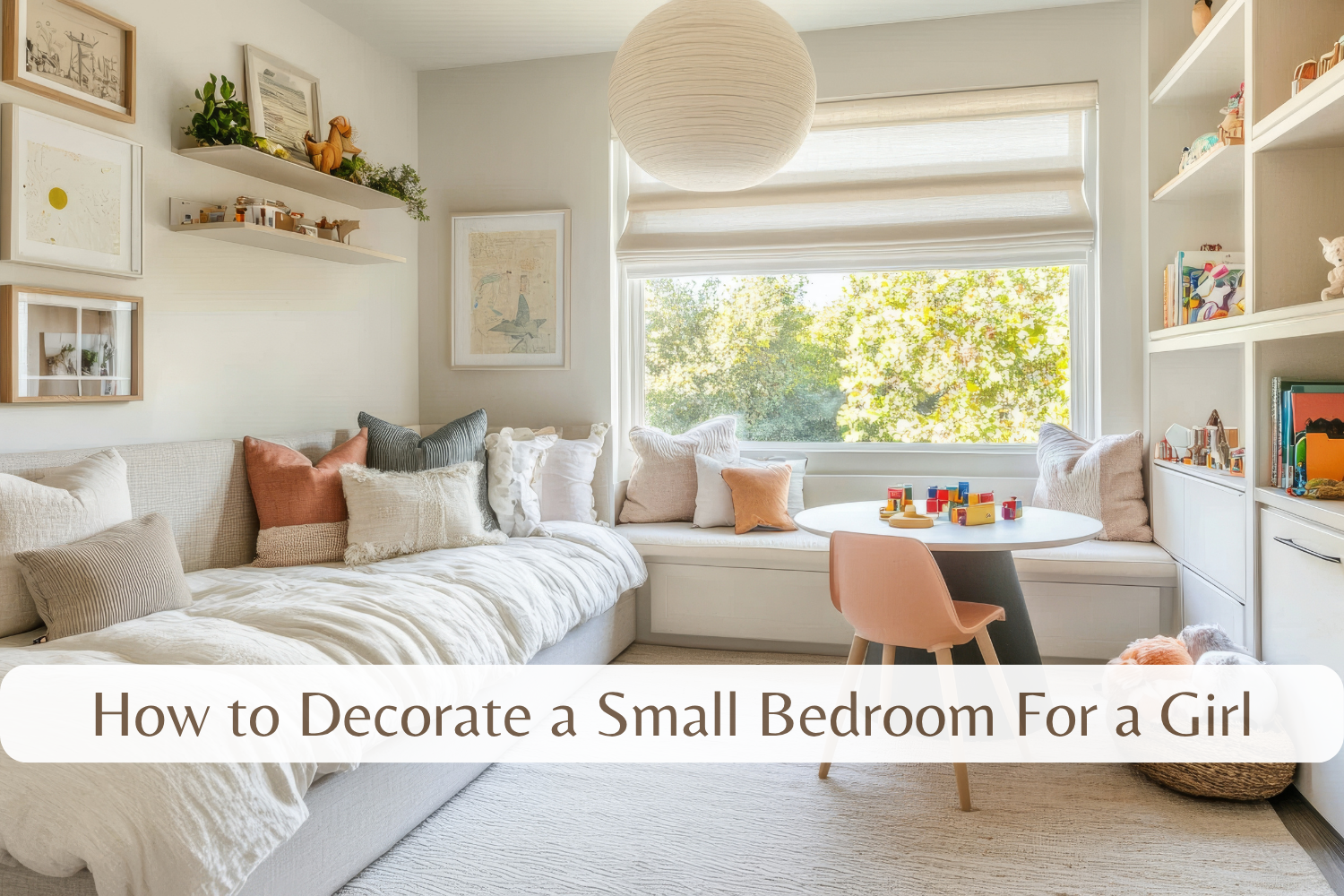
The Best Ways To Decorate a Small Bedroom For a Girl!
Understanding the Space
Before you buy a single piece of furniture or choose a paint colour, taking the time to understand your space truly will save you from costly mistakes and frustration down the road. This foundational step makes all the difference when learning how to decorate a small bedroom for a girl effectively.
Measuring and Planning
Start by grabbing a tape measure and recording every dimension—not just the floor space, but also ceiling height, window placement, and door swing. These numbers become your roadmap. I always create a simple floor plan on graph paper (or use a free online tool if you prefer digital). Mark where electrical outlets and light switches are located, as these will influence furniture placement more than you might think.
Pay special attention to any architectural quirks like sloped ceilings, alcoves, or built-in features. What might seem like an obstacle often becomes an opportunity for creative storage or a cosy reading nook. Natural light sources deserve extra consideration too—you’ll want to avoid blocking windows with tall furniture, and positioning the bed to catch morning light can make wake-ups easier.
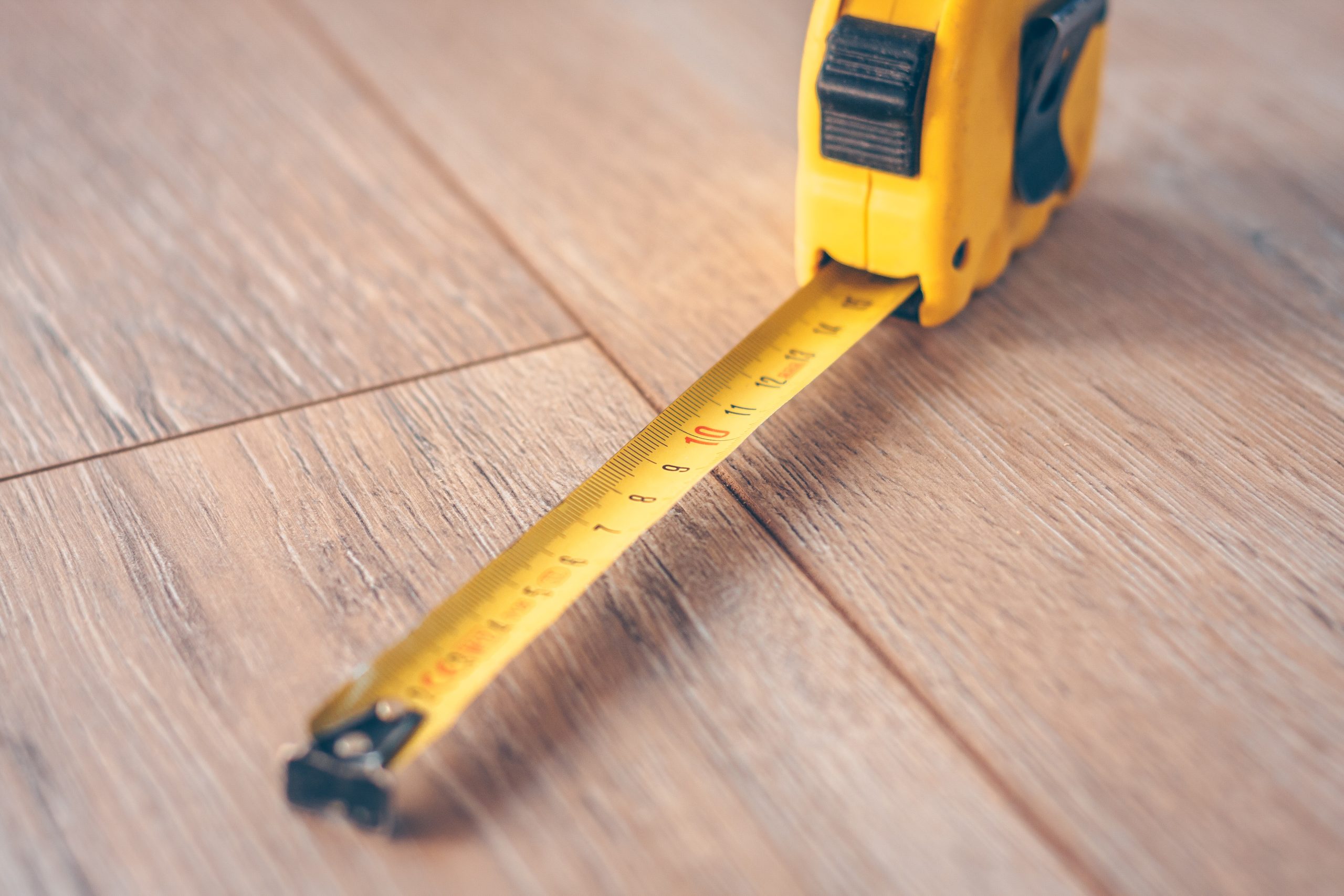
Age-Appropriate Considerations
Here’s where things get interesting. A bedroom for a six-year-old has vastly different needs than one for a teenager, yet in small spaces, we need designs that can evolve. Think about your daughter’s current stage and what’s coming next.
For younger girls (ages 4-8), floor space for play remains crucial. They need accessible storage they can manage independently—think low shelves and bins they can reach without climbing. Their clothing storage needs are relatively simple, but toy storage can quickly become overwhelming without good systems in place.
Tweens (ages 9-12) start needing more sophisticated storage for hobbies, collections, and an expanding wardrobe. Homework becomes a bigger part of life, so a proper study area moves up the priority list. They’re also developing stronger opinions about style, so flexibility in decor becomes important.
Teenagers require maximum privacy and personal expression. Storage needs shift toward clothing, accessories, and tech gadgets. Study space becomes non-negotiable, and they’ll likely want areas for socialising with friends. The key is creating a design foundation that can adapt as these needs change without requiring a complete overhaul every few years.
Consider what can stay constant (like quality furniture pieces in neutral finishes) and what can easily change (like bedding, wall art, and accessories). This approach not only saves money but also teaches valuable lessons about working within constraints—something we all face regardless of room size.
Essential Space-Saving Furniture Solutions
When square footage is limited, every furniture choice matters. The secret to mastering how to decorate a small bedroom for a girl lies in selecting pieces that work twice as hard without overwhelming the space. Let’s explore the options that deliver the most impact.
Multi-Functional Beds
The bed typically dominates any bedroom, and in small spaces, it needs to earn its footprint. Loft beds remain one of my go-to recommendations because they essentially double your usable space. The area underneath becomes prime real estate for a study zone, reading corner, or additional storage. Modern loft designs have come a long way from the basic metal frames—you’ll find options with built-in desks, shelving units, and even small wardrobes integrated into the structure.
Captain’s beds offer another smart solution, especially for younger girls who might not be ready for the height of a loft. These beds incorporate drawers directly into the base, eliminating the need for a separate dresser. The deeper drawers work perfectly for bulky items like sweaters and jeans, while smaller compartments handle socks, underwear, and accessories.
For rooms that occasionally need to accommodate sleepovers, trundle beds provide sleeping space for a guest without a permanent floor space commitment. The lower bed tucks away completely when not in use. Some trundle designs even feature drawers instead of a second mattress, giving you storage flexibility.
Wall-mounted Murphy beds might sound extreme, but in truly tiny rooms, they’re game-changers. During the day, the entire bed folds up against the wall, freeing the floor for play, study, or exercise. Modern Murphy beds often include shelving or desk surfaces that remain accessible when the bed is stored.
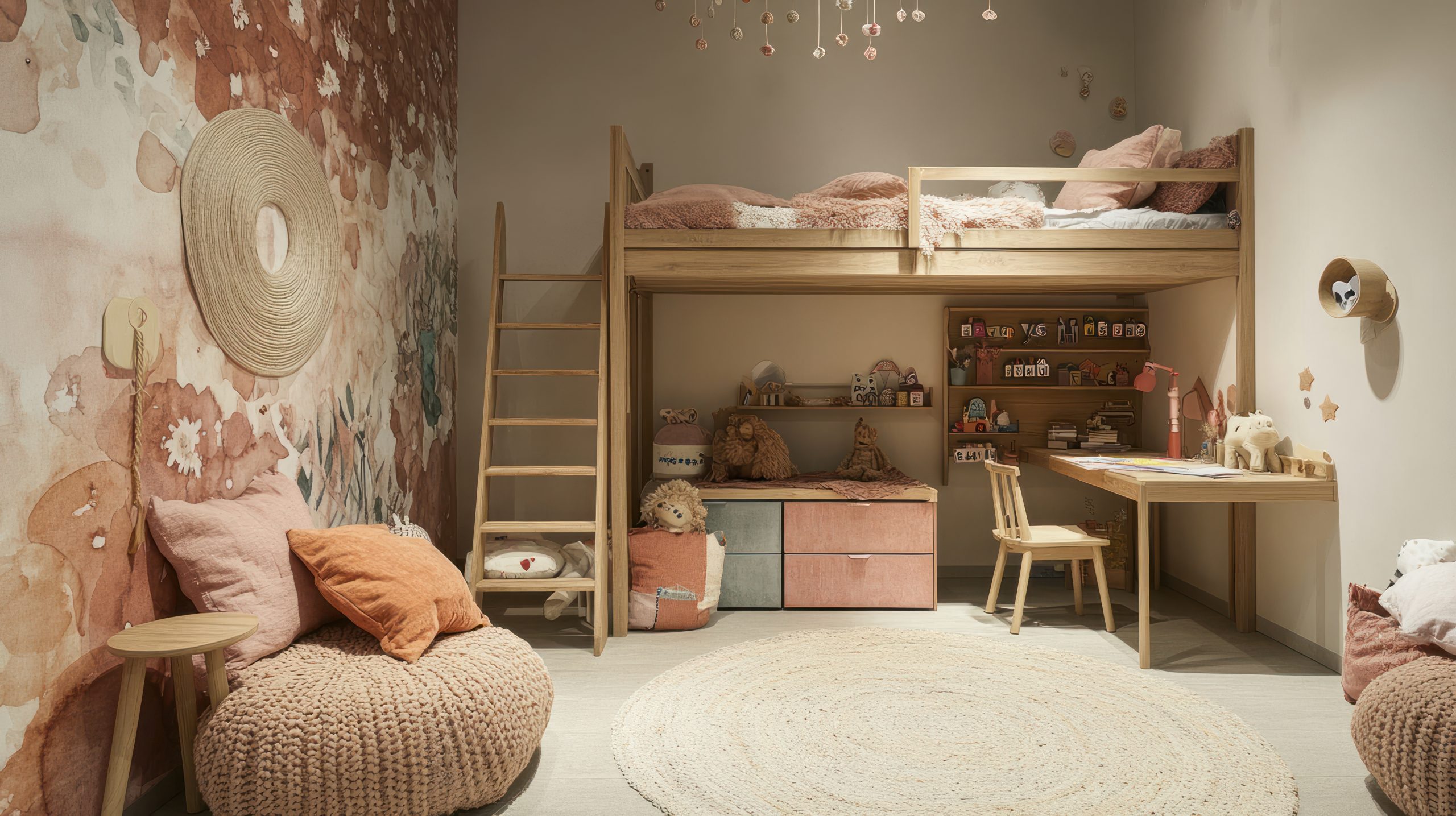
Smart Storage Solutions
Vertical space is your best friend in small bedrooms. Floor-to-ceiling shelving units maximise storage without eating up precious floor area. Open shelving works well for books and displaying items, while incorporating some bins or baskets on the shelves helps hide clutter. The key is maintaining a visual breathing room—not every inch needs to be packed.
Under-bed storage often goes underutilised. If you’re not using a captain’s bed, slide-out boxes or bins on wheels make this space easily accessible. Clear containers let you see contents at a glance, while fabric boxes maintain a softer aesthetic. Vacuum storage bags work wonders for out-of-season clothing or extra bedding.
Over-door organisers have evolved beyond basic shoe holders. You’ll find options designed for everything from hair accessories to school supplies. The back of the bedroom door can hold an incredible amount without taking up any space. Just ensure the organiser doesn’t interfere with the door closing properly.
When it comes to closets, built-in systems typically offer more efficient use of space than freestanding wardrobes. However, if you’re renting or can’t modify the existing closet, modular closet organisers can transform even the smallest closet into a storage powerhouse. Double hanging rods instantly double hanging space for shorter items like shirts and skirts.
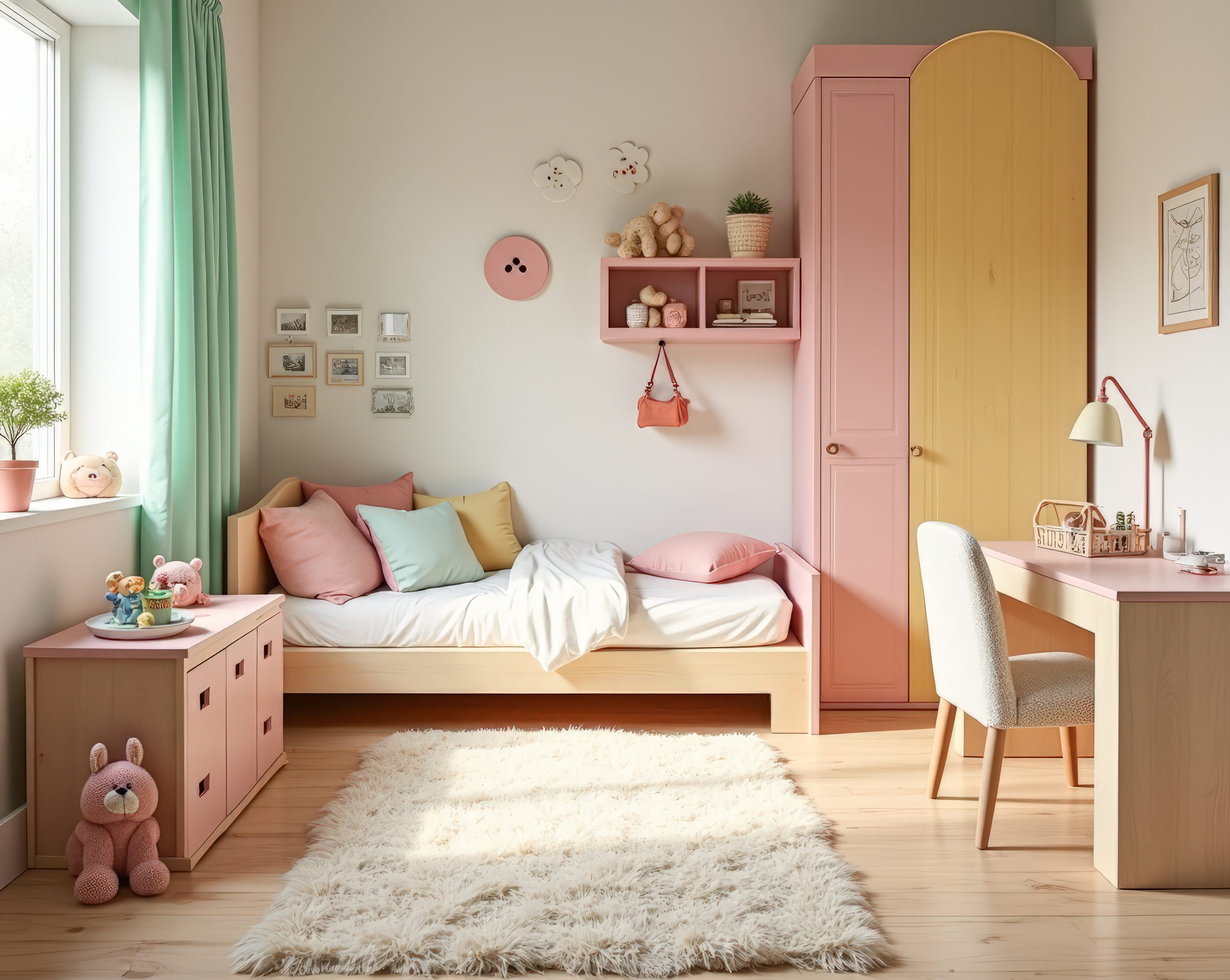
Compact Study Areas
Every girl needs a dedicated space for homework, crafts, or hobbies, regardless of room size. Wall-mounted desks provide a work surface without legs that clutter the floor. These can be as simple as a shelf with brackets or as sophisticated as fold-down units with integrated storage.
Corner spaces often go unused but make perfect study spots. L-shaped desks designed for corners maximise surface area while maintaining good traffic flow through the room. Pair with a compact, ergonomic chair that can slide completely under the desk when not in use.
For the ultimate in flexibility, consider fold-down desk options. These mount to the wall and fold flat when not needed. Some designs include small shelves or corkboards on the underside, turning the closed desk into a display area. This works particularly well in rooms where the study area needs to do double duty as a vanity or craft station.
Floating shelves above the desk area keep supplies within reach without cluttering the work surface. Install them at heights appropriate for your daughter’s reach, and consider adding small containers or desktop organisers to maintain order. Good task lighting is crucial—wall-mounted swing-arm lamps save desk space while providing adjustable illumination.
The beauty of these solutions is their adaptability. As homework needs increase through the school years, the study area can evolve without requiring major furniture changes. Start with the basics and add organisational elements as needed.
Colour Schemes and Visual Tricks
The right colour choices and visual strategies can make a small bedroom feel significantly larger and more inviting. While personal preference plays a role, understanding how colours and patterns affect our perception of space helps you make informed decisions when figuring out how to decorate a small bedroom for a girl.
Colour Psychology for Small Spaces
Light, neutral base colours remain the gold standard for small rooms—and for good reason. Whites, soft greys, and pale beiges reflect light and create an airy feeling. But this doesn’t mean the room needs to feel bland or impersonal. The trick is using these neutrals as your canvas and adding personality through accents.
If your daughter has her heart set on pink, purple, or any bold colour, there are smart ways to incorporate them without overwhelming the space. Consider painting just one accent wall in her favourite shade, or better yet, use that colour in bedding, curtains, and accessories that can easily change as her tastes evolve. Another approach is choosing muted versions of preferred colours—dusty rose instead of hot pink, or sage green rather than bright lime.
The ceiling often gets forgotten, but in small rooms, it matters. Painting it the same colour as the walls (or just slightly lighter) eliminates the visual break and makes the room feel taller. If you’re feeling adventurous, a very pale blue or lavender on the ceiling can create a dreamy, expansive effect.
Creating Visual Space
Mirrors work like magic in small bedrooms. A large mirror on one wall instantly doubles the visual space and bounces light around the room, creating a sense of depth and dimension. Position mirrors to reflect windows or attractive focal points rather than clutter. Full-length mirrors serve double duty for outfit checks while making the room feel larger.
Vertical elements draw the eye upward and emphasise height over limited floor space. This could mean floor-to-ceiling curtains (hung close to the ceiling, not just above the window), vertical striped wallpaper on an accent wall, or tall, narrow furniture pieces. The goal is to create visual lines that stretch the perception of space.
Maintaining colour flow throughout the room prevents the choppy feeling that makes spaces feel smaller. This doesn’t mean everything must match—rather, colours should relate to each other harmoniously. If the bedding features navy and coral, echo those colours in artwork, storage bins, or desk accessories.
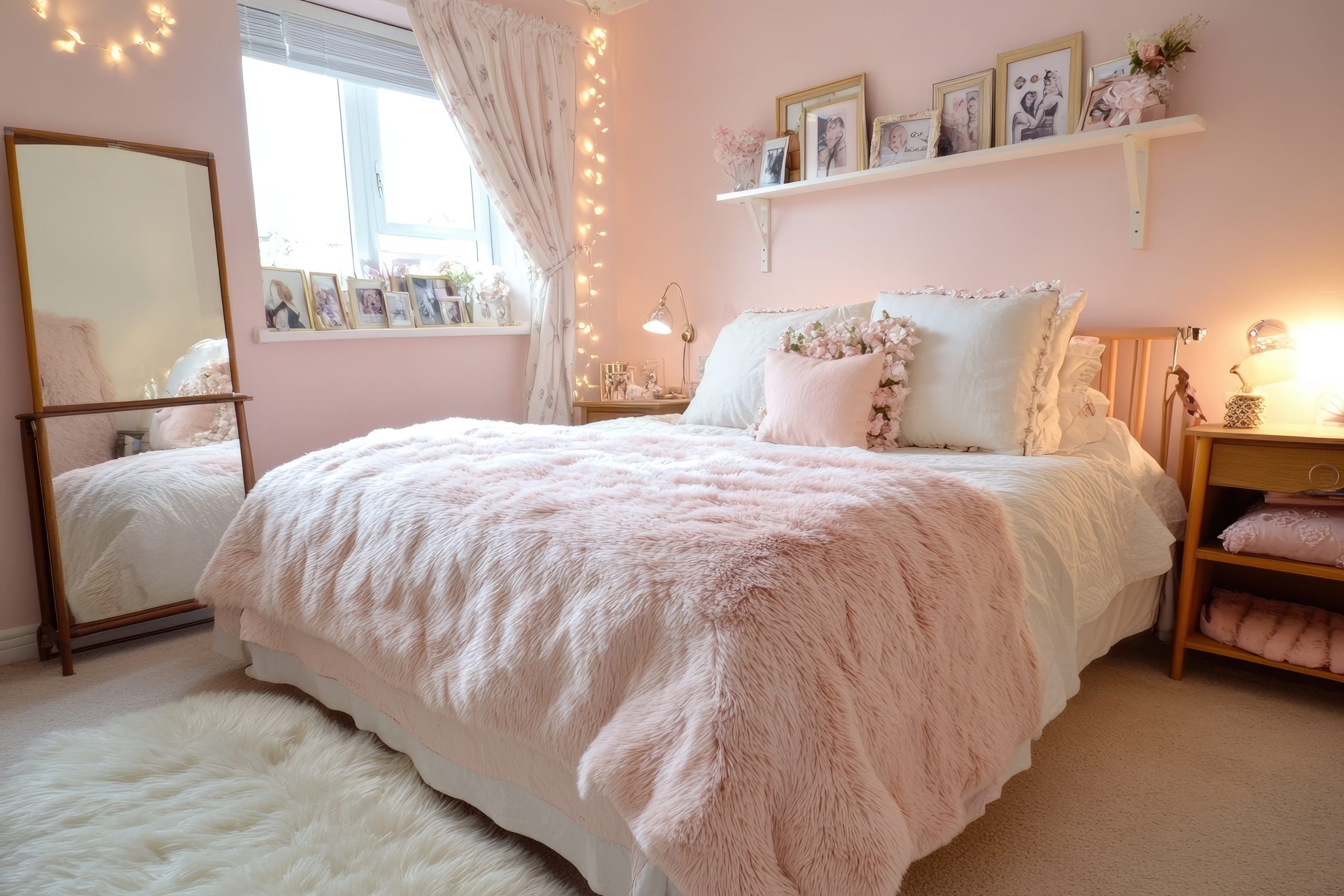
Lighting Design
Good lighting can transform a small bedroom from cramped to cosy. The layered approach works best: ambient lighting for general illumination, task lighting for specific activities, and accent lighting for the atmosphere. In small spaces, each fixture needs to multitask.
Wall sconces free up bedside table space while providing a reading light. Swing-arm styles offer adjustability without bulk. For younger girls, fun-shaped sconces (like flowers or stars) add personality without cluttering surfaces. Install them with independent switches for easy control.
String lights aren’t just for holidays—they create a magical ambience with minimal space impact. LED strips under floating shelves provide both accent lighting and subtle task lighting. Battery-operated options eliminate cord clutter and can go anywhere. Just avoid overdoing it—too many light sources can feel chaotic in small spaces.
Natural light deserves special attention. Keep window treatments simple and functional. Light-filtering cellular shades provide privacy while maximising daylight. If using curtains, mount the rod close to the ceiling and extend it beyond the window frame—this makes windows appear larger and allows maximum light when curtains are open.
Practical Decorating Strategies
Now that we’ve covered the foundational elements, let’s dive into decorating strategies that bring personality and function together. These approaches help you create a room that feels complete and intentional, not cluttered or overwhelming.
Wall Utilisation
In small bedrooms, walls become valuable real estate for both storage and self-expression. Floating shelves offer display space without the visual weight of bookcases. Arrange them asymmetrically for visual interest, mixing books with small plants, photos, and treasures. The key is leaving breathing room—aim to fill shelves only 60-70% for an organised, intentional look.
Pegboards have shed their garage workshop image and become stylish organisation solutions. Paint them to match the wall for a subtle look, or in an accent colour for pop. The beauty lies in their flexibility—hooks, shelves, and bins can be rearranged as needs change. They work brilliantly above desks for school supplies or near the door for bags and accessories.
Gallery walls let personality shine without taking up any floor space. Mix frames of different sizes, but stick to a cohesive colour scheme for the frames themselves. Include a combination of photos, artwork, quotes, and even small mirrors. The trick for small rooms is keeping the overall shape contained—a rectangular or square grouping feels more organised than pieces scattered across the wall.
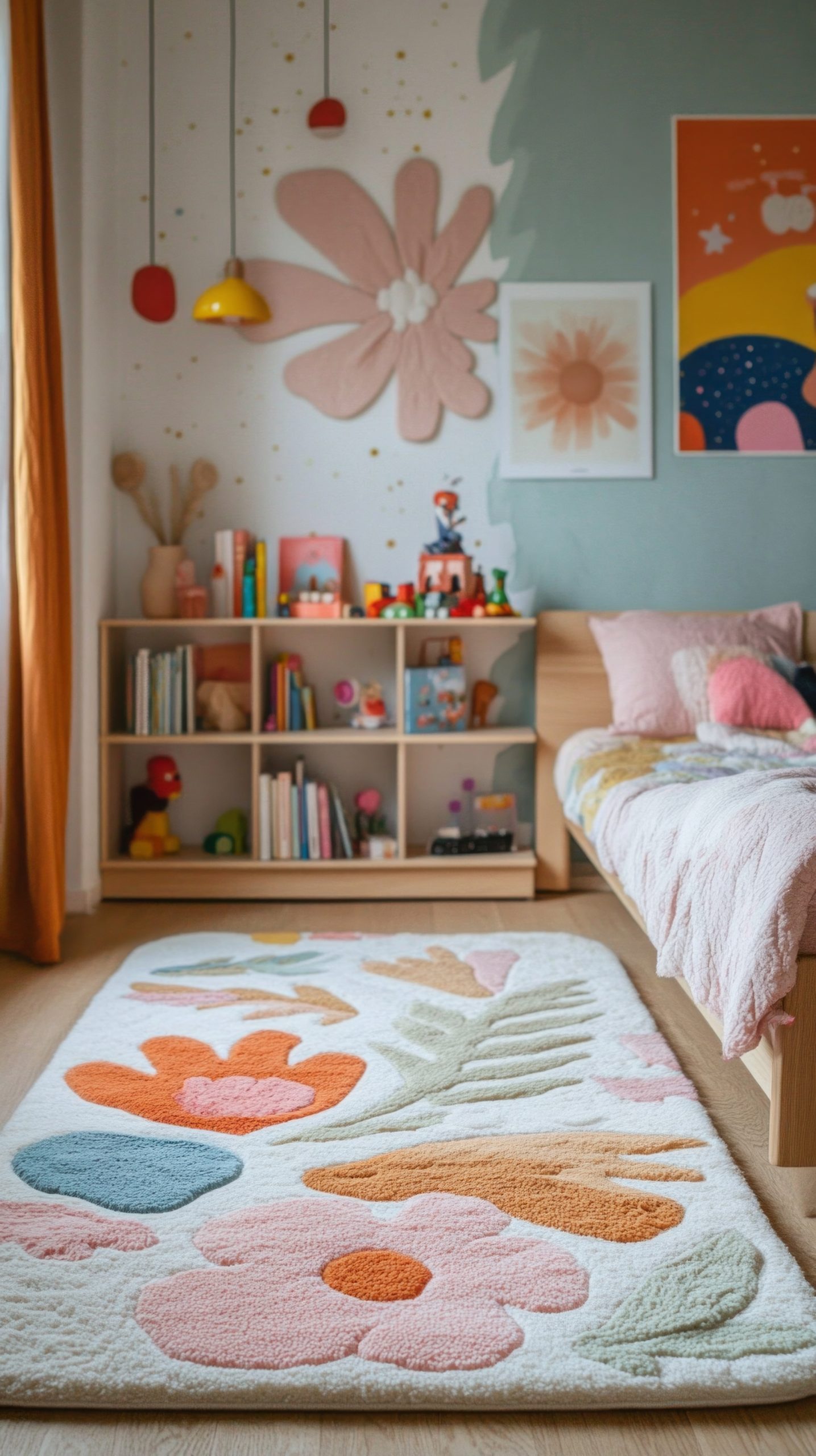
Textile Choices
Textiles offer the easiest way to update a room’s look without major investment or space commitment. In small bedrooms, they need to work harder by adding style while maintaining practicality.
Bedding sets the tone of the room, so choose wisely. Avoid overly busy patterns that can make small spaces feel chaotic. Instead, opt for simple patterns or solids with interesting textures. Layering different textures—a smooth duvet, chunky knit throw, and velvet pillows—adds visual interest without overwhelming patterns.
Window treatments affect both the room’s appearance and functionality. In small rooms, simplicity wins. Roman shades or roller blinds take up minimal space when raised. If using curtains, choose lightweight fabrics that don’t add bulk. Hanging them high and wide makes windows appear larger and maximises natural light.
Area rugs help define zones in multi-purpose rooms. In a small bedroom, one rug partially under the bed unifies the sleeping area. If space allows, a small rug in a contrasting texture can define a reading corner or play area. Just ensure rugs are properly sized—too small looks awkward, while too large can make the room feel cramped.
Personal Touches
The magic of learning how to decorate a small bedroom for a girl comes alive when you add those personal elements that make the space uniquely hers. The challenge is incorporating personality without creating clutter—every item should feel intentional and special.
Displaying collections requires creative thinking in small spaces. Instead of spreading items across multiple surfaces, create one impactful display area. Shadow boxes work wonderfully for small treasures like shells, pins, or tiny figurines. Floating shelves with picture ledges let her rotate artwork and photos without committing to nail holes. For larger collections, consider displaying only favourites and storing the rest in pretty boxes that can be switched out seasonally.
Rotating displays keep the room fresh without accumulating clutter. Create a simple system—perhaps a clipboard wall where new artwork can easily replace old, or a wire grid with clips for photos and mementos. This approach lets her room evolve with her interests without requiring major changes or additional storage.
DIY projects add personality without overwhelming small spaces. Focus on projects that enhance existing elements: decorating plain storage boxes, creating custom drawer pulls, or painting a design on the back of a bookshelf. These touches feel special without adding bulk to the room.
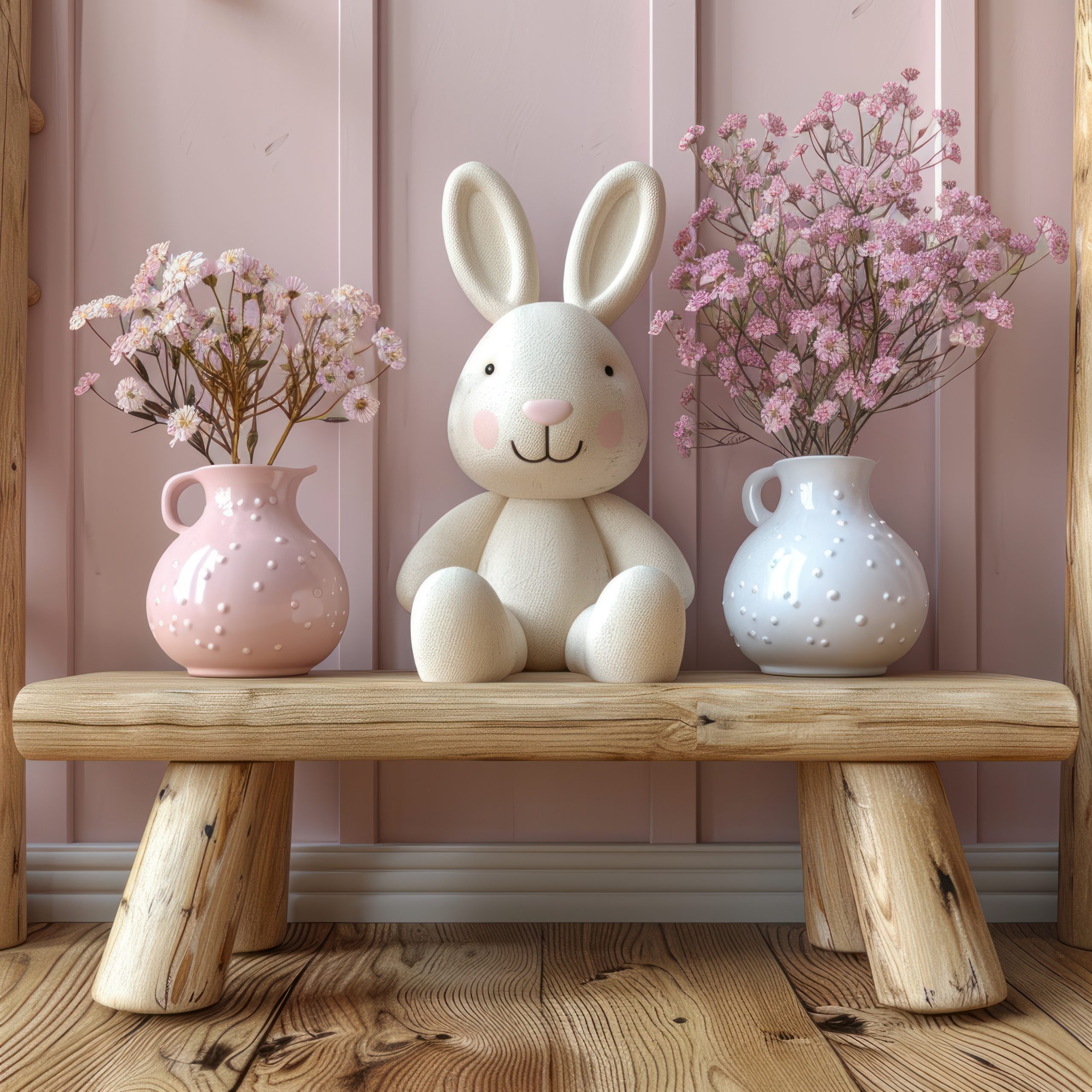
Organisation Systems That Work
Even the best design falls apart without solid organisation. In small bedrooms, systems need to be simple enough for daily use yet flexible enough to grow with changing needs.
Closet Maximisation
Most small bedrooms come with equally small closets, but smart organisation can triple their capacity. Start by installing double hanging rods—one high, one low. This immediately doubles hanging space for shorter items like shirts, skirts, and folded pants. Use the floor space for a small shoe rack or storage boxes.
Closet organiser systems don’t require major renovation. Affordable options include hanging shelves, over-the-rod baskets, and cascading hangers. The key is creating designated spots for different categories: school clothes, weekend wear, and special occasions. This makes morning routines smoother and helps maintain order.
Seasonal rotation keeps closets manageable. Store out-of-season clothing in vacuum bags under the bed or on high closet shelves. This practice not only frees up prime closet real estate but also teaches valuable lessons about living with less and caring for belongings.
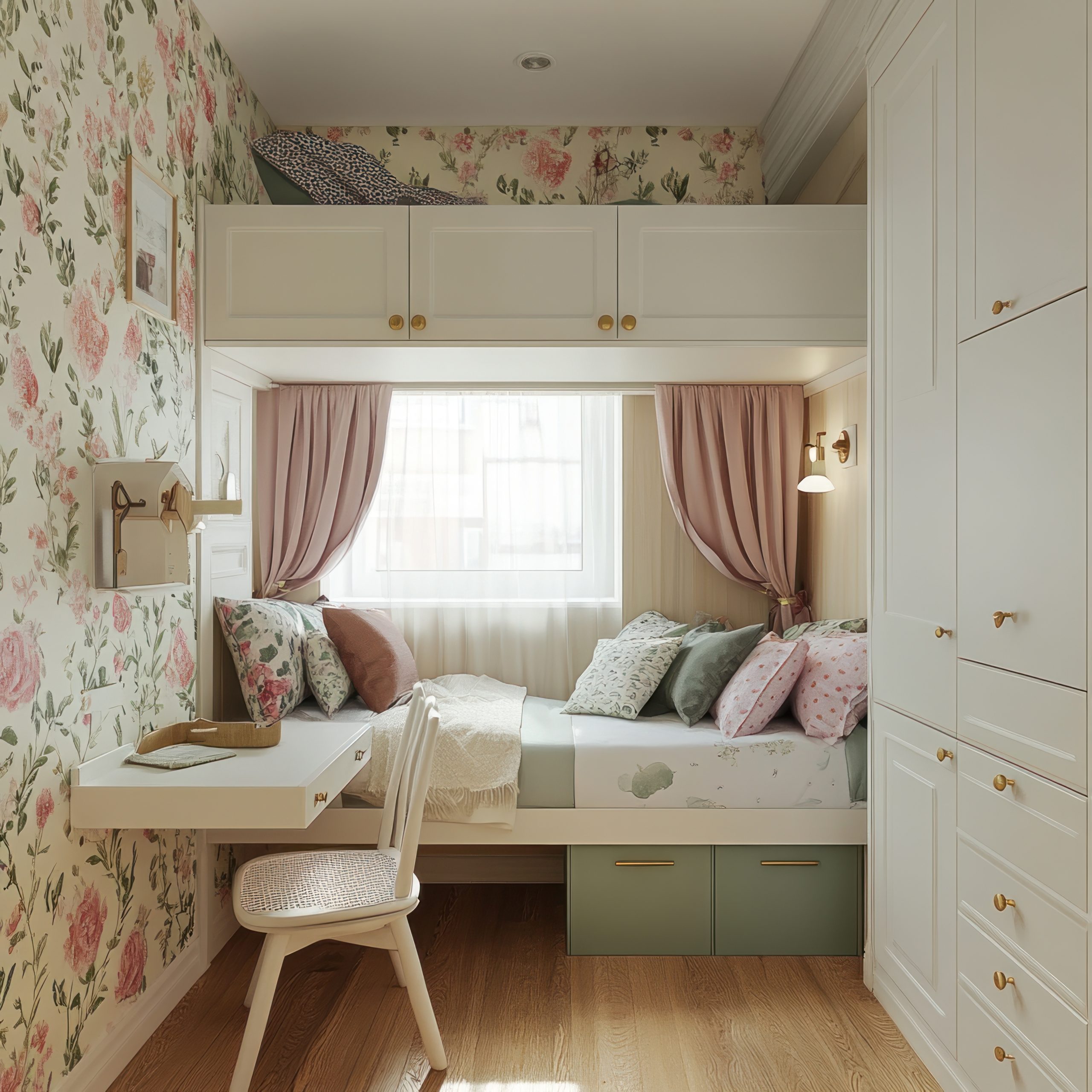
Daily Organisation
The difference between a room that stays tidy and one that constantly feels chaotic often comes down to simple daily systems. Every item needs a home, and that home needs to make sense for how the item gets used.
Create drop zones for everyday items. Hooks near the door for backpacks and jackets prevent pile-ups on the floor. A small tray on the desk corrals hair ties, lip balm, and other pocket items. These designated spots should require minimal effort—if it’s complicated, it won’t stick.
Homework stations need clear organisation to support good study habits. Desktop organisers keep pens and pencils accessible but contained. Magazine files work perfectly for organising papers by subject. A simple inbox/outbox system helps track assignments and prevent important papers from getting lost in the shuffle.
Morning routines run smoother with planning. Consider setting up a small station with outfit planning in mind—hooks for tomorrow’s clothes, a basket for accessories, a mirror for final checks. This reduces morning stress and keeps the rest of the room tidier.
Maintaining Order
The best organisational system fails without buy-in from its users. Age-appropriate methods make maintenance more likely. Younger girls respond well to picture labels and colour coding. Tweens might prefer prettier labels or chalkboard tags that they can update. Teenagers usually want systems that look more sophisticated—think minimalist labels or no labels at all if categories are clear.
Weekly resets prevent small messes from becoming overwhelming. Pick a consistent time—Sunday evenings work well—for a quick tidy session. This isn’t deep cleaning, just returning items to their homes and doing a quick declutter. Making it routine removes the drama and keeps the room functional.
Involve her in creating and maintaining systems. When she helps decide where things go, she’s more likely to keep them there. This also provides natural opportunities to reassess what’s working and what needs adjustment as her needs change.
Budget-Friendly Implementation
Creating an amazing small bedroom doesn’t require an unlimited budget. Smart planning and strategic choices can deliver high impact without breaking the bank.
Priority Investment Pieces
When budgets are tight, knowing where to splurge versus save makes all the difference. Quality matters most for items that see daily heavy use: the bed frame, mattress, and desk chair. These pieces should last through years of growth and use. A solid wood bed frame might cost more initially, but it will outlast several board versions.
Save money on elements that can easily change: bedding, curtains, wall art, and decorative accessories. These items let you update the room’s look as tastes change without major expense. Storage bins, picture frames, and desk accessories from budget retailers work just as well as expensive versions.
Consider the long view when making purchases. That trendy-shaped bookshelf might seem perfect now, but will it still work in three years? Neutral, classic pieces in quality materials provide better value over time.
DIY Solutions
Some of the best small bedroom solutions come from creative DIY projects. Repurposing existing furniture saves money and often yields more personalised results. An old dresser can become a desk by adding a wood top. Basic bookshelves transform into built-in-looking storage with crown moulding and paint.
Simple projects can have a major impact. Paint one wall with chalkboard paint to create an ever-changing art display. Use washi tape to create removable wall designs. Build simple floating shelves from boards and brackets. These projects let her participate in creating her space while keeping costs down.
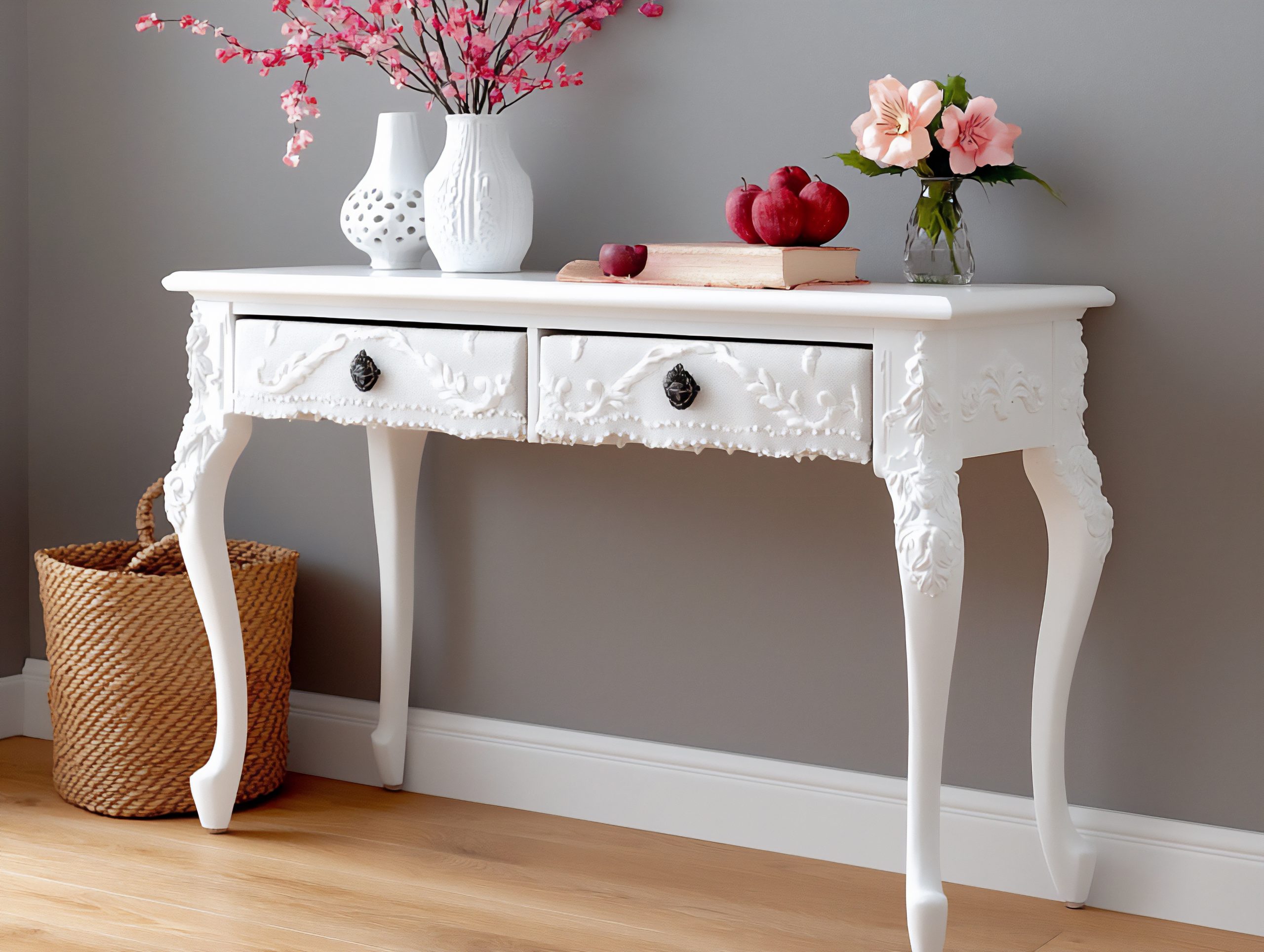
Shopping Smart
Timing purchases strategically can yield significant savings. Back-to-school sales offer great deals on desk accessories and organisation supplies. End-of-season clearances provide opportunities to stock up on bedding and decor. Black Friday, Boxing Day and End of Year sales typically offer the best prices on bedroom furniture.
Measure everything twice before purchasing. Nothing wastes money faster than furniture that doesn’t fit or function as expected in the actual space. Keep measurements on your phone for unexpected shopping opportunities.
Consider alternative sources: online marketplaces for gently used furniture, wholesale clubs for storage solutions, and craft stores for DIY supplies. Sometimes the perfect piece comes from unexpected places.
Room Layout Examples
Seeing how these principles apply to specific room configurations helps visualise possibilities for your own space. Let’s look at common small bedroom layouts and how to maximise each one.
The 8×10 Bedroom Layout
This classic small bedroom size presents clear challenges but also opportunities. The key lies in choosing appropriately scaled furniture and arranging it to maintain flow. Place the bed along the longest wall, ideally opposite the door, for the best sight lines. A twin or small full bed leaves room for other essentials.
In this layout, a corner desk maximises floor space while providing an adequate work surface. Wall-mounted shelves above the desk keep supplies handy without cluttering. A tall, narrow dresser fits better than a wide one, and over-door hooks handle daily-use items like robes and bags.
Traffic flow matters intensely in tight spaces. Ensure there’s a clear path from the door to the bed and desk. At least 24 inches of walkway prevents that cramped feeling and makes cleaning easier.
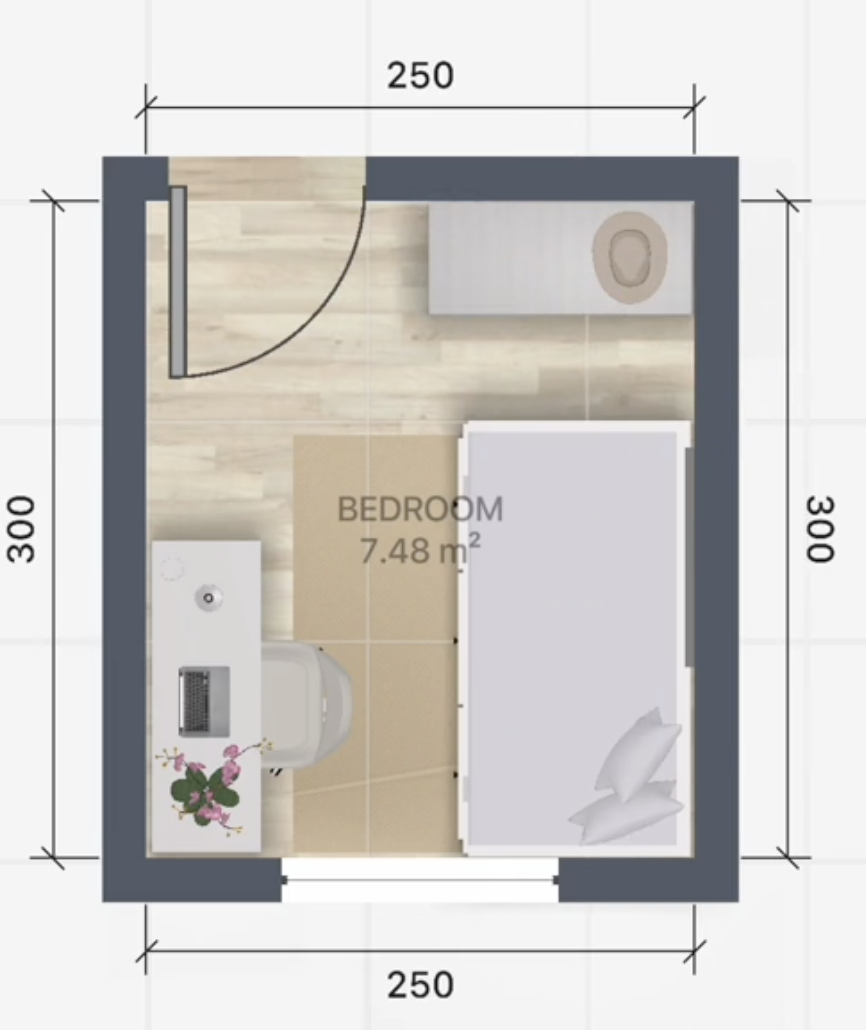
The Long Narrow Room
Narrow rooms require different strategies than square ones. Avoid lining all furniture along the walls like a bowling alley—this emphasises the tunnel effect. Instead, create zones that break up the length.
Place the bed at one end, perhaps with a low bookshelf at its foot to create separation. Use the middle section for a study area or reading nook. The far end might hold a dresser or play area. This arrangement creates distinct spaces within the room.
Horizontal elements help counteract the narrow feeling. A horizontal stripe on one wall, curtains hung wider than the window, or a row of pictures at eye level all help the room feel less corridor-like.
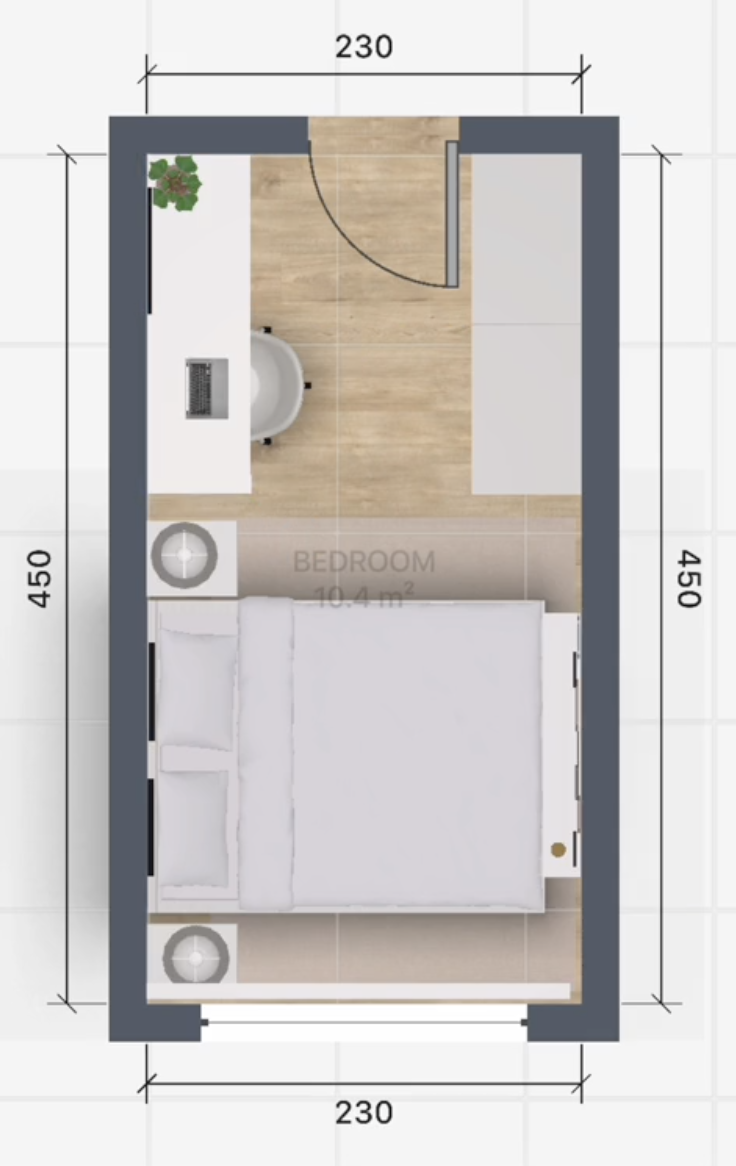
Rooms with Sloped Ceilings
Attic bedrooms and rooms with sloped ceilings require working with, not against, the architecture. Place the bed where the ceiling height is lowest—you don’t need full height for sleeping. This leaves higher areas for activities requiring standing room.
Built-in storage along knee walls maximises otherwise awkward spaces. Custom solutions aren’t always necessary—low bookshelves or storage cubes often fit perfectly. Use the highest part of the room for a desk or dresser where standing access matters.
These rooms often feel cozy rather than cramped when decorated thoughtfully. Embrace the unique architecture with strategic lighting that highlights interesting angles. Paint sloped ceilings the same colour as walls to minimise choppy feelings.
Creating a beautiful, functional small bedroom for a girl isn’t about having more space—it’s about using existing space intelligently. Throughout this guide, we’ve explored how to decorate a small bedroom for a girl using practical strategies that work in real life, not just in magazines.
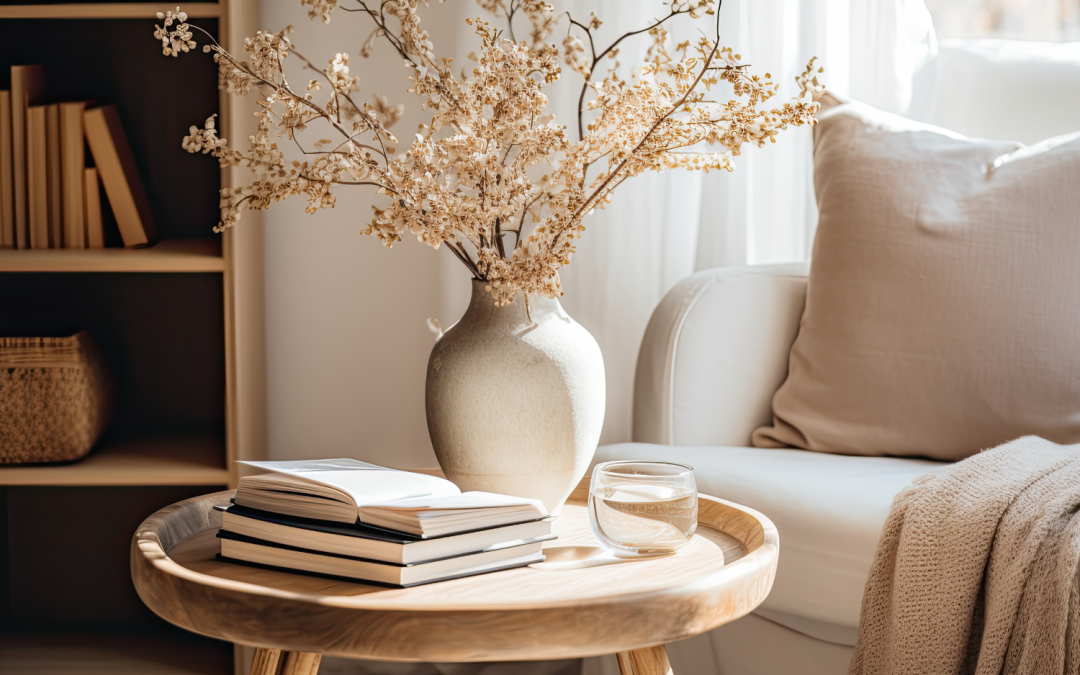
by Kesaa Interiors | DECOR & DIY, Lighting & Accessories, Living Room, ROOMS
Want to know the best way to elevate your living room table decor? These are the ultimate tips to help you elevate and transform the look and feel of your living room through decor. 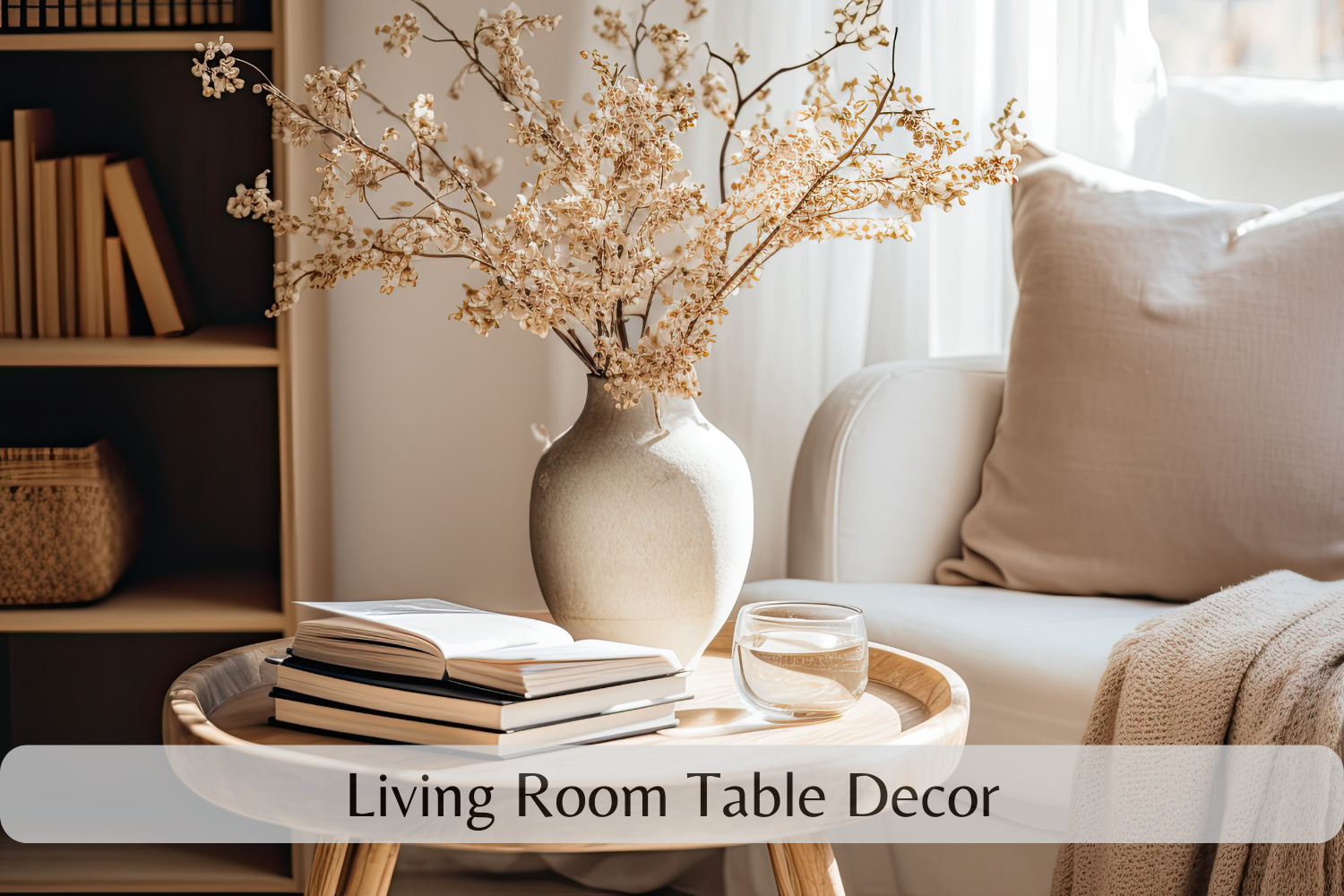
Picture this: You walk into a beautifully designed living room, and your eyes are instantly drawn to the elegant arrangement on the coffee table. It’s a colour, texture, and style masterpiece, effortlessly tying the entire room together. That’s the magic of living room table decor – it can serve as a focal point for the room and a place to showcase your personal style.
From choosing a theme, selecting styling and decorative objects and keeping functionality in mind, this post is your ultimate guide to bringing your living room together.
This post is about achieving the best living room table decor.
Best Living Room Table Decor Tips
1. Start With A Blank Canvas
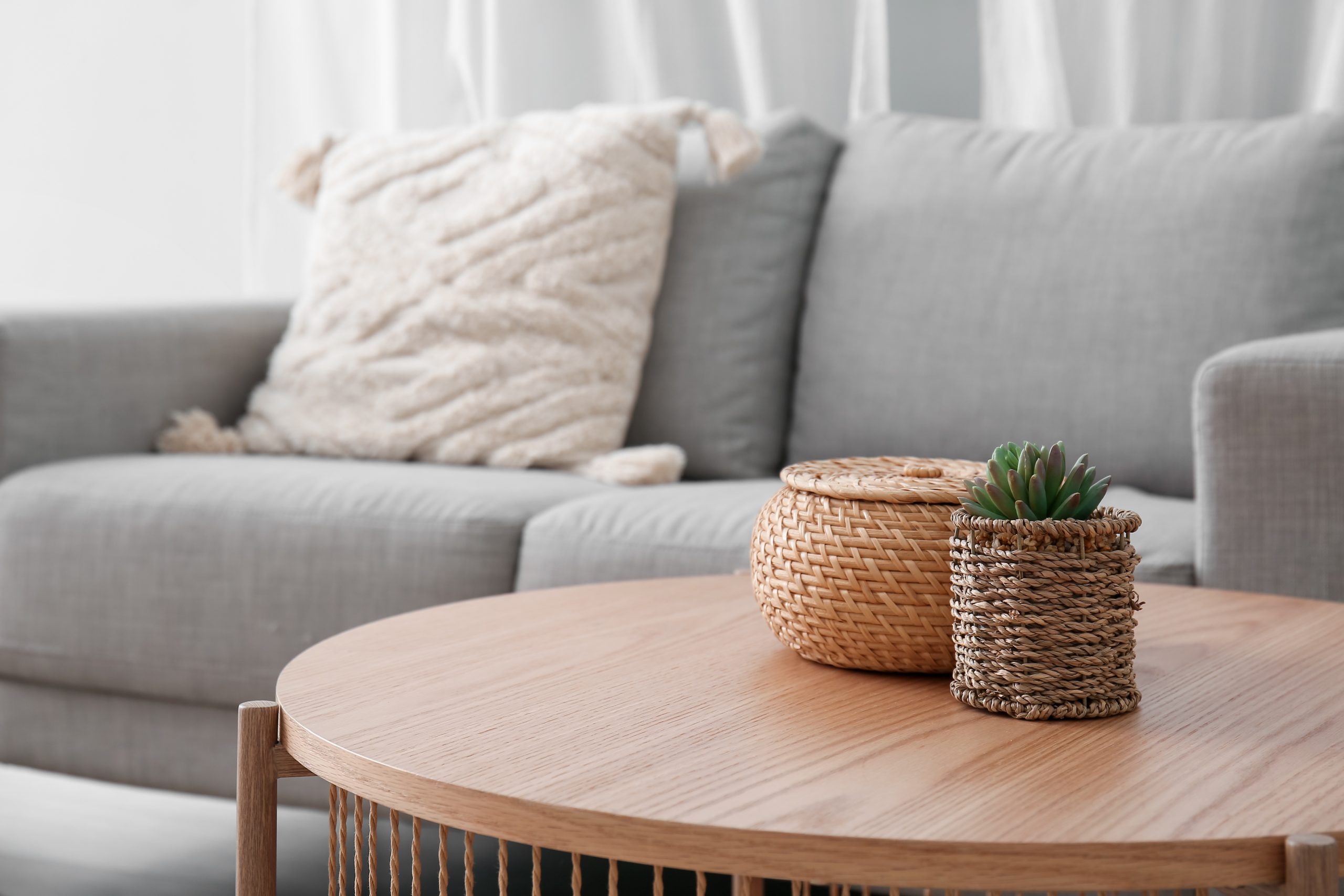
The first step to creating stunning living room table decor is to start with a blank canvas. A cluttered table can be visually overwhelming and distract from the decor’s intended theme. Starting with a clean slate provides visual clarity and lets each decorative element stand out.
Start by removing all items from your table, this includes remote controls, magazines, coasters and any other items used daily. Take this opportunity to declutter and consider whether all the items you removed are essential, if not, find homes for the things that don’t belong on your table.
2. Choose A Theme
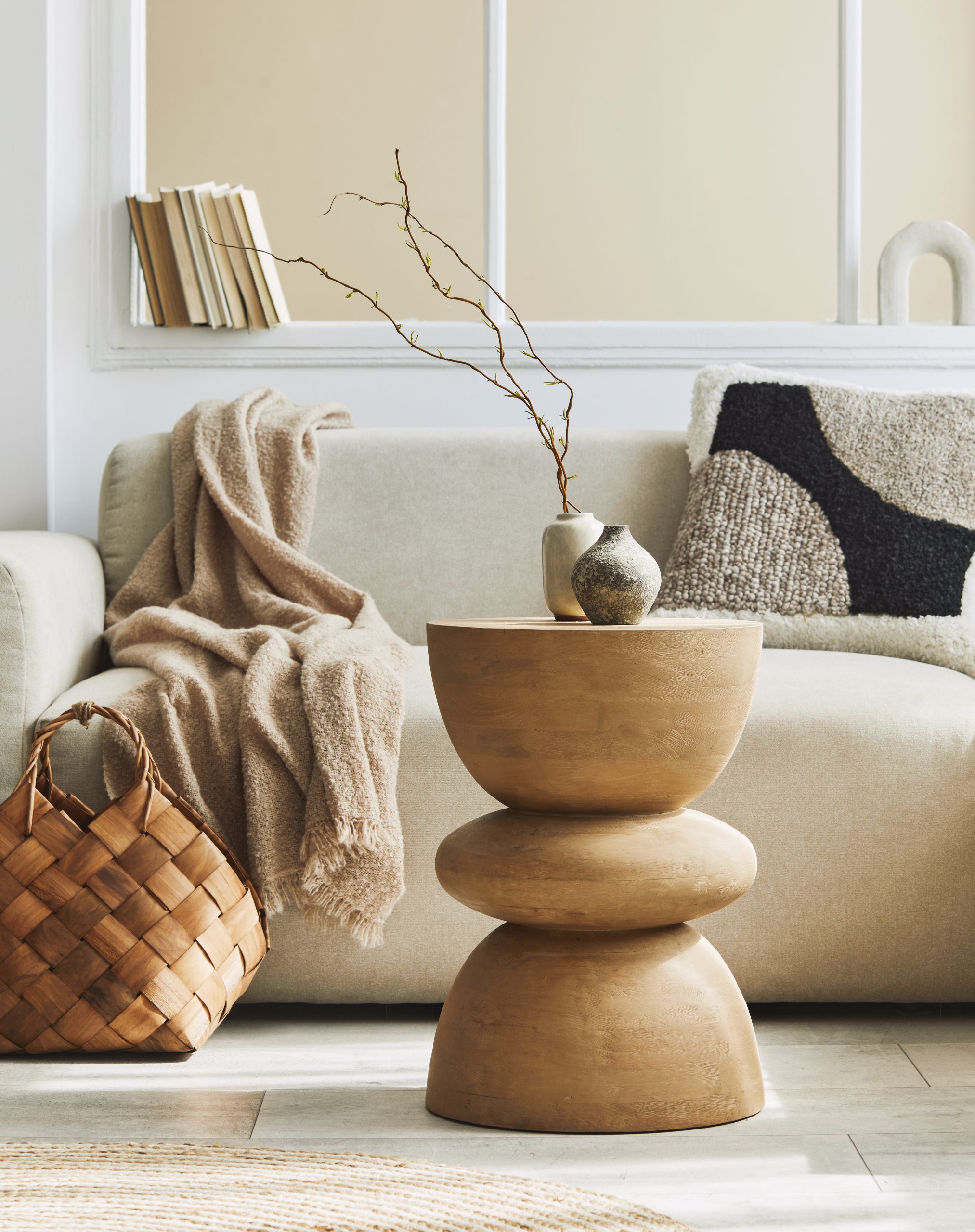
Choosing a theme sets the foundation for your entire decor arrangement, making sure that your living room table tells a cohesive and visually appealing story. Start by considering your personal style and the style of your living room, your theme should reflect your taste and the overall ambience you want to create.
Think about how the living room is used and look around your space for any existing elements or colours that you want to incorporate. Your theme should align with your room’s purpose, is it primarily a cosy family space, a formal entertainment area, or a multi-purpose room?
3. Think About Functionality
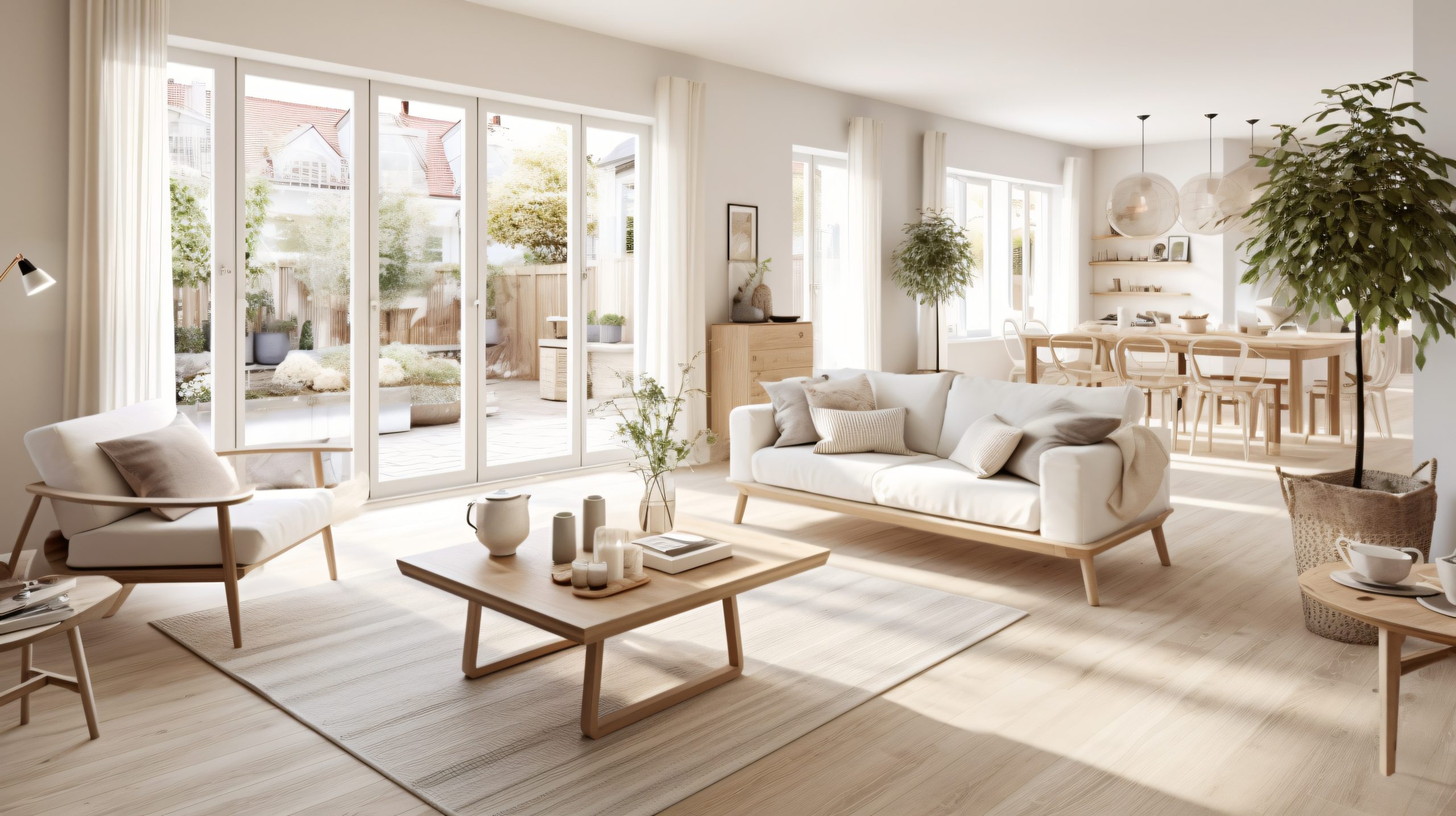
Your living room table should be more than just a surface for displaying pretty objects. It should serve a purpose to make your life easier and more enjoyable. A functional table can adapt to various needs from a coffee table for casual gatherings, a dining table for TV dinners, a workspace for your laptop, and even a storage solution for everyday essentials.
While it’s important to create a beautiful and stylish living room table, it’s also important to consider functionality. Make sure you leave enough space for drinks and snacks, and choose decor that won’t get in the way of everyday use. You can also use decorative objects and keep your living room table organised.
4. Add Your Personal Touch
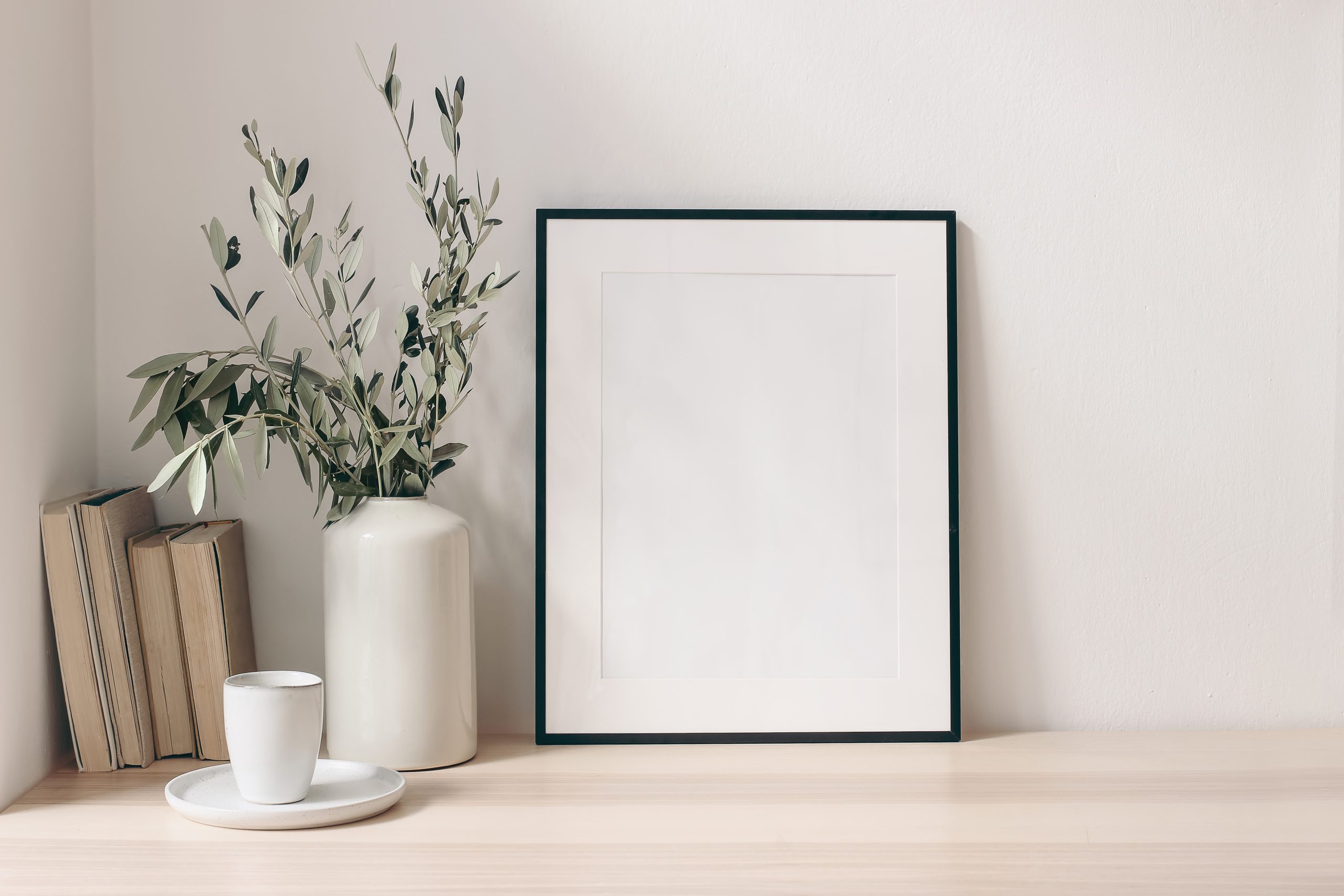
Each item on your living room table should have a story to tell so begin by selecting items that hold significance for you. The goal is to create an emotional connection with your living room table decor. Every time you glance at a particular item, it should invoke a feeling, memory, or a sense of nostalgia.
These could be family photographs, travel souvenirs, heirlooms or mementos from special occasions. To maintain a harmonious balance in your decor, blend your personal items with other decorative elements that work with your chosen theme. For instance, you can place a family photograph in an elegant frame positioned alongside decorative candles, a vase of fresh flowers or a stack of coffee table books related to your interests.
5. Stick To A Colour Palette
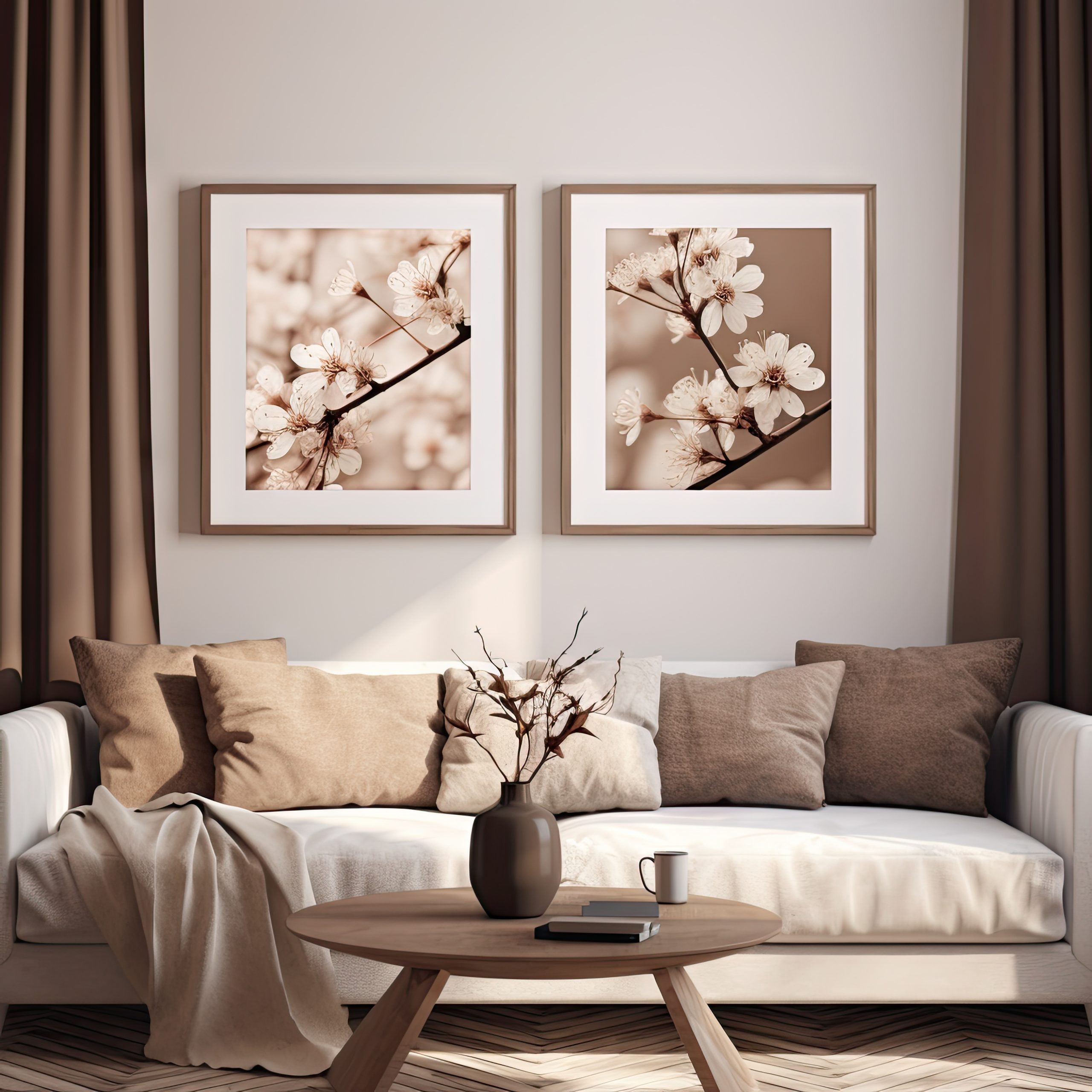
When it comes to living room table decor, your colour palette sets the tone for the entire room. One of the advantages of sticking to a cohesive colour palette is the visual consistency it provides. To ensure a seamless integration, take into account the existing colour scheme in your living room. Your table decor should not compete but complement the colours present in your room.
A well-thought-out colour palette is not just about paint and fabric. Texture plays an integral role in creating depth and interest in your living room table decor. Blend different materials like wood, glass, metal, and ceramics to add visual interest to your setup. The variety in textures will make your colour palette feel richer and more engaging.
6. Layering Your Pieces
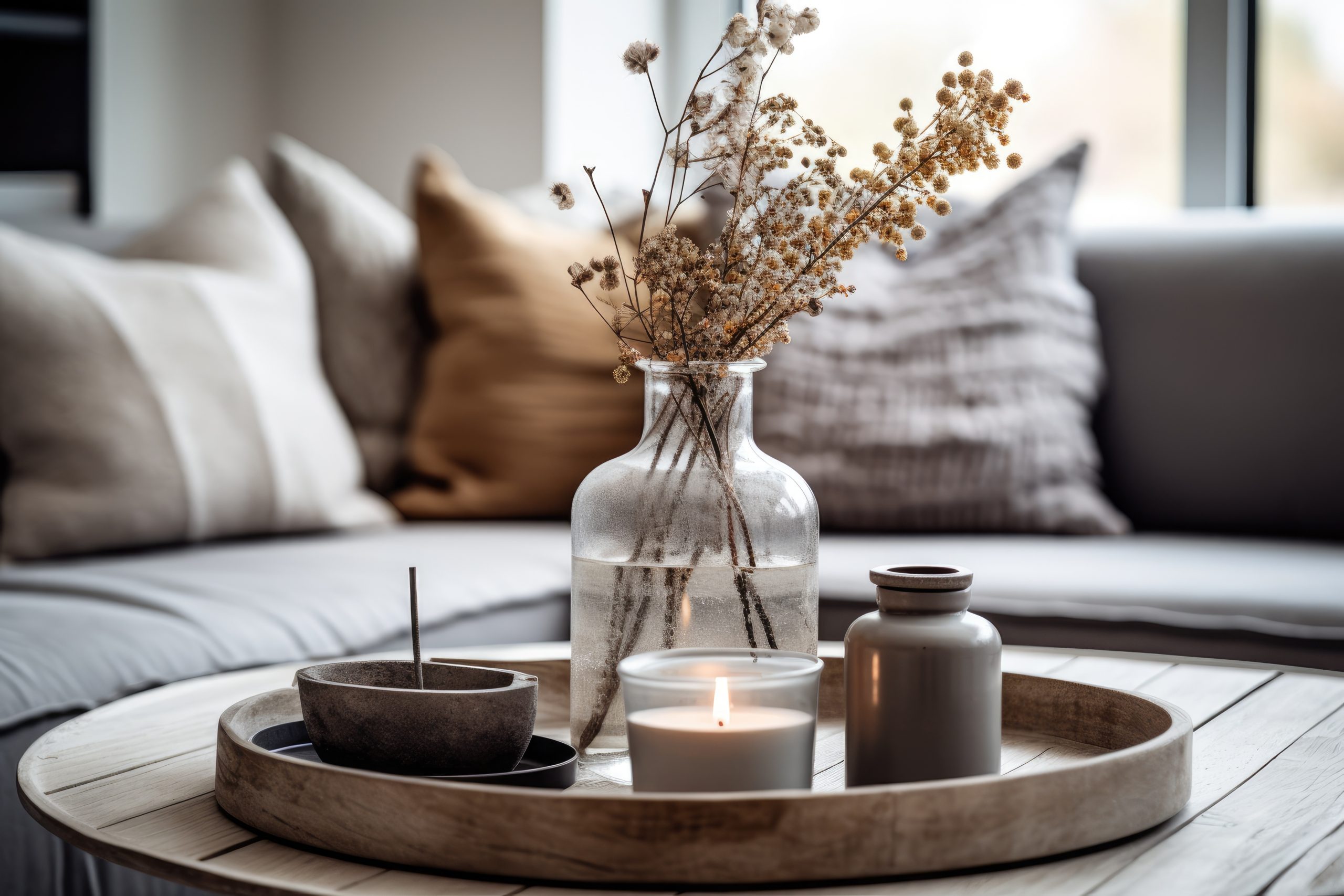
Layering will add depth, texture, and visual interest to your table, preventing it from looking flat and one-dimensional. It allows you to showcase your personality and tell a story through carefully selected items and pieces that have meaning to you.
Every beautifully layered design starts with a strong foundation, which In this case your foundation is the table itself. Consider the size, shape, and material of your table when selecting pieces. Layers can be built vertically by using vases, flowers and candles, and horizontally using decorative bowls, coasters and other decorative objects.
7. Creating Balance & Symmetry
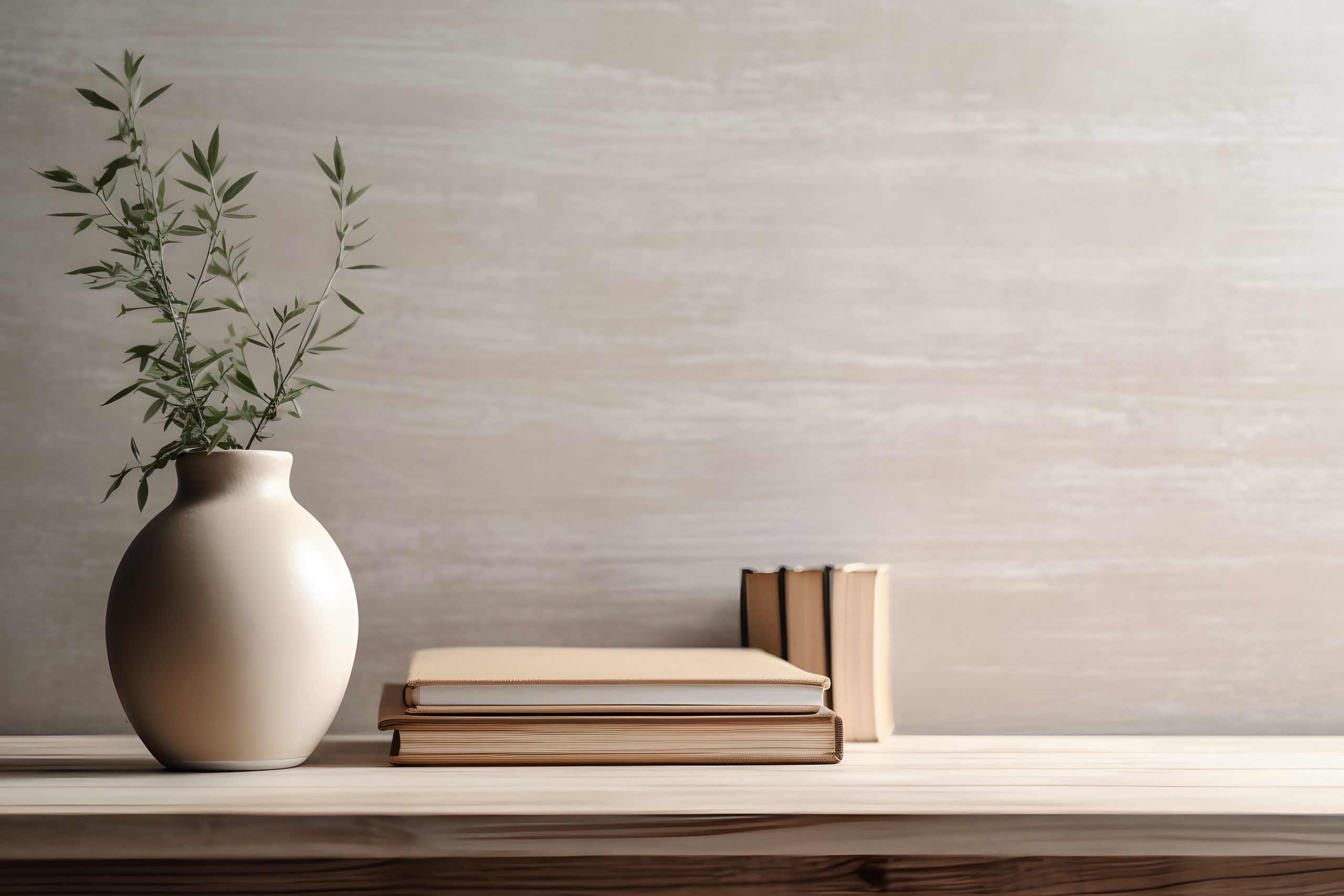
Balance & symmetry is a powerful design concept that can transform your space. By selecting the right table, arranging decor elements with symmetry and paying attention to height and colour, you can create a beautiful and balanced living room table. A square or rectangle table works well with a more structured and symmetrical decor approach, while a round or oval table can soften the look for a more organic feel.
To achieve balance, it’s essential to consider the height and visual weight of the items you choose, layering different heights and textures adds depth and dimension to your decor. It’s common to have a central focal point, this could be a large centrepiece or a captivating piece of artwork. A well-balanced and symmetrical living room table should also consider colour harmony, which can help achieve a sense of balance.
8. Add Greenery
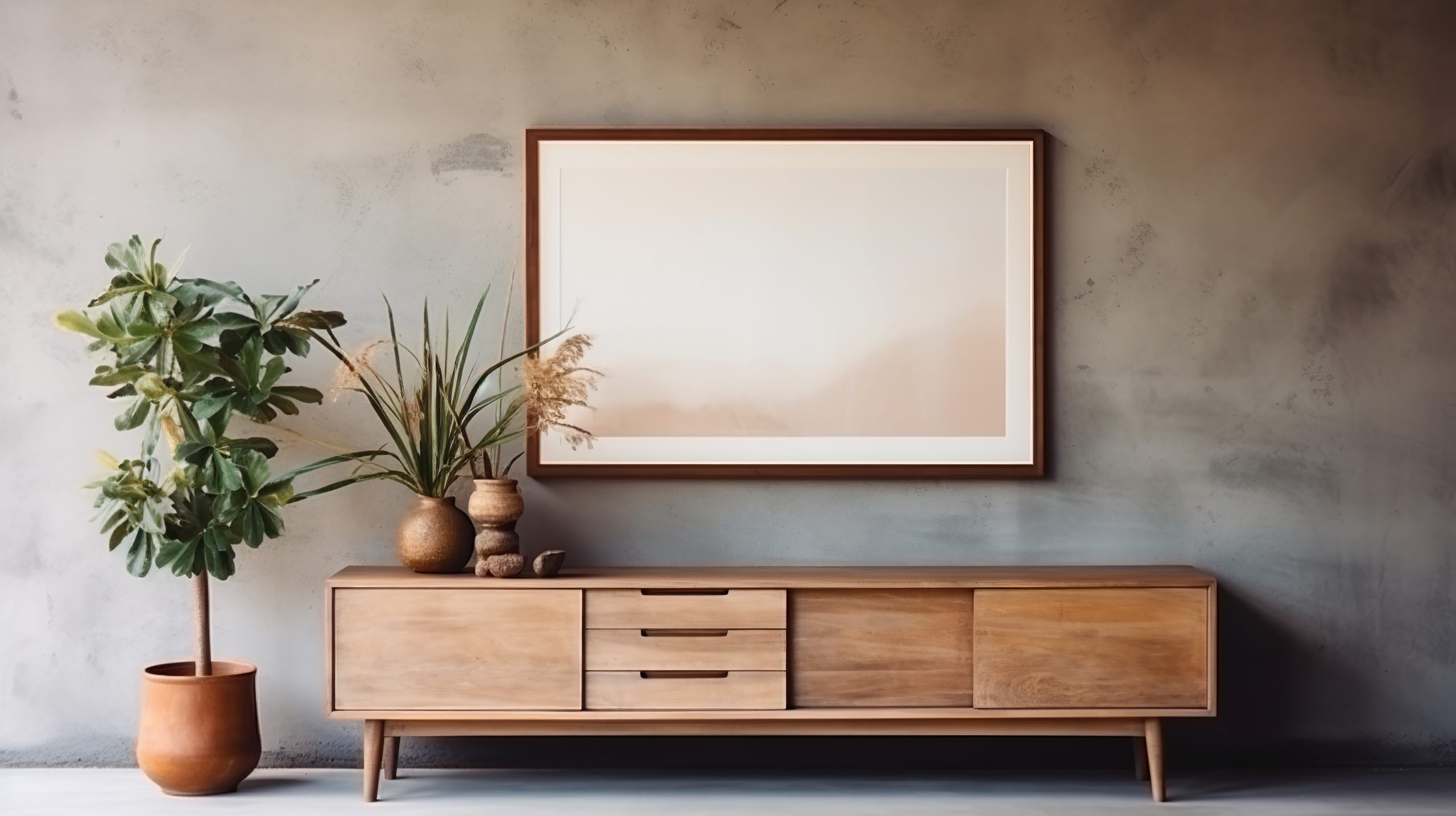
One of the most effective ways to infuse life and vibrancy into your living room table decor is by incorporating greenery. Indoor plants not only add a touch of nature but also breathe fresh air into your space, and transform the ambience of your living room, making it feel more inviting, relaxed, and visually appealing.
They provide a natural, organic element that balances the often man-made materials in your living room, while the vibrant colours of the leaves create a visually pleasing contrast against the typical furniture and decor. When selecting plants for your living room table decor, consider factors such as lighting, care requirements, and the aesthetics of your space. Elevate your greenery with decorative planters that match your decor style. Vintage containers, geometric pots, or metallic finishes can add character to your display.
9. Style With Books
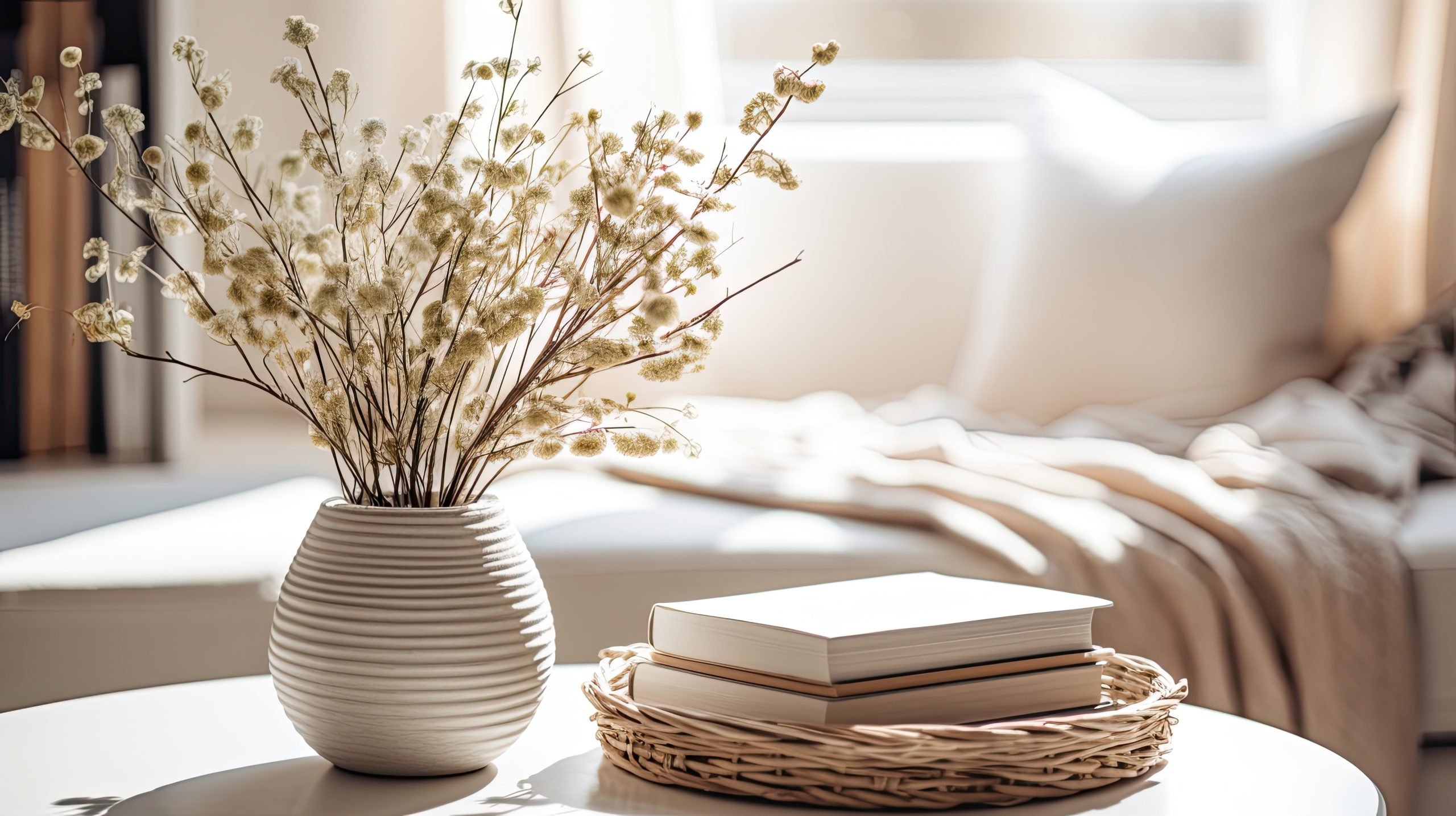
Before you begin arranging your living room table with books, consider the purpose you want them to serve. Books can be more than just decorative objects; they can also provide entertainment and information.
The selection of books is crucial when styling your living room table, so try to opt for books that resonate with your interests, hobbies or the overall theme of your living space. Books work beautifully when paired with decorative objects. Add vases, candles, or small sculptures that harmonise with your chosen books. This mixture of textures and elements creates a balanced and inviting look.
10. Edit & Rotate
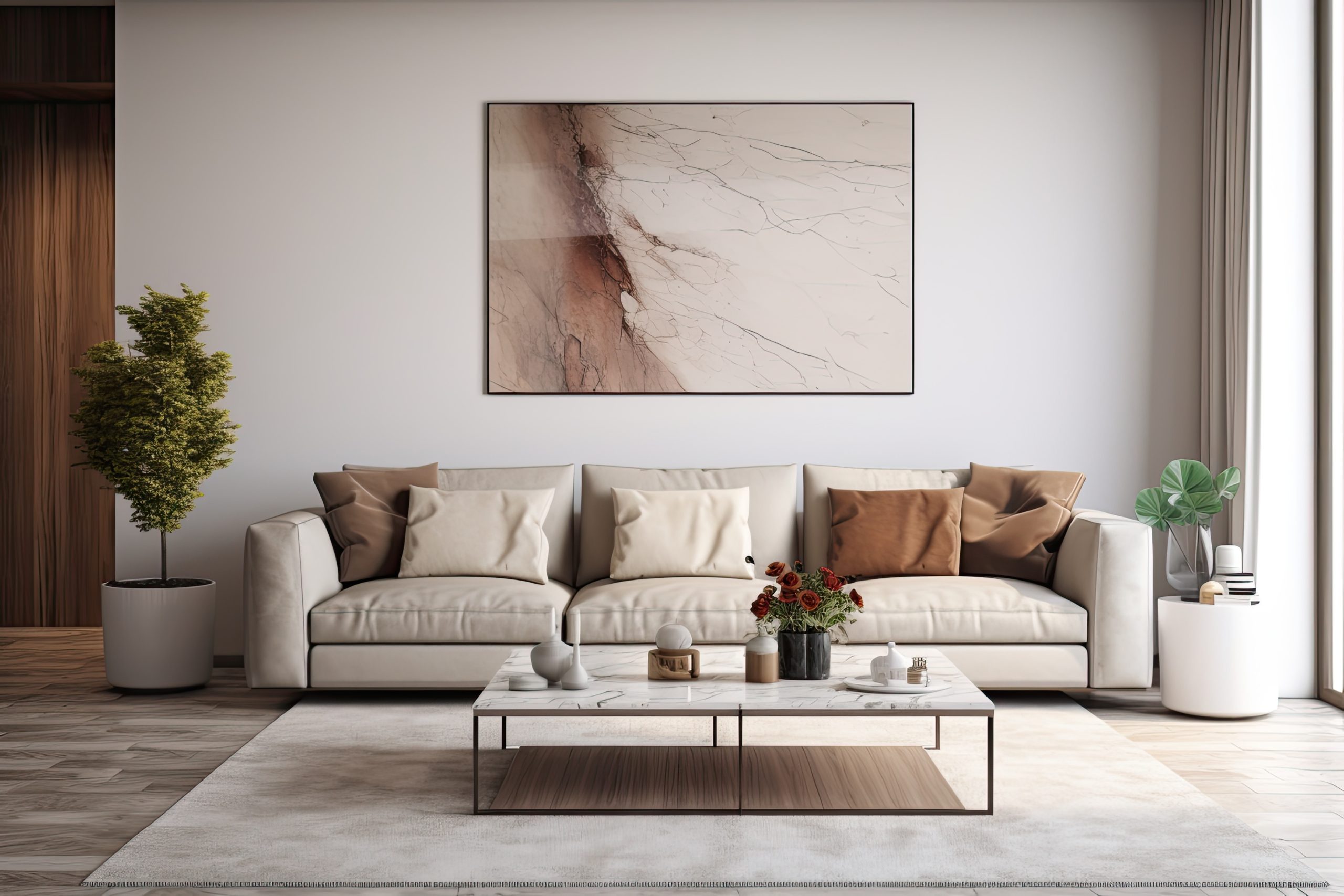
Mastering the art of editing and rotating your living room table decor is the key to achieving an ever-evolving and captivating space. By carefully curating your decor items and periodically refreshing your table setup, you can transform your living room into a dynamic and visually appealing showcase of your style and personality.
When it comes to living room table decor, remember: less is more. An important step in editing is decluttering. Start by removing any items that no longer serve a purpose or don’t contribute to the overall aesthetic of your living room. One of the joys of table decor is the ability to reflect the changing seasons and holidays. Embrace the art of rotation by updating your living room table to suit different times of the year.
11. Follow Your Intuition
Living room table decor is an art that goes beyond following strict rules. It’s about following your intuition, embracing your unique style, and creating a space that reflects your personality. By listening to your inner designer, you can transform your living room table into a captivating centrepiece that tells your story and makes your home a true reflection of you. So trust your instincts, get creative, and watch your living room table decor come to life in a way that’s perfect for you.
This post was all about giving you the ultimate tips for mastering living room table decor.



























